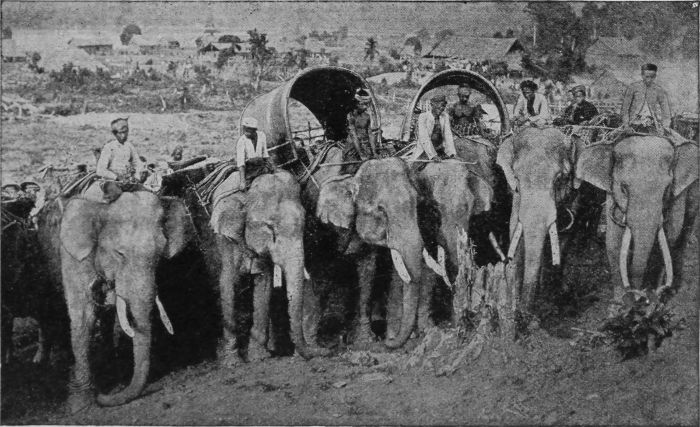
Reproduced by permission of The Philadelphia Museums.
Transport Elephants, Perak, Federated Malay States
Title: Home Life in All Lands—Book III—Animal Friends and Helpers
Author: Charles Morris
Release date: July 1, 2020 [eBook #62537]
Most recently updated: October 18, 2024
Language: English
Credits: Produced by MFR, Karin Spence and the Online Distributed
Proofreading Team at https://www.pgdp.net (This file was
produced from images generously made available by The
Internet Archive)
Home Life in All Lands
SIXTH IMPRESSION
HOME LIFE IN ALL LANDS
By CHARLES MORRIS
BOOK I
HOW THE WORLD LIVES
"It is the most intimate, and gives us the best idea of the ordinary life of these strange people to whom our author introduces us. The volume is both interesting and valuable in an unusual degree. A capital book for school or home."
—The School Journal, New York.
One hundred and twelve illustrations. 316 pages.
BOOK II
MANNERS AND CUSTOMS
OF UNCIVILIZED PEOPLES
"Excellent for school or home use. This volume deals with the manners and customs of uncivilized peoples. The illustrations are well chosen and the style is admirable."—Providence Journal.
One hundred illustrations. 322 pages.
BOOK III
ANIMAL FRIENDS AND
HELPERS
Fully illustrated. 340 pages.
J. B. LIPPINCOTT COMPANY
PUBLISHERS PHILADELPHIA

Reproduced by permission of The Philadelphia Museums.
Transport Elephants, Perak, Federated Malay States
BY
CHARLES MORRIS
Author of "Historical Tales," "History of the World,"
"History of the United States," etc.
Book III.
ANIMAL FRIENDS AND HELPERS
ILLUSTRATED
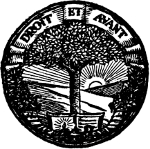
PHILADELPHIA & LONDON
J. B. LIPPINCOTT COMPANY
COPYRIGHT, 1911, BY J. B. LIPPINCOTT COMPANY
PRINTED IN UNITED STATES OF AMERICA

In the earlier volumes of this series, man, as the maker of and dweller in the home, was dealt with in the varied aspects of his existence. But man is not the only occupant of the home. He has brought around him an interesting family of animals of great variety in form and habit, many of them kept as pets and companions, many aiding him in his sports and his labors, others supplying him with meat, milk, butter, eggs and other forms of food. It is a varied and active sub-family of the household, the barnyard and field with which we here propose to deal, its inmates varying in size from the lordly elephant to the busy bee, and in intelligence from the wide-awake dog to the stupid sheep, a multitude of running, flying, and swimming forms brought together from every domain of nature and serving man in a hundred ways.
The full story of this wider family of the home would be a long one. These humbler animals have a life of their own as interesting in its way as that of man, their master and friend. We cannot tell it all in the small space at our command, but the little we have here brought together concerning the varieties and habits of our household animals must have some considerable degree of interest to readers. This is especially the case with the many stories that can be told of their powers of thought and special habits and modes of action, and the reader will find here many striking anecdotes of animal intelligence selected out of the multitude that are on record. The story of the whole animal kingdom is pleasing and instructive, and that of the domestic animals, those which have come under man's special care, is specially so, as it is hoped the readers of this work will discover. Illustrations have been secured from a large variety of sources, a number, picturing the rarer animals, being reproduced from "Chambers' Encyclopedia."

| CHAPTER | PAGE | |
|---|---|---|
| I | Household Pets and Comrades | 13 |
| The Dog, Man's Faithful Friend | 15 | |
| The Many Kinds of Dogs | 19 | |
| Anecdotes of Dog Wit and Wisdom | 29 | |
| The Cat, our Fireside Inmate | 42 | |
| Other Four-Footed Pets | 52 | |
| II | Our Single-Hoofed Helpers | 61 |
| The Horse in all Lands | 63 | |
| Racer and Hunter | 69 | |
| War-Horse and Working-Horse | 74 | |
| The Horse Tamer | 77 | |
| The Arab and His Horse | 79 | |
| Anecdotes of the Horse | 82 | |
| The Ass, Zebra, and Mule | 86 | |
| III | Cloven-Hoofed Draught Animals | 92 |
| The Ox and Buffalo | 94 | |
| The Lapland Reindeer | 100 | |
| The Ship of the Desert | 102 | |
| The Dromedary | 107 | |
| The Llama and Alpaca | 111 | |
| The Arctic Beast of Burden | 113 | |
| The Elephant in Man's Service | 117 | |
| Anecdotes of the Elephant | 124 | |
| IV | Animals Which Yield Food to Man | 133 |
| The Cattle of the Field | 134 | |
| Milk-Giving Cows | 136 | |
| Beef-Making Cattle | 141 | |
| In the Bull Ring | 145 | |
| The Wool-Clad Sheep | 149 | |
| Wool Shearing and Weaving | 156 | |
| The Bearded Goat | 158 | |
| In the Pig-sty | 165 | |
| V | The Birds of the Poultry Yard | 175 |
| The Hen and its Brood | 176 | |
| The Game-Cock and its Battles | 182 | |
| The Web-Footed Duck and Goose | 186 | |
| The Turkey and Guinea-Fowl | 193 | |
| The Swan, an Image of Grace | 199 | |
| The Proud and Gaudy Peacock | 204 | |
| The Dove-Like Pigeon | 207 | |
| The Ostrich and its Splendid Plumes | 213 | |
| VI | Winged and Tuneful Home Pets | 217 |
| The Canary and its Song | 218 | |
| The Marvellous Mocking Bird | 222 | |
| Other Caged Songsters | 224 | |
| The Parrot as a Talker | 230 | |
| Other Talking Birds | 236 | |
| VII | Our Cousin, the Monkey | 247 |
| The Monkey as a Pet | 248 | |
| How Monkeys Take Revenge | 250 | |
| Imitation, a Monkey Trait | 253 | |
| The Kinds of Monkeys | 259 | |
| How Monkeys Teach Themselves | 264 | |
| Anecdotes of the Ape | 270 | |
| Feeling and Friendliness in the Monkey | 273 | |
| VIII | Other Animals Used as Pets | 283 |
| Pets of the Aquarium | 286 | |
| Snake Charmers | 289 | |
| The Mongoose and other Small Animals | 297 | |
| Hawking or Falconry | 309 | |
| IX | Wild Animals in Man's Service | 317 |
| The Dancing Bear | 319 | |
| The Seal and the Alligator | 323 | |
| The Stork, Cormorant, and Albatross | 327 | |
| The Honey-Giving Bee | 334 |

| PAGE | |
|---|---|
| Bird Dogs "Pointing" Partridges | 16 |
| Fox Cubs at Mouth of Den | 18 |
| Beagle Hound Chasing a Rat | 21 |
| Scottish Shepherd Dog Gathering His Flock | 23 |
| The St. Bernard Dog and His Friends | 25 |
| A Funny Quartette of Pekingese Puppies | 28 |
| Hounds Overtaking a Fox | 32 |
| The Dog Guardian. "Can You Talk" | 35 |
| A Dog Team Hauling Milk in Antwerp | 37 |
| Deerhound, Rossie Ralph | 40 |
| The Mother Cat and Her Playful Brood | 42 |
| The Canada Lynx, the House Cat's "Cousin" | 45 |
| Ready for Business | 47 |
| The Hungry Babes and Playful Kitten | 51 |
| Rabbits near Their Burrow | 55 |
| The Otter, One of Nature's Fishers | 57 |
| A Guinea-Pig. Pig Only by Name, not by Nature | 58 |
| Friends and Comrades | 62 |
| Rosa Bonheur's Famous Picture of the Horse Fair | 64 |
| Pure Bred Clydesdale Draft Horse | 68 |
| A Roman Chariot Race | 70 |
| Thoroughbred Racing Horse | 72 |
| Virginia Deer | 74 |
| A Logging Team with a Heavy Load | 76 |
| The Famous Arab Steeds and Desert Riders | 80 |
| A Pair of Prize Mules | 86 |
| Mexican Donkey Waiting for the Last Straw | 87 |
| The Striped Zebra of Africa | 89 |
| The Native Ox Cart of Delhi, India | 93 |
| Hauling Sugar Cane in Puerto Rico | 95 |
| The White Yak of the Asiatic Mountains | 96 |
| The American Bison alone on the Prairie | 97 |
| Cultivating Rice Field with the Chinese Ox. Hawaii | 98 |
| The Carabao | 100 |
| Herd of Reindeer | 102 |
| A Sahara Desert Scene | 104 |
| A Rug Laden Caravan | 107 |
| Camel Hauling Water | 109 |
| Yaks Picketed near Camp in India | 110 |
| A Llama Train Descending the Mountains of Peru | 112 |
| Dog Train Hauling Provision in Northern Canada | 114 |
| Alaskan Dog Team—The Winter Mail Carriers | 116 |
| Elephant Piling Lumber | 120 |
| A Military Elephant on Duty. India | 122 |
| A State Elephant of India with Howdah | 130 |
| Making Friends with a Guernsey Calf | 134 |
| Back to the Pasture After the Milking | 138 |
| The Holstein Cow, a Great Milk Giver | 140 |
| Ox Team and Native Cart, with Wooden Wheels | 142 |
| An Ox-Team on a Florida Plantation | 145 |
| Carting Manila Hemp. Philippine Islands | 147 |
| Moose in Harness | 148 |
| Cattle and Sheep of the Scottish Highlands | 152 |
| The Merino Ram, the Great Wool Bearer | 155 |
| The Alpine Ibex | 160 |
| Milk Goats in the Alps | 162 |
| A Pair of Angora Goats | 164 |
| The Wart Hog | 167 |
| A Fat Berkshire Hog | 170 |
| The Razor-back Hog of the South | 173 |
| Animals of the Farm and Poultry Yard | 174 |
| Feeding the Chickens in the Farm-yard | 177 |
| English Dorking Cock and Hen | 181 |
| Willie and His Pet Ducks | 187 |
| An Assault by Hungry Geese | 190 |
| Gander Hissing at an Enemy | 192 |
| Driving Turkeys to Market | 197 |
| The Black Swan of Australia | 201 |
| The Graceful White Swan Swimming | 203 |
| The Peacock, the Most Gorgeous of Home Birds | 205 |
| Pigeon Types. Carrier and Short Faced Tumbler | 212 |
| On a California Ostrich Farm | 215 |
| The Mocking Bird | 223 |
| The White-Faced Parrot | 231 |
| A Gray Parrot on His Perch | 235 |
| The Starling | 242 |
| Feeding Monkeys at the Zoölogical Garden | 252 |
| A Pair of Midget Donkeys | 258 |
| The Orang Outang in the Hands of His Keeper | 265 |
| An Afternoon Chat | 276 |
| The Fantail | 287 |
| Hindu Snake Charmers with the Deadly Cobras | 294 |
| The Mongoose | 298 |
| The Common Hedgehog with His Battery of Spines | 303 |
| The Three-banded Armadillo | 305 |
| A Friendly Gray Squirrel | 307 |
| A Hooded Peregrine Falcon | 310 |
| Leg and Foot of Falcon Showing Fastening | 314 |
| Grizzly Bear Cub | 320 |
| The Harp-seal Afloat on the Ice | 324 |
| The Savage Florida Alligator | 326 |
| The Stork in Its Feeding Grounds | 329 |
| The Cormorant, the Fishing Bird of China | 331 |
| The Albatross Swooping Over the Ocean Waves | 333 |
| An Opened Bee Hive Showing the Clustering Bees | 336 |
Home Life in All Lands
How few of us can go into the house without their coming to meet us: the frisky dog, with its wagging tail; the sleek and soft-footed cat, with its mellow purr. On her swinging perch sits mistress parrot, greeting us with her noisy "Polly wants a cracker." In its gilded cage flirts the golden-hued canary, singing loudly to bid us welcome. They give life and joy to the most rustic home, these pets of the household, our glad though humble friends and guests.
If we go out of the house into the stable-yard or the pasture-field we meet others of them: the noble horse, the patient and docile cow, the woolly sheep, the sturdy goat. In the poultry-yard still others meet us: the cackling hen, proud of her new-laid egg; the crowing rooster, the quacking duck, the gracefully swimming goose or swan, the peacock with its splendid tail, even the buzzing bee, flying home laden with wax and honey.
If all our human friends should desert us, the dog would cling to us still. Carlo's faith and[14] trust were true in all the ills of life. The ragged beggar finds a loving friend in his dog. Roger the dog may be as ragged and forlorn as tramping Joe, his master; he may be a shabby mongrel of the worst breed, but a true heart beats under his rusty hide, and he will love and follow his rambling master through thick and thin.
It is the same with our petted horse, which greets us with a glad neigh and loves to kiss our hand or face with its soft muzzle. Almost any animal that we make a pet of will repay us with its love and trust, though least of all the cat, which has kept half wild through centuries of taming. But of course we cannot say this of all cats; we must give Tabby credit for some of the spirit of affection under her smooth fur, though as a rule she loves places more than she does persons and is apt to be the most independent member of the household.
If we go abroad into the wilds and woods, what shall we find there? Living creatures still, multitudes of them, but all ready to flee or fly from man. They fear him and do not trust him. If strong and fierce enough they will rush upon him instead of from him and try to kill this two-legged creature who so often tries to kill them.
But look closer and you will find that many of these wild animals are near relatives of those that man has tamed. The fierce wolf and cunning fox are cousins of the trusty dog; the terrible lion and tiger belong to the same family as the cat we[15] fondle in our laps; the zebra which no man can tame is not far away in family tree from the faithful horse. Very many more of these animals might have been tamed if man had cared to do so. But he picked out those that pleased him most or that he could make the best use of and left the others to their wild ways.
Now you may see what we are here to talk about. It is our purpose to set out on a home journey, one that starts from the kitchen or the parlor of the house and goes no farther than the outer fence of the farm—if we are lucky enough to have a farm. We are not making this home trip to call on anybody like ourselves. We are setting out to visit the cattle and sheep in their pasture-fields, the horses in their stalls, the poultry in their yards, the pig in his pen, and have a quiet talk about what we find there. And at the same time we must have our say about the dog that follows us in our round, and seems to fancy himself one of ourselves rather than one of those we are proposing to call upon. He thinks himself "folks," does master doggy. Let us take him at his own measure and deal with him first, of all.
Where did the dog come from and how long has he made man his companion? These are questions not easy to answer. Almost ever since there has been a man there has been a dog to[16] follow at his heels and aid him in his sports. If we go back far before the beginning of history we find the bones of man and dog in the same grave. And it is a strange thing that thousands of years ago there were the same kinds of dogs we see about us to-day.
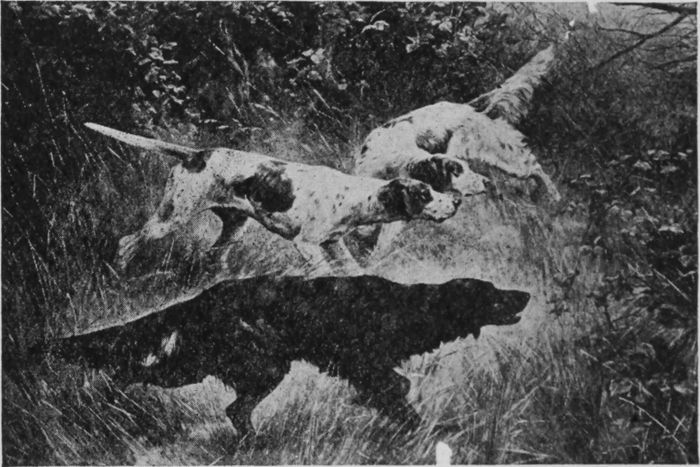
Bird Dogs "Pointing" Partridges
How do we know this, you ask? Why, four or five thousand years ago the people of Egypt kept dogs, just as we do, and thought so much of them as to draw pictures of them on the walls of their tombs. If you should visit these tombs, cut deep into the rocks, you would see here the picture of a greyhound, farther on a kind of terrier, still farther one of a wolf-dog, all looking much like our own dogs. So in ancient Assyria we find images of watch-dogs and hunting-dogs, much like our[17] mastiff and greyhound. Thus, go back as far as we please in the story of human life, man's faithful friend keeps everywhere with him.
Where did he come from? That is another part of our question. We all know that the dog's forefathers must have been wild animals, hunters and meat-eaters, which were tamed by man and made his comrades. There are plenty of these wild animals still, wolves we call them, fierce hunting creatures that run down smaller animals and kill them for food. They do not bark like the dog, but they are like it in many ways. Barking is a new form of speech learned by the civilized dog. It is the dog's trade mark.
Wise men who have made a study of the dog are sure he began as a wolf, and some dogs have not yet got far away from the wolf. Have any of you ever seen an Eskimo dog, the kind that drags the sleds of travellers over the Arctic ice? If you have, you have looked upon a half-civilized creature that is as much wolf as dog. It will work well—under the whip; but its great delight is an all-round fight, and if hungry its master is not safe from its sharp teeth.
In fact, the dogs kept by savage and barbarian people look much like the wolves of the country around them. Thus the dogs kept by the Indian tribes of our land are so much like the wolves found in the same regions that it is not easy to tell them apart.
In southern Asia and parts of Africa is a wild animal called the jackal. It is smaller than the wolf, but belongs to the same family and seems to come half way between the wolf and the fox. It is fairly certain that some of the dogs of India and other countries are tamed jackals. The jackal is easy to tame, and a tamed jackal will wag its tail and crouch before its master just like a dog.
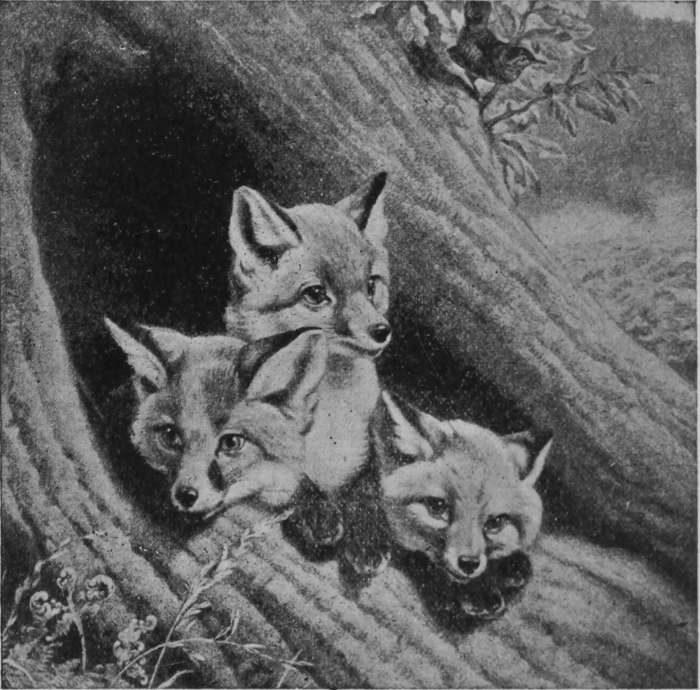
Fox Cubs at Mouth of Den. Observe Their Vigilant and Alert Outlook
We begin now to see where man found the dog. He seems in very early times to have tamed the[19] wolves and jackals around him, fed them, won their love by kindness, and taught them to do many new things. The wolves hunt in packs just as dogs do, and they are very expert in taking their prey. It is the same with the jackals. They hunt in packs like the wolves and are very shrewd and cunning. These wild animals are fierce, but so are many dogs, though in most cases the fierceness has been tamed out of our house dogs.
Any of us who go into a dog show might almost fancy ourselves in a zoological garden, for we seem to be in the midst of a multitude of different animals. It is hard to believe that the fluffy little Lapdog, not much bigger than a well-grown rat, belongs to the same family as the Great Dane, as tall as a pony and strong as a leopard. The same is the case if we bring together the slender and graceful Greyhound and the sturdy Mastiff; or compare the Collie with the Terrier or the Spaniel; or the ugly Bulldog or funny Pug with the long-headed Foxhound; or the hairy Poodle or Skye Terrier with the many short-haired breeds.
Nearly ten times as numerous as the letters of the alphabet, the dogs bewilder us with their variety, and it is not easy to believe that they all belong to the same family. Yet this is the case; they are all dogs, big and little, stout and slender, hairy or hairless alike, all one in their general[20] make-up and their habits. It is very likely, indeed, that they came from several species of wolves and jackals, yet there are certain traits of doggishness that belong to them all.
Shall we not fancy ourselves really in a dog show and walk around and look at the variety of dogs to be seen! We cannot name them all, there are too many of them, but we may take a quick glance at the prize dogs in the show. It is common to divide them into groups, such as hunting dogs, working dogs, watch dogs, sheep dogs, and toy dogs.
Of hunting-dogs there are many kinds, including the various hounds, such as the Bloodhound, Staghound, Foxhound, Greyhound, and others. These either have fine powers of scent or are splendid runners, so that few kinds of game can escape them. The Bloodhound has very acute scent and has long been known as a hunter of men. In the past it was used to hunt fugitives from justice and in our times has been often put on the track of runaway slaves.
The Foxhound has long been used in the sport of chasing the fox, large packs of them being kept in England and this country for that purpose. The Harrier, a smaller hound, is used in hunting the hare. Still smaller is the Beagle, the smallest of the hounds, but with the finest power of scent. It is a slow runner, but will keep it up for hours at a time, and seldom fails to bring down its game.
Other hunting-dogs are the Pointer and Setter, the friends of the gunner. The Pointer is so called from its habit of standing fixed when it scents game, while the Setter crouches down when the scent of game is in the air. The Spaniel is another hunting dog, much liked by sportsmen. It is a beautiful dog, with very long ears and wavy and beautiful hair, red and white in color. It is fond of swimming and knows well the art of fish-catching.
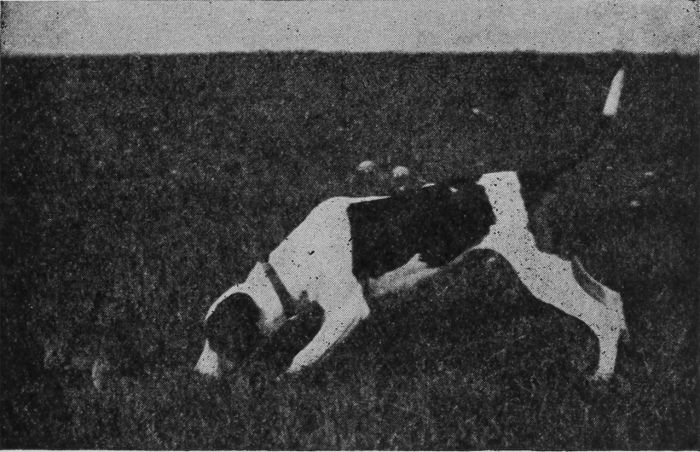
Beagle Hound Chasing a Rat
Working dogs include such kinds as the Eskimo dogs, that drag the sleds of the Eskimos and of polar explorers, and the dogs of Kamtchatka, swift, powerful animals, used for the same purpose. You have very likely read about the working dogs of Holland, which are used to pull the milk-carts of their masters. Then there is the[22] turnspit, much used in past times to turn the spit when meat was roasting before the fire. In our days there is no use for the turnspit, and not many dogs are made to work for their living. On the whole the dog is something of an aristocrat, ready for sport, keen on the watch, but not overly fond of work.
We cannot for a moment lose sight of the Sheep Dog, the Collie, as it is called in Scotland, a shaggy, wide-awake fellow, who takes better care of a flock of sheep than most men could do. He lives with the sheep, gathers them from the hills and brings them to the sheepfold when needed, and will let no prowler meddle with the woolly beasts under his care. The stranger who comes near the flock must be careful how he acts, if he does not wish to feel the collie's sharp teeth. That alert sentinel knows his duty and will stand no nonsense.
There are many varieties of the sheep dog. In Asia they have often to fight for their flocks with wild beasts and robbers, and are very strong and fierce. Some of them are shaggy, wolf-like brutes, nearly as large as a Newfoundland dog and not afraid of the biggest wolf. Dogs like these are also kept in some parts of Europe. Wise and sharp-witted creatures are the sheep-dogs, knowing and doing their business well. At a word or even a look from its master the collie will scour around the hills and dales for miles, rounding up and bringing the scattered sheep to one place.[23] And in or after the heavy snow-storms of the Scotch Highlands a dog is often worth a dozen men in saving its master's flocks.
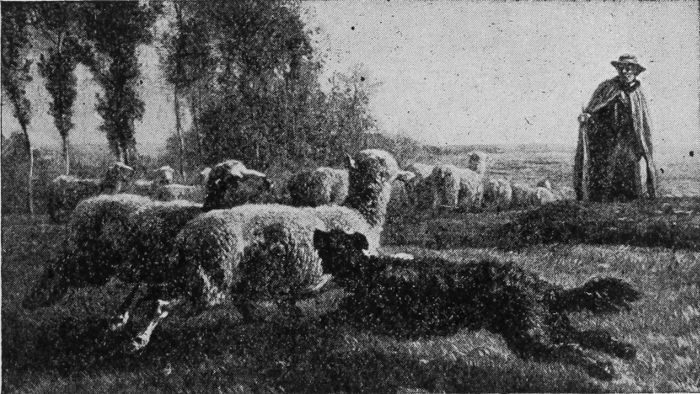
Scottish Shepherd Dog Gathering His Flock
Then there is the Drover's Dog or Cur, belonging to the same family, black and white in color, used in driving sheep and cattle to the city markets and well trained in the art of doing this. The sheep dogs of South America are fine animals. Large flocks are kept there and left alone in the care of these four-footed keepers. Darwin, who often saw them, says: "When riding it is a common thing to meet a large flock of sheep, guarded by one or two dogs, at the distance of some miles from any house or man. It is amusing to observe, when approaching a flock, how the dog advances barking, and the sheep all close in his rear as if round the oldest ram."
Now let us take a look at the Watch Dogs, those that take charge of their master's house, or follow him in his walks, ready to fight for him whether he goes out or stays in, and to act as a sentinel or guard of honor for him at all times. The Mastiff is one of the well-known house guards, a great, strong, faithful sentinel, with heavy head and powerful limbs, bold enough to fight a bear or even a lion. The British mastiff is good-natured and will even let children play with him and tease him, but when kept tied up he often grows surly and dangerous to strangers. There is a mastiff kept in Tibet which is larger than the British one and attacks strangers as fiercely as a wolf would do.
Coming a step down we meet the Bulldog, smaller than the mastiff, and looking sour and surly enough to scare any child. Its face is twisted into an ugly scowl, and its jaws are like bars of iron. When it gets its teeth into any animal nothing can make it let go. You may burn it with hot irons and it will hold on still. We may pity any one, man or beast, in whom this black bunch of obstinacy sets its teeth. It knows well how to take hold, but not how to let go.
Coming another step down we see before us the Pug, a queer little house pet, which somehow is born with the bulldog's face but is as timid and good-natured as the other is fierce and surly. He is a funny little brute, ugly enough to turn milk sour. Yet with all his ugliness he finds loving friends.

The St. Bernard Dog and His Friends
Among the large watch dogs are the sturdy Newfoundland, which is well known to us all, the splendid, erect fellow called the Great Dane, and the noble St. Bernard, kept by the monks of the Alps to seek for and save travellers who have been lost on the mountain paths or in the deep snows. When a sudden snow-storm comes on two of these powerful dogs are sent out together, one with a flask of strong drink hanging from its neck, the other with a cloak for the freezing wayfarer to put on. If the traveller has lost his way they guide him to the convent. If he has fallen and[26] been covered by the snow, they trace him by their keen power of scent, dig the snow away, and bring the monks by their loud barking, which can be heard for a long distance in the clear mountain air.
Many of you must have seen the Dalmatian coach-dog. A handsome animal it is, white in color, but well marked with round black spots. It is not fit for hunting, for its scent is not good, but it is a welcome companion when one is out on foot, on horseback, or in his coach or carriage. Lively, clean and kindly, very active and fond of running, it makes an excellent comrade for the walker or rider.
We cannot give the names of all the dogs. There are too many of them. But it will not do to pass by the smaller ones, those used for sport or for house service. Chief among the small sporting breeds are the active Terriers, all of them brave, alert and quick in motion. These are used in hunting such small prey as the otter, the badger, the weasel and the rat. To see one of them at work in a room full of rats is to look upon a living flash of lightning. A single Rat Terrier has been known to kill a hundred rats, collected in one room, in seven minutes, one quick bite putting each rat out of business.
There are several kinds of Terriers. One of them is the Dandie Dinmont, spoken of by Sir Walter Scott in his novels, a beautiful little dog[27] belonging to Scotland. Then there is the favorite Skye Terrier, of the same country, with its very long body and short legs, half buried in its own hair. Between the Fox Terrier and the Bulldog, comes the Bull Terrier, having in it something of both its parents and able to fight as savagely as the Bulldog itself.
These are the big and the medium sized dogs, but there are many smaller ones, used as pets and some so small as to be only a size larger than the full-grown rat. These are the toy animals, pocket editions of their breeds, many of them only fit for ladies' pets, to be fed and fondled and taken out in coach or carriage for an airing. They include the Poodles, Terriers and Spaniels, the larger ones good for the hunting field, the smaller fit only for the parlor.
Of the Pug, with its ugly mug, we have already spoken, and may pass on to the spaniels, often charming little playmates. There are field spaniels and toy spaniels, the field dogs being good hunters and the water-spaniels fine swimmers. The toy spaniels are very different from the hunters and only fit to be fed and fondled. They include the pretty King Charles, glossy black in color, the Prince Charles, white with black-and-tan markings, the red and white Blenheim and the red Ruby Spaniel. There are other breeds, a popular one being the Japanese Spaniel. The toy spaniel should not weigh more than ten pounds[28] and have a short, turned-up face like a pug. With their long coats and small size they are fit only for pets, but are very bright and cheery little creatures.

Courtesy of Mrs. A. R. Bauman
A Funny Quartette of Pekingese Puppies
The Poodles may also be divided into the hunting and the pet dogs. They are fleecy fellows, often with so thick a coat of hair that it is not easy to tell where poodle begins and coat ends. The most handsome of them is the large black Russian Poodle, well fitted for use in the hunting field. The small white poodle is only fit for a house pet, but it is a very clever one and can easily be taught tricks of various kinds.
It has long been the fashion to trim the poodle's coat in an odd fashion, shaving it all off from the body and hind-quarters except a few scattered tufts, but leaving it very long and thick on the shoulders. Very likely the poodle himself does[29] not like to be made such a show of, especially if there is any bite in the air. Those who have any feeling for their dogs let the hair grow in the winter and trim it only in the warm season.
As there are toy spaniels, so there are toy terriers, among them the pretty little Black and Tan and the lovely little Maltese, with a white coat as soft as floss silk and long enough to touch the ground. These toy terriers are scarcely a handful in size, some of them weighing not more than three pounds. Then there is the graceful and beautiful Italian Greyhound; of about eight pounds weight, with soft and glossy coat, fawn and cream colored, and in every way an elegant little creature.
What could we do without the dog? There are many other animals made use of by man, but the dog, his faithful friend and companion, stands first of all. It not only aids him in his sports, but clings to him in all the affairs of life, and has been known to lie down and die on its master's grave, not willing to leave him even after death.
Not only faithful and loving is the dog, not only fond of play and sport, but it has a very good brain of its own and is one of the smartest of all the animals. If it could only talk we would find that a great deal goes on inside its little thinking organ. How wisely it will at times look[30] up in our faces, as if to say, "If I could only speak I could tell you many things worth listening to."
But can dogs think? some of you ask. I am sure that most of you who keep dogs could answer this question for yourselves. Certainly dogs very often do things that look much like thinking. There are hundreds of anecdotes telling us of wise things done by dogs and I propose to tell you some of these. I think you will find that they answer your question. I am sure that most of you could tell me of some clever dog doings. Here are some that seem worth telling.
A farmer friend of mine long ago told me of some curious things done by a dog of his. He had a bell hung on a post in his yard, with a rope coming down from it. He would ring it in the early morning to rouse up the farm hands for their day's work. One morning he was surprised to hear the bell ring very early, but no one could tell him who had rung it.
The next morning it rang again. He sprang from bed and looked out the window to find that his dog was the culprit. It had the rope in its teeth and was pulling away like an able bell-ringer. The little chap was lonely and wanted company; he had often seen the men troop out on the ringing of the bell; so he put two and two together and rang the bell himself. The farmer had to hang up the rope out of reach to put an end to this doggish trick.
The same dog had a great fancy for riding in a carriage of his own, and when one of the men drove up to the door with his cart, and left the horse standing while he went into the house for orders, doggy would bark and bite at the horse's shins until he set him in motion, and then would jump into the cart for a free ride. He was "only a dog," but he knew how to get what he wanted, and he looked proud enough as he stood with his feet on the front of the cart, as if he owned all the world he could see.
Another friend tells me that, when a country boy, he had to go a mile or two every morning to the post office for letters and papers, his dog keeping him company. On one morning there was nothing for him and he started back empty handed. But the dog refused to follow. It seated itself on the post-office steps and would not budge. He tried in various ways to make it come, but in spite of all he could do back it would go to those steps and seat itself as before.
The boy was at his wits' end. At last the thought came to him of what ailed the obstinate brute. He took a piece of paper from his pocket and held it up and at once the dog came running up, frisking about him gladly. If it could have spoken it would have said something like this: "You and I were sent to bring the papers. If you choose to go home without them I do not. I know my duty better than that."

Hounds Overtaking a Fox
The story has often been told that dogs which have been in the habit of eagerly following their masters on their week-day walks, will not stir on Sundays. They seem to know from past experience that they are not welcome on that day. Do these creatures count the days of the week and know in that way when Sunday comes? Or is there something in the dress of the family, the[33] sound of church-bells in the air, or other indications to tell them that this is a day set aside from doggish sports and duties?
All I can say in the matter is that a village friend of mine, whose church was too far away for the bells to be heard, had a dog of this kind, that ran friskily up to go out with him every morning but Sunday, when it would not stir from its rug. To test the animal he on several occasions came downstairs in his week-day clothes and went about in his week-day manner. But the wise creature was not to be fooled. It looked at him lazily and lay still, its looks seeming to say, "I can count as well as you and I know this is Sunday. You can't fool me with your old clothes."
You may see that I am not going abroad for my stories. These are not anecdotes taken from books, but little matters told me by friends. The book stories, no doubt, are better, but these are fresher. Here are one or two that I have heard of a different kind, tales which go to show the faithfulness of the watch-dog.
One of these is of a gentleman who went out one day, leaving his dog locked in the house. On his return in the evening he found that he had forgotten his key and could not get into the house by the front door. He tried the other doors and windows and at last found an open window into which he tried to climb. But so savage a bark came from the care-keeper inside that he backed out again in a hurry.
"Don't you know me, Carlo?" he said, in a coaxing tone.
Carlo knew him well enough and came with wagging tail to the window to be caressed by its master's hand. But the instant he tried again to climb in the animal's attitude changed and it became the fierce watch-dog again.
Try as he would, Carlo simply would not let him come into the house in that way. It was the burglar's route, and even if this man were his master he had no right to take it. In the end the baffled gentleman had to give up the attempt and leave Carlo lord of the premises. The faithful watch-dog knew not master or man when it came to a question of duty.
Now let me speak of a dog that had a different sense of duty. It belonged to a cousin of mine and when left in charge of the house in the absence of its mistress was quite willing to let visitors enter and seemed very glad to see them. The trouble began when they tried to go out. This the dog would not permit. It was ready to attack them with teeth and claws if they tried it. "Here you are and here you stay till my mistress comes home," its attitude seemed to say. "Your coming may be all right, but that is for the lady of the house to decide, and you shall not go a step until she returns."
Dogs cannot talk, that we all know very well. It is true that there is at present a dog in Germany[35] which has been taught to speak a number of words, in a way that makes it easy to understand them. But no one fancies that even this dog will ever become a good and ready talker. Yet it is well known that dogs can understand human speech and sometimes very well.

The Dog Guardian. "Can You Talk?"
Thus a friend of mine comes home at night, after a day's hard work, flings himself lazily on the sofa, and says to a visitor: "If Jim there knew enough I would ask him to go upstairs for my slippers."
Jim, the dog, who has been lying in easy content on his favorite spot, at once gets up, stretches himself, and trots off up stairs, coming back in a few minutes with a slipper in his mouth. Off he trots again and comes back with the other, then lies down once more with an air of satisfaction.[36] This is an actual incident. Very likely the word "slippers," joined with his own name, was the key-note to the dog's action. The two words were enough to tell him what was wanted.
Dozens of incidents of this kind might be given. Here is a good one that has so often been told that many of you may have read it. A sheep-dog in a Highland cottage was lying one day before the fire while his master, a shepherd, was talking with a neighbor. He wished to show his friend how quick-witted a dog he had, and while talking about a different matter, said in a quiet tone, "I'm thinking, sir, the cow's got into the potatoes."
The dog, which had seemed asleep, at once jumped up, leaped through the open window and scrambled to the cottage roof. Here it could see the potato field. As no cow was there, the dog ran to the farm-yard, where it found the animal it sought. It then came back to the house, and quietly lay down again.
Some time later the shepherd said the same words and the dog sprang up and went out again. But when the words were repeated a third time the wise creature came up to its master with wagging tail, and looked into his face with so comical an expression that the talkers broke out into a loud laugh. Then with a slight growl, the dog laid down again on the hearth rug with an offended air, as if saying to itself, "You shall not make a fool of me again."
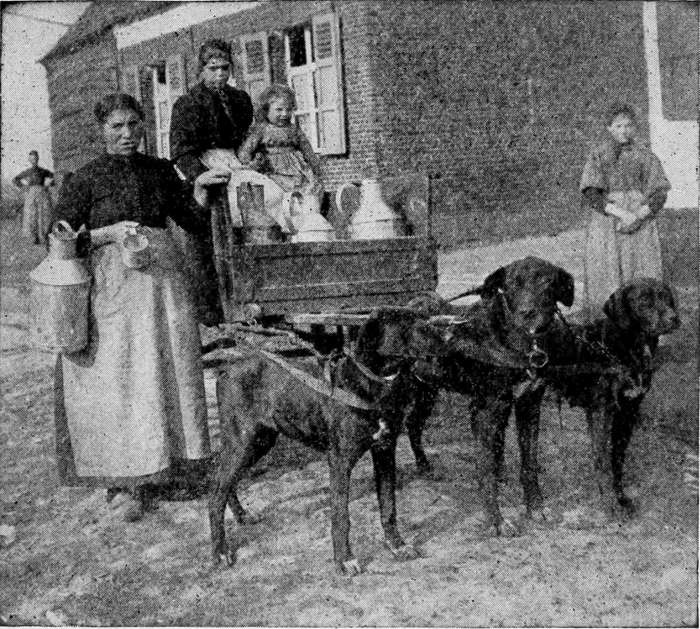
A Dog Team Hauling Milk in Antwerp
This is one of the stock stories of dog wit. Many others like it might be told. There is no doubt that dogs have ways of making their dog friends know things they would like to have done. Many stories could be given to prove this, but most of them are too long to be told here. Thus we are told of dogs that have got the worst of it in a fight seeking a stronger friend, telling their story in their own way, and the two going out together to whip the whipper.
Dogs have their feelings, too, and can easily be[38] insulted. "Low life" dogs are so used to being cuffed and kicked that a kick does not hurt their feelings, though it may their flesh. But "high life" dogs are apt to be very delicate in their feelings, and the mere touch of a whip hurts their pride deeply. Here is a story of a Skye terrier that went out every day for a walk in the park with its master's brother. One day when it hung back to amuse itself with another dog the gentleman, to induce it to follow, struck it with his glove.
The terrier looked up with an air of anger and dignity, turned round and trotted off home. The next day it went out again, but after a short walk it looked up into the man's face, turned on its heels, and trotted back once more with an air of great dignity. Having thus made its protest, it would never go out with him again.
Here is another case, having to do this time with unjust treatment instead of offended pride. Arago, the famous French scientist, was once detained by a storm at a country inn, and stood warming himself by the kitchen fire while the innkeeper roasted a fowl for his dinner.
Having put the fowl on the spit over the fire, the innkeeper tried to catch a turnspit dog lying in the kitchen and put him in the wheel by which the spit was turned. But the dog would not enter the spit, got under a table, and showed fight. When Arago asked what made it act that way,[39] the host said that the dog was right, it was not its turn but that of its companion, then out of the room. The other turnspit was sent for, entered the wheel at once and turned away willingly. When the fowl was half done Arago took this dog out and the other dog now readily took his turn. He had fought for right and justice and had won.
We must stop here. The stories told about the intelligence of dogs are so many and of such different kinds that they would more than fill this book if all were told. We have picked out a few of some kinds. There are other kinds. Thus dogs do not like to be laughed at. They have also some sense of humor and will try to play tricks on their masters. They have a sense of shame and will slink away when caught at some act of which they should be ashamed. And there are thieves among them that will steal in a very skilful manner. Thus sheep-killing dogs are very cunning at hiding the evidence of their nightly raids in the sheep-field.
I cannot leave the dog without quoting Senator Vest's fine words of praise of this noble animal. They may be viewed as a classic tribute to the dog. They were spoken in a law-suit in which the Senator was acting for a party whose dog had been killed. It was "only a dog," said the other lawyer. Here is what Senator Vest said to the jury:
"Gentlemen of the Jury: The best friend a[40] man has in the world may turn against him. His son and daughter whom he has reared with loving care may become ungrateful. Those who are nearest and dearest to us, those whom we trust with our happiness and our good name, may become traitors to their trust. The money that a man has he may lose. It flies away from him when he may need it most. A man's reputation may be sacrificed in a moment of ill-considered action. The people who are prone to fall on their knees and do us honor when success is with us may be the first to throw the stone of malice when failure settles its cloud upon our heads. The one absolutely unselfish friend a man may have in this selfish world, the one that never deserts him, the one that never proves ungrateful or treacherous, is the dog."
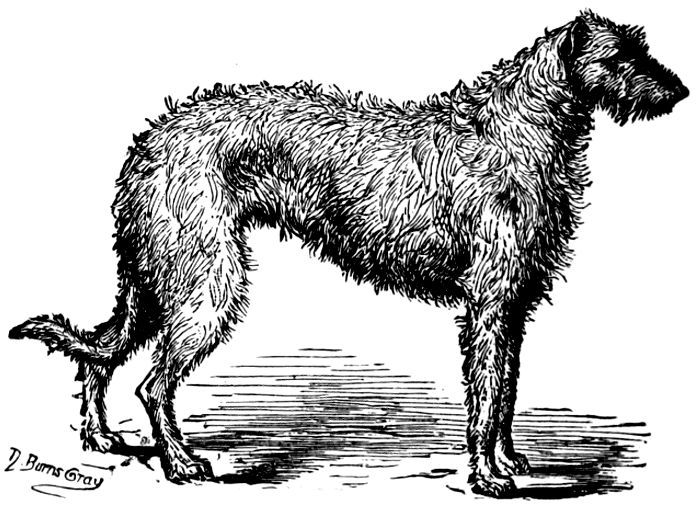
Deerhound, Rossie Ralph
"A man's dog stands by him in prosperity and poverty, in health and sickness. He will sleep on the cold ground when winter winds blow and snow drives fiercely, if only he may be near his master's side. He will kiss the hand that has no food to offer; he will lick the wounds and sores that come in encounters with the roughness of the world. He guards the sleep of his pauper master as if he were a prince. When all other friends desert, he remains; when riches take wings and reputation falls to pieces, he is as constant in his love as the sun in its journey through the heavens. If fortune drives the master forth an outcast into the world, friendless and homeless, the faithful dog asks no higher privilege than that of accompanying him to guard against danger, to fight against his enemies. And, when the last scene of all comes and death takes his master in its embrace, and his body is laid away in the cold ground; no matter if all other friends pursue their way, there by his graveside will the noble dog be found, his head between his paws, his eyes sad but open in alert watchfulness, faithful and true even unto death."
The claim for the loss of the dog had been $200, but when the jury heard this just and masterly tribute to the dog they gave a verdict of $500. Well they knew that every word of it was true.
When the sun has left the sky and night flings its dusky cloak over all things out-of-doors, then within the house we draw the curtain, light the lamp, and gather round the study table with books or games. And soon from her fireside nook steals up soft-footed puss, seeking a friendly lap in which she may nestle and purr the hours away.

From Trueblood's Cats by the Way
The Mother Cat and Her Playful Brood
This bundle of fur we call by the short name of cat was born in other climes and trained in other ways than the dog, and is as sly and sleek as the dog is rough and boisterous. It knows how to make itself at home and dearly loves a soft spot, but it has never quite got rid of its wild-life ways and is often as hard to make a friend of as the dog is easy. Rarely does it follow at man's heels in the dog's faithful fashion.
When did man first take the cat into his house[43] and make it one of his pets? That is hard to say. If we go back to the early days of civilization we find the cat an inmate of man's house as well as the dog, and quite as much at home. It was kept in Egypt several thousand years ago and thought so much of in those far-off days as to leave the dog almost out of sight.
The people of that old land loved and worshiped the cat, made it into a mummy when it died, and any one who killed a cat was punished as if he had committed a great crime. That was the golden age of the cat, for one of the goddesses was said to have a cat's head, and the cat had a sacred city of its own, the city of Bubastis, where a festival in its honor was held every year and attended by more than half a million of people.
The people of Greece and Rome also thought much of the cat—perhaps because it helped them to get rid of the rat, which was as great a pest then as it is now. In later Europe also the cat was a favorite, and it was the custom at Aix, in Provence, to get the finest male cat that could be found, dress it like a baby, and seat it in a splendid arm-chair for the people to bow down to and worship.
The time came at length when the cat lost its good name and people began to look upon it as an imp of evil and the companion of the witch and the sorcerer. A black cat was the worst of all and its life was a hard one. In those evil days[44] for the cat it became the fashion to fling cats from the tops of high towers, and at Metz, at the festival of St. John, cats were thrown by the dozen into a blazing fire and burned alive.
But better days have now come to pretty puss, and she is cared for as much as the dog, making the house her nest while the dog lives largely out-of-doors. It is chiefly at the late hours of the night that the cat goes abroad. I need not tell any of you what follows. You have all heard the music of a cat concert and felt as if you would like to treat those midnight howlers as the witch-cats were treated of old. Caterwauling we call it, and of all the noises of the night it is far the worst.
Where did the cat come from? That no one can tell exactly. There are wild cats in many parts of the world, we find them in Asia, in Europe, in Africa, in America, but none of them just like our household cat. The fact is that cats differ in different parts of the world and they may have come from several species. The Gloved Cat of Nubia comes nearest to the house cat in size and the shape of the head and tail, but in other ways is unlike it. So, on the whole, we are still in the dark about the origin of the cat.
One thing we do know, and this is that the cat has kept more of its wild ways than the dog. In its nightly rambles it is like the wild-cat of the woods. And even in the house it is a little too ready to show its claws. It will scratch where a[45] dog would not think of biting. It is said that the cat loves places much more than it does people, and in moving from one house to another it is hard to get the cat away. It loves its old haunts more than its old friends.
The cat walks on its toes like the lion and tiger and all its other wild relations. But its claws do not touch the ground. They are drawn up into a sort of sheath and kept sharp for use as a soldier keeps his sword sharp in its scabbard. The paws being covered with fur, its step is silent and its movements are quiet and cautious, as many a mouse has found out.
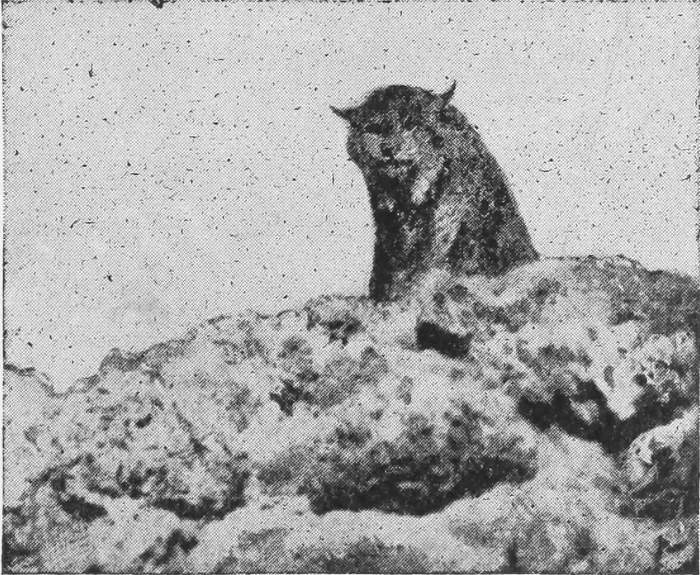
The Canada Lynx, the House Cat's "Cousin"
We might not care so much for the cat if it were not of use to us in killing those pests of the house, the rat and the mouse. No matter how well fed she is, pussy dearly loves her mouse, and if on the track of one she is not to be turned aside. She[46] will crouch for an hour at a time watching a mouse-hole, never moving a hair until the victim appears; then a single bound and all is over for the little creature. Even if the cat is asleep, no mouse can pass it with safety. Its ears and nose do not seem to sleep.
Once caught, the mouse is played with in a manner that seems cruel to us. The cat makes a game of letting its prey run away, but takes good care it does not reach its hole. This, no doubt, is one of its wild traits, handed down from its ancestors and never tamed out of it. We are told by one observer that a cat will catch and eat twenty mice in a day—this, of course, where mice are plentiful. But when a cat gets a taste for poultry or rabbits it is spoiled as a mouser. And though it is said that cats do not like to get wet, their fondness for fish is greater than their dread of water and they have been known to go fishing in a stream.
It is not easy to make a treaty of peace between the cat and the dog. Do they hate each other or are they jealous of their position in the house? The cat is not a match for the dog and makes haste to get away from the chasing cur, yet when driven into a corner it will put up a good fight for its life, and many a dog has been sent yelping away from its sharp claws. But this state of warfare does not always exist and it is not uncommon for cats and dogs to live together on friendly terms.
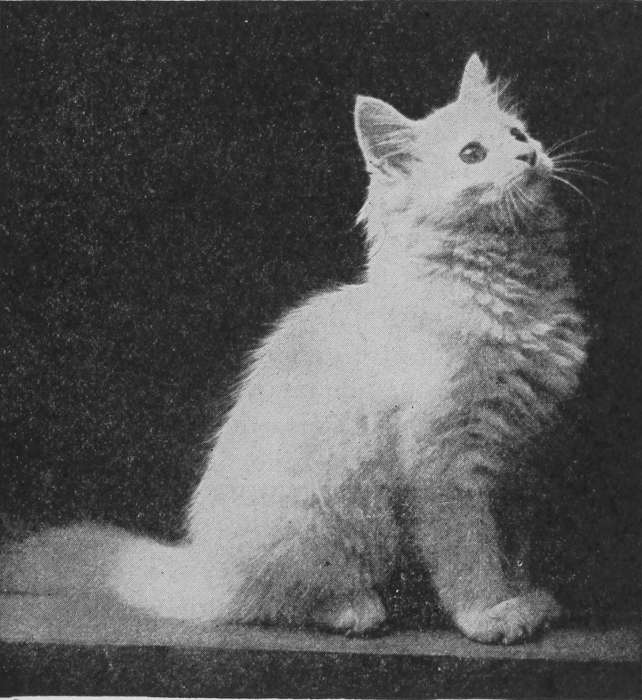
Lippincott's Primer
Ready for Business
If we go around the world we shall find cats everywhere and of many kinds. There are not nearly so many varieties of them as there are of dogs and they do not vary much in size like dogs, yet some breeds of cats differ greatly from others. Thus the cats from the Isle of Man—Manx cats they are called—have no tails, while their hind legs are very long and strong and they are covered[48] with a thick coat of fur instead of hair. Let us compare this with the showy Angora cat, with its tail like a great white plume and its long white hair. And they differ as much in character, for the Manx is a hardy animal and the Angora is a delicate parlor cat, its health needing to be carefully looked after.
Then there are the Malay cat, with a tail only half the full length; the royal Siamese cat, fawn colored, with blue eyes and small head; the Carthusian, with long, dark, grayish-blue fur; the South African, with red stripes along its back; the Cyprus, striped and very tall, and the handsome Persian cat with its long silky hair.
As races are apt to be mixed, cat fanciers make color their chief point of value. The principal colors are white, black, blue, blue-gray, smoke-color, orange, and tortoise-shell. A true tortoise-shell tom-cat brings a big price. The color of the eyes is very important. Blue eyes are a sign of deafness. Some white cats have red eyes. As for the hair, cats are divided into two classes, the long-haired and the short-haired, the Persian and Angora being notable for the length of their hair. Most common among our cats is the soot-colored or gray, known as the "tabby," which has black stripes going round its legs, neck, and tail, and also down its sides. These show a return to the wild-cat in color, though tabby is as tame as her rivals.
The cat is not lacking in brain power nor in affection, for in many cases it shows warm love for its mistress. There are various anecdotes of cat logic, of which a few may be told. When crumbs have been thrown out to feed the birds a cat will often hide in the shrubbery, waiting for a chance to spring on them as they feed. One writer speaks of a case where the cat went farther in its logic. The crumbs thrown out had been covered by a light fall of snow, and the cat was seen scratching the snow away. Then she took up the crumbs, laid them on the snow, and hid behind the bushes to wait for the hungry birds.
A cat trick which shows good reasoning power has often been seen, that of opening latched doors, a thing which dogs very rarely do. Thus a cat will spring from the ground, catch the latch handle with one paw and with the other pull down the thumb-piece, at the same time scratching with its hind paws at the door post to open the door. The cat that does this must have seen men pull down the latch for the same purpose and reasoned out that it could do the same.
Also there are cases of cats learning to sound knockers and ring bells, with no one to teach them. Thus a Mr. Belshaw writes: "I was sitting in one of the rooms on my first evening there, and hearing a loud knock at the front door was told not to heed it, as it was only the kitten asking for entrance. Not believing this, I watched for my[50]self, and very soon saw the kitten jump up to the door, hang on by one leg, and put the other forepaw right through the knocker and rap twice." Here the cat is not trying to open the door herself, but to bring some one to open it for her.
Dogs have been known to do the same thing, but not so often as cats, and there is a story of a dog which had seen the cat do this, and after that sought the cat when he wanted to get in, without trying to do the trick himself. One story is told of a cat's ringing a bell by pulling at an exposed wire.
Though the cat's display of thought is not as varied as the dog's, it is very good so far as it goes. Here is a story of a different kind. An oil lamp was being trimmed and some of the oil fell on the cat's back. Afterwards a cinder from the fire fell on it and set it in a blaze. The animal at once sprang for the open door and ran up the street with her back blazing for about a hundred yards. Here was the village watering trough, into which she plunged and put out the fire. The trough had eight or nine inches of water, and puss was in the habit of seeing the fire put out with water every night. In this case it is plain that the animal, as soon as the fire scorched her back, knew very well how to deal with the danger.
After all this, who will say that a cat does not think? Here is another story, told of her cat by a London lady:
"I once had a cat which always sat up to the[51] dinner-table with me, and had his napkin round his neck and his plate and some fish. He used his paw, of course; but he was very particular and behaved with extraordinary decorum. When he had finished his fish I sometimes gave him a piece of mine. One day he was not to be found when the dinner-bell rang, so we began without him. Just as the plates were being put round for the entrée puss came rushing upstairs with two mice in his mouth. Before he could be stopped he dropped a mouse on to his own plate and then one on to mine. He divided his dinner with me as I divided mine with him."
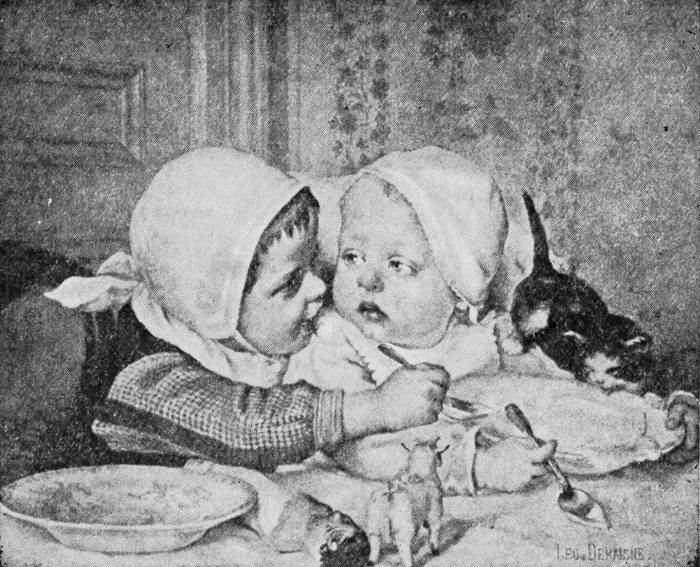
The Hungry Babes and Playful Kitten
Such is the cat, a sedate, warmth-loving creature, dearly loving to be petted, yet far less dependent on man or woman than the dog. If left to itself in the woods, the cat knows well how to take care of itself where a dog would often be helpless. As for love of play, we do not find much of it in the cat but we find plenty in the kitten, which is a regular little rogue, lively, playful, frisky, brimful of fun and a cute little creature in all its ways.
Looking around us for our household pets after the dog and the cat, we find that Bunny, the rabbit, comes next. Bunny is a darling pet of the little ones, who dearly love to fondle this pretty bundle of fur. They are sometimes too kind and the poor little thing suffers from their fondness. That is the sad way with children's pets, they are at times loved to death.
But the rabbit is kept for something else than a child's plaything. It is often raised for food, much like the hen and the duck, and its furry skin brings a good price. Thus the Angora rabbit, the most beautiful of them all, has splendid snow-white fur four inches and more in length, which is made into many things useful to wear. Stockings, gloves, shawls, and even stuffs for clothing are made of it. Under-garments made of the Angora fur are said to be very good for gouty persons.
The pretty little Angora is so often kept as a pet by the ladies of France and some other countries that it is called "the ladies' rabbit." It is not always full white, for the Russian Angoras have jet-black noses, ears, legs and tails, which make them look very comical.
You would be surprised if you could see all the kinds of rabbits brought together, for there are many more of them than you would think. A splendid one is the little Silver rabbit, whose skin is used by the fur-makers and brings a big price. Some of them are silver-brown and others silver-yellow in color, but these are not common.
The Dutch rabbit is the smallest of all the bunnies, and when the colors are good it is very pretty. It may be black, yellow, steel-blue, and of other colors, these hues being oddly combined. Other rabbits of small size are the Polish and the French papillon (or butterfly). The one called the Polish is really an English rabbit, and little folks are very fond of it, with its red eyes twinkling out of its snow-white fur. This fur is of high value. The papillon is white, with black, yellow, gray, or blue spots, and is quite pretty.
Then there is the Japan rabbit, also called the tricolor or tortoise-shell. It has black, yellow and whitish markings and rings round its body, while its head is often half yellow and half black.
You can see from what has been said that color has much to do with the difference in rabbits.[54] The ears form another point. They are generally long and stand straight up, giving the rabbit a wide-awake look, but there is a lop-eared rabbit with ears so long and heavy that they hang down on each side and nearly touch the ground.
The king of all the rabbits in size is the Giant rabbit of Flanders. Two others known as giants are the Blue Giant of Vienna and the Blue Giant of Beveren (Flanders). The flesh of these Blue Giants is very good and their fur brings a high price. That of the Blue Giant of Beveren is very thick and close and is of great value. This animal weighs from seven to ten pounds.
We are familiar in this country with the Belgian hare. It is not a hare at all, though it looks like one, but is really a rabbit, and is a fine strong species, weighing six or seven pounds and excellent for the table. It is a little wild, but soon grows gentle with those who care for it. It used to be sent in great numbers to the United States.
You may see from what has been said that there are many varieties of the rabbit. Of those used for food much the best is the Norman rabbit, which weighs nine or ten pounds and is sold in the markets in Paris and other cities of France. The black-and-tan is one of the most beautiful of the rabbits, from its splendid color, but it is very shy and hard to tame. The last we need speak of is the Havana rabbit, of brown or chocolate color, now much raised in Holland.
When the rabbit is taken good care of it is very healthy and those who raise it for the market for its fur find it of much value, since it increases in numbers very rapidly. Many of the young die, it is true, but enough live to keep up a large family.
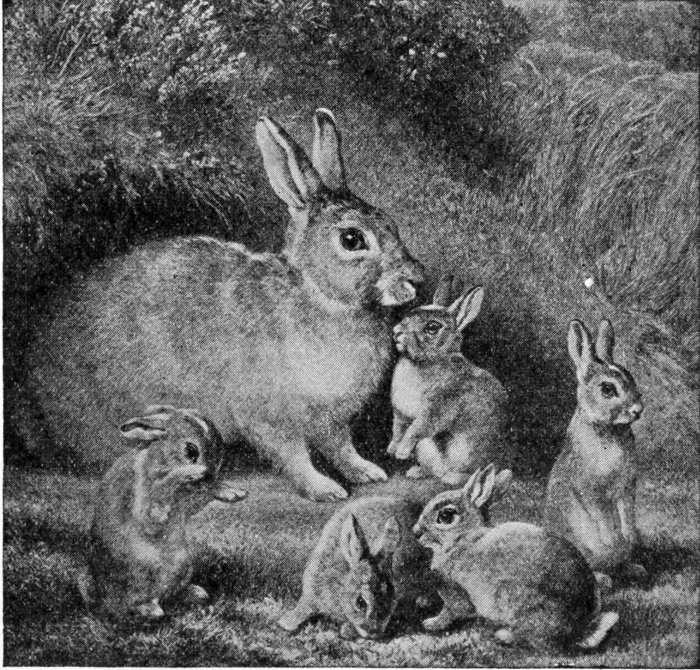
Rabbits near Their Burrow. The Young at Play, the Mother Alert for Danger
A good rabbit home may be made of a number of boxes of about the same size, raised four or five inches above the ground and facing the sun if they are kept in the open air. Casks or barrels may also be used, with a door at one end of the barrel, covered with netting to keep out rats and mice.
It is amusing to see the care with which the mother rabbit makes her nest when she is about to have young. Some soft straw and hay is put in the box or cask and this she carries into one corner of her home, makes a hollow in it, and lines this with fur pulled from her breast, to make a warm, soft nest for the little brood. When the young are born she must be given something juicy, such as a turnip or carrot, or perhaps a little warm milk or water, for if left thirsty she grows feverish and is apt to eat the little ones, not knowing what she is doing. She cannot bear thirst and it makes her do strange things. There may be new broods of young five or six times a year, and if only three or four of each brood live there will be a good many by the year's end.
There are many other animals which are at times kept as pets by man, though the dog, cat, and rabbit are the most common. The Ferret is often kept, though not as a pet. It is a half wild little brute, hard to tame and used for hunting, for some kinds of which it is very useful. It is a sort of white weasel, long and slender, so that it can make its way through rat holes or rabbit burrows. A brave little thing, it is not afraid to attack the largest rat, and is good at clearing a house of rats and mice. It is also used to drive rabbits from their burrows. Nets are set to catch the prey or they are shot as they rush out. But a muzzle is put on the ferret, for if it can kill the[57] rabbit and drink its blood it may stay for days in the hole. At other times a long string is tied to it, so that it can be pulled out. The ferret is sometimes used to chase and catch fowls. Once caught, a single sharp bite on the neck puts an end to the life of the fowl.
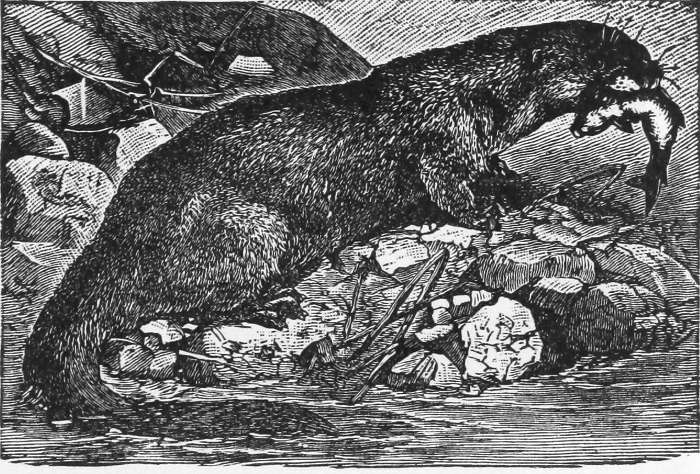
The Otter, One of Nature's Fishers
The ferret is a blood-sucker, and this makes it dangerous when it has once tasted blood. It has been known to attack a child in its cradle when the mother was away, and will bite its master if not given enough food or ill-treated in any way. It is an ugly tempered little brute, usually unfit for petting. But Mr. Romanes tells of one kept by him that was fond of being petted and would follow him like a dog when he walked out. It was also taught tricks, such as begging for food and leaping over sticks, and those it never seemed to forget.
The Guinea-pig, which is often kept as a home animal, has none of the fierce ways of the ferret. In spite of its name, it has nothing to do with the real pig, but is one of the gnawing animals, a timid and stupid creature, that first came from South America. Large numbers of them are found on the banks of the La Plata River, being there known as the Cavy. They burrow in the ground and feed on fruits and herbs.
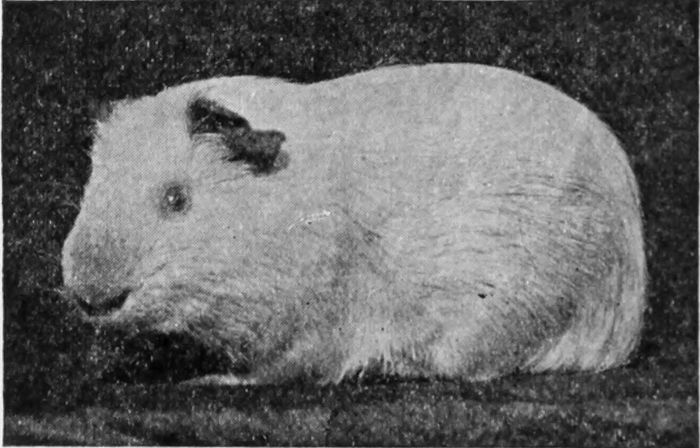
A Guinea-Pig. Pig Only by Name, not by Nature
What people like in the Guinea-pig is its pretty coloring. The wild form is of a grayish-brown color, but as kept on the farm its color is white, with patches of red and black. It is of no use to man except as a pet, for it is not fit for food and is too stupid for anything else. It has been said to drive off rats and mice, but this is a false notion.
What can we say of the Hedgehog as a pet? Not much, though it is often kept. It is no more a hog than the Cavy is a pig, but is not one of[59] the gnawing animals, for it lives chiefly on mice, game, birds, frogs, insects and worms. This makes it very useful in a garden or in a house in which roaches are a pest. The odd thing about the hedgehog is its armor of sharp spines. When attacked by a dog or other animal it at once rolls itself up into a ball with the spines pointing out in all directions like those of the porcupine. Thus the little creature is quite able to take care of itself. The dog may roll it about with his foot but is afraid to bite into its spines.
The Weasel has also been tamed and been found a lovable little animal. The Otter is another tamable creature and can be taught to catch fish and bring them to its master. Dr. Goldsmith tells us of one that would go to the fish pond when told to do so, drive the fish into a corner, seize the largest and carry it in its mouth to its master.
There are many other animals that have at times been kept as pets, among them such a queer one as the Kangaroo, with its very long hind legs and very short fore-legs and its habit of jumping instead of walking. A pet kangaroo of which we are told was a very man-like or monkey-like creature in its way of eating, using its fore-paws like hands to take food from its dish. What it most enjoyed was a rabbit-bone, which it would take in its right paw and pick clean, eating it with great relish.
It was very fond of tea, but liked to have it[60] well sweetened. If the milk was left out it would lash its tail, draw up its tall figure angrily and bound away with a long leap. Kanny had a very sweet tooth and liked sugared almonds best of all titbits.
Other odd pets we have heard of were a couple of Prairie dogs, brought from Texas to Scotland and kept in a village garden. They proved very friendly but needed to be locked up in a strong box at night, for they would gnaw into shreds the mats and rugs and everything open to their sharp teeth. But they were loving little things and had a way of showing affection by a gentle pressure of their teeth on the hands of their friends. If a stranger touched them in a timid way he was apt to get a pinch but if a firm hold was taken they seemed to like it.
These are only a few of the animals that have been kept as pets. Cardinal Wolsey made a friend of an old carp, Cowper, the poet, loved to play with his hares, and Lord Clive, the soldier, kept a pet tortoise. Others of less note have made pets of snakes, frogs, lizards, and various other animals. We have not tried to name them all and have said nothing about so common a pet as the monkey, for we must keep this funny fellow for a chapter of his own.

Is there anywhere, has there ever been, a finer or more useful animal than the horse, the swift racer of the plains, the noble lord of the desert, the mainstay of the city and farm? To us the horse is as familiar a friend as the dog. We see this fine animal everywhere that man lives, now valued for his speed, when he flies away over the racing field "with the wings of the wind;" now admired for his beauty and stately form, when he draws the coaches of kings and nobles; now for his great size, as the huge draught animal; now for his small size, as the dainty little pony. It is sad to say also that we often see him as the old, worn-out drudge of the streets, hard-worked, half-fed, and slowly dying in harness.
Go back as far as we can in history it is the same story still. The horse is man's friend and helper, carrying him in the battle-field, working for him on the farm, bearing him in his travels. But if we go back beyond history we come to a time when the horse was free and wild. It was not yet tamed by man, but was hunted and killed for[62] food. In the caves that were the homes of early man great numbers of horses' bones are found, left from the feasts of old-time savage men.
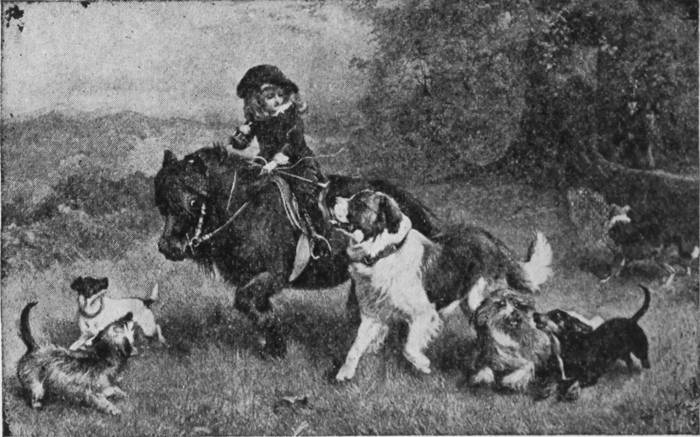
Friends and Comrades
The wild horse has not gone from the earth. Troops of them still live on the vast plains of northern Asia, and they are found also in the forests of the south of Russia, small, wiry animals, full of life and spirit. These are called Tarpans. Centuries ago wild horses were to be found in Spain and parts of Germany, but these have all been caught and made to work for their living. America has its wild horses also, plenty of them in South America, but they are not natives of the soil. Some of the horses brought over from Spain by the early settlers escaped from their masters and became free and wild in the great grassy plains.[63] These are known as "mustangs" or "cimmarones," and no use is made of them except by the Indians, who kill and eat some of them and tame others.
No matter where we find horses they are very much the same. They are not like dogs, of which there are so many kinds. Of course there is much difference in the size of horses and also in their colors, but little difference in other ways. If we travel together over the earth and see the horses of the various countries we shall find them very much alike. Yet such a journey is well worth taking, for it will show us many things we ought to know.
The horse family, as very likely you know, differs from all other animals in having only one toe. It comes from animals that had a number of toes, but these have all gone but one, and the nail of this toe has grown into a thick, horny hoof which keeps the foot from being hurt as the horse gallops over its native plains. Its home is on broad, grassy levels, soft to the tread. But when used by man it has to travel much on hard and stony roads which would soon wear out its hoof. So to save this it has to be shod with iron. The hoof is so thick that the iron shoe can be nailed to it without touching the flesh.
There are a number of animals much like the horse, but unlike it in several ways. These animals[64] we shall speak of further on. One of the special points by which one knows the horse is the long hairs which cover the whole length of its tail. Another is its splendid, flowing mane. It has also longer legs and smaller head and ears than the other members of its family. Altogether a fine horse is one of the handsomest of all animals. And among them all it is one of the most useful to man.
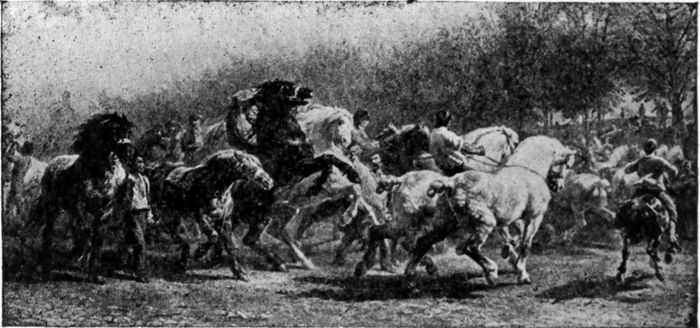
Rosa Bonheur's Famous Picture of the Horse Fair
Now let us start on the journey abroad we laid out and see some of the world's horses. If we go first to the grand plains of northern Asia, the broad, level country called the steppes, the people of which are always travelling about with their flocks and herds, we shall find ourselves in the native land of the horse. In far-off times this was the great region of the wild horse and here very likely it was first made a slave of man.
All the time on the move, as these shepherd people were, driving their cattle and sheep from[65] pasture to pasture, the horse was fitted for their use by its strength and speed, and very long ago it must have been caught and made to bear the saddle and bridle and carry man on its back. No one can say how long ago this was, but these people are now the great horsemen of the earth. They live with their horses, sleep with them, and love them even more than they do their children.
The Mongols of the steppes have almost lost the art of walking. They live so much on horseback that their legs have become curved instead of straight and when they walk their bodies bend forward as if they were riding. The time was when great hordes of these wild horsemen swept over the south of Asia and a great part of Europe, capturing and killing the people wherever they came. Thus the horse has been of great use in war.
The horses of the steppes are of middle size but are very strong and can go long without food and bear very hard work. They have quick, alert ears and eyes full of life and spirit, and can easily travel from forty to sixty miles in a day. Their color is light bay, cream color, white spotted with red, or sorrel, and some of them are quite pretty.
Here let us step aside to the British island and tell the story of a famous horse, Black Bess, belonging to a famous rider, Dick Turpin, the highwayman. Once when Dick was chased by the soldiers, this noble animal carried him from London to York, a distance of one hundred and[66] five miles, in eleven hours. And this was done over rough roads and without a stop to eat or drink. As she entered the gates of York the splendid beast fell dead. You may learn from this what the horse is able to do.
If we wish to see the noblest and finest of all horses we must go from the grassy steppes of the north to the sandy deserts of Arabia, where for thousands of years has been kept the splendid Arab breed, the pride of their masters and the swiftest and most beautiful of the horse tribe. Many of these have been brought to Europe to give their blood to the racing stock. Black Bess, Dick Turpin's noble horse, had much Arabian blood. But the best of these horses are not sold out of their native land, for a true Arab horseman would almost rather sell his soul than his horse.
Persia also has its noble breed of horses, kept for desert travel and of the same type as those of Arabia. The mountain horses of the Balkans are of a similar type, beautiful in color, often a golden brown, with dark brown manes and tails, and soft, glossy coats. Like the Persian and Arabian they have delicate but strong bones, large muscles and much power of work and travel.
Russia, with its vast plains, is the great country for the horse. Most of these are the horses of the steppes, which we have spoken of, but the Russian peasants have many millions of working horses, tall, stout, strong beasts, with powerful legs and[67] solid hoofs. They are not only strong, but willing and ready, and are good for riding as well as drawing.
Germany comes next to Russia in the old world in numbers of horses, and is noted for its fine, large, handsome carriage horses. From the days of George I. of England, to Queen Victoria's Diamond Jubilee in 1897, eight of the splendid horses of Hanover were used to draw the royal coach on all state occasions, and fine, stately animals they were.
France has several fine breeds of horses, from the heavy Norman Coach horse to the powerful French Draft horse and the well-known Percherons, much used in this country. In England the hunting and racing horses stand first. These, known as Thoroughbreds, are in great part of the Arabian stock and there are no finer animals to be found for the race-track. Of the many other large breeds in Europe we shall speak only of the great draft horses of Belgium, known the world over for their fine shape, great muscles and vast strength.
Coming down now from these elephant-like horses it is a long step to the pony, the toy animal found in the cold countries of the north. Best known among these are the Shetland ponies, from the frosty islands north of Scotland. These tiny creatures, sometimes less than three feet high, are ridden by children and used in circuses. But[68] the chief use in their native land for these poor little ponies is in the coal mines, to draw the coal carts. Once taken into a mine, they never see the light of day again, some of them living fifteen years in these dark prisons.
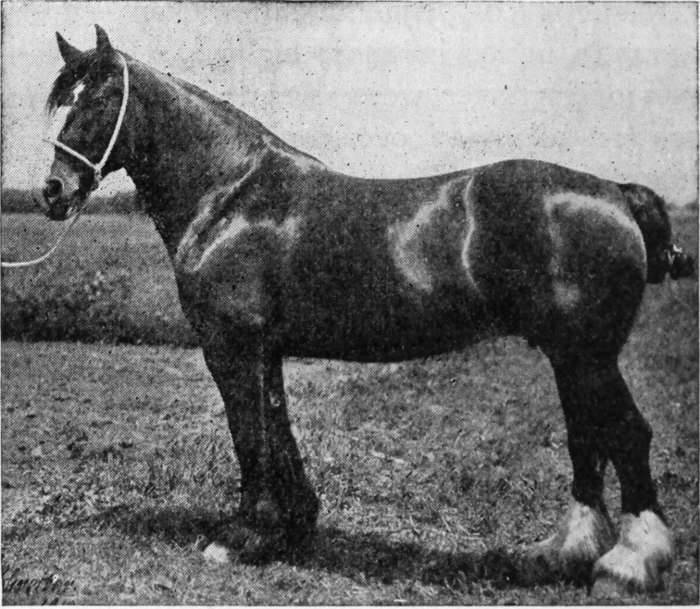
From Davis' Practical Farming
Pure Bred Clydesdale Draft Horse
Another small, pony is the Norker horse of Norway, a strong little creature, noted for its power of mountain travel and of swimming. The ponies of Iceland are much like these, with thick coats of hair. These get their food in winter by scraping away the snow with their hoofs and eating the thin coat of grass and moss below.
Sweden also has its ponies, as also the mountain regions of Britain and other northern countries; but ponies are not confined to cold regions, for we find them as far south as Italy and Greece, and in the Grecian islands known as the Cyclades is a breed of ponies said to be still smaller than those of the Shetlands.
If we now cross the sea and come to our own country, the United States, we find no native breed of horses, all those we have being of European stock. This may seem strange when it is known that America was one of the native homes of the horse. The ancestors of the horse dwelt here, from little, five-toed animals of the size of a fox to the large one-toed animal of the recent age. All over America horses once spread, from the Arctic Seas to Patagonia, but when white men first reached this soil not a horse remained. They all had gone, no one knows how, and the continent had to be supplied again from European stock.
The horse has long been used in many ways by man; in cart, wagon, and plough; on the race-track and in the hunting field; in war and in peace. It has been man's great aid and helper, and through all the ages until less than a century ago it was the fastest means of travel or of sending news. Up to about 1830 all land travel was on horseback or by coach, or else on foot. Then the[70] locomotive came and brought a great change. It was later still when men began to send news by lightning express over the telegraph wire. In early days in our country the mails, which now go so fast, were carried by old men on horseback, who spent the time in knitting stockings as they jogged along slowly over the rough roads.
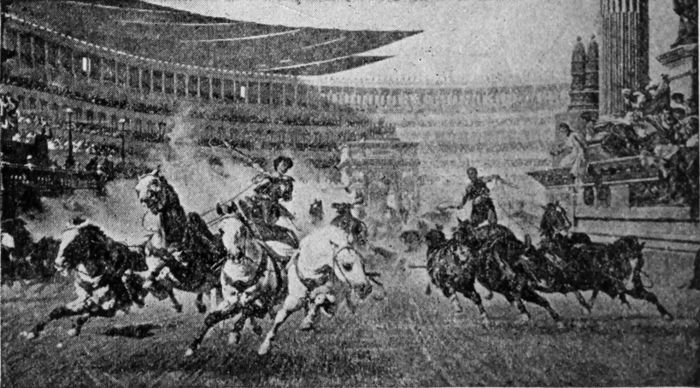
A Roman Chariot Race
The horse has long been used not only in travel but also in sport, as a hunter and racer. When we read the story of ancient days and of the old Greeks and Romans we find many tales of chariot races. These old nations had great oval buildings, with thousands of seats, and a long oval race-track around which the horses had to run several times to finish the race.
These were not horseback races, like those of to-day, but races with chariots like those used in[71] war. Each chariot was drawn by four swift horses and driven by a man who stood upright with reins and whip in hand and drove his horses at full speed round the track. The great and rich people took part in these races and many thousands of lookers on cheered them wildly as they sped onward like flying eagles. If any of you should like to read a good story of an ancient chariot race you can find one of the best in General Lew Wallace's novel of "Ben Hur."
In the Middle Ages riding was done on horseback, and when carriages and coaches were brought into use people despised those who rode in them, calling them weak and lazy. So in those days the racing was on horseback, as it still is in most cases. Many of these races went on in the open country, through rough fields and over streams. They were called "clock races," for the prizes were little wooden clocks, or clock towers. These were afterwards made in silver, and from them came the name of "steeplechase," by which such races are now called.
Regular race-courses began in England in the reign of James I., after 1600, and in later years many Arabian horses were brought to that country and racing became a common sport. One of the most celebrated of those early racers was Eclipse, a horse never beaten and never needing whip or spur. Since then there have been many famous racers, and racing has become very popu[72]lar in all parts of Europe. A bad feature of it is the habit of betting on the speed of horses, by which many men have lost all their money.
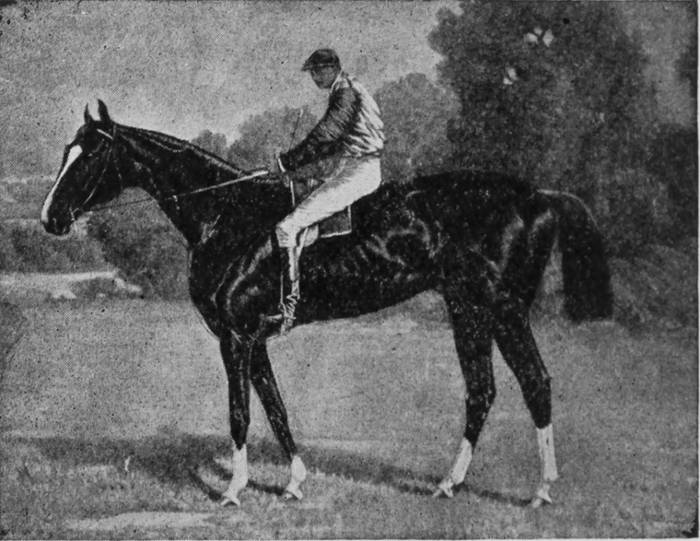
Thoroughbred Racing Horse. A Trained Horse of This Breed is the swiftest of all Animals
Racing was early brought over to this country, and was common in the South in the times of the colonies. It is still kept up. The trotting horse has been developed in the United States until now we have the best trotters in the world. In the British islands, as you may know, the racing horses are made to run, or gallop, quite a different pace from the trot.
The trotting horses of this country began with a fine English horse named Messenger, born in 1780, of Arabian stock. In 1806 it was thought[73] splendid when a horse trotted a mile in 2.50 (2 minutes and 50 seconds). There are now trotting horses which can make a mile in less than 2 minutes. Running is a faster pace and a mile can be made in less time, but Americans like trotting better.
Shall I say something about the use of the horse in hunting? This has long been a common sport in England and Ireland, much more so than in this country. The owners of large estates in the British islands often keep large packs of hounds, trained to chase the fox or the deer, and known as fox-hounds and deer-hounds. Their stables are also filled with horses, trained to run at full speed over rough country and jump high fences and wide ditches.
The hunting of deer and hares is an old form of sport, centuries old, but now fox-hunting is liked better, and great care is taken to protect the foxes for the use of the hunters. Fox-hunting is very hard work for horses and only a good horse can be used as often as twice a week in a fox-chase. There is a story of a deer hunt by the king's hounds and horses where the chase was kept up nearly five hours over wild country. It was so hard on horses and men that many of the riders had to give up, two horses died in the field and seven others during the week. A run of this length over rough ground, with all sorts of obstacles in the way, will kill or badly injure the strongest horse.
Trained hunters can do wonderful feats of jumping over fences and ditches, but this leads to many accidents, and the injury or death of horse or rider in the hunting field often takes place.
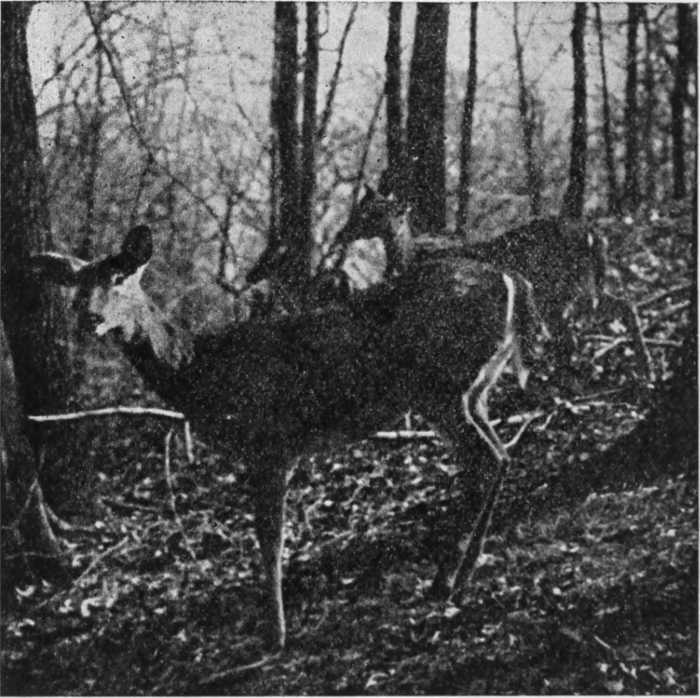
Virginia Deer
In far past times the horse was used in war far more than in our days. Men can now kill one another fast enough without the use of horses, but large numbers are still used in the army, to haul wagons and guns and for those who fight on horseback.[75] In ancient days no saddle was used, soldiers riding their horses bareback, though the great men of the armies rode in war-chariots. The old Roman horsemen did not use bits or bridles, but guided their horses by a headband which pressed on the nose, the reins being fastened to rings on this band. In later Roman times the saddle was used, but the Germans they fought with still rode bareback or used the skin of an animal for a saddle. They did not use stirrups. It was the same with the great Tartar riders, who came from the steppes of Asia and conquered great part of Europe and Asia.
In the days of chivalry, when the knights wore steel armor and used heavy harness, large and strong horses had to be ridden, but in later days much lighter horses served for the soldiers' needs. Those who have read of Napoleon's wonderful campaigns know how much use he made of his cavalry, and many horses are still used in war, though not so many as of old.
If now we leave the story of the war-horse and the racer and hunter and come to that of the working-horse we meet with an animal in which strength and pulling power are of more account than show and speed. For ages past the horse has worked faithfully for man, in the farming field, along the country road, on the streets of the cities; hauling the plow and harrow in the field, the wagon and cart along the road, the carriage,[76] car, dray and other wheeled vehicle in the street. And its life has often been one of much suffering, and still is in some countries, for there are nations in which the poor, patient horse is treated with great cruelty.
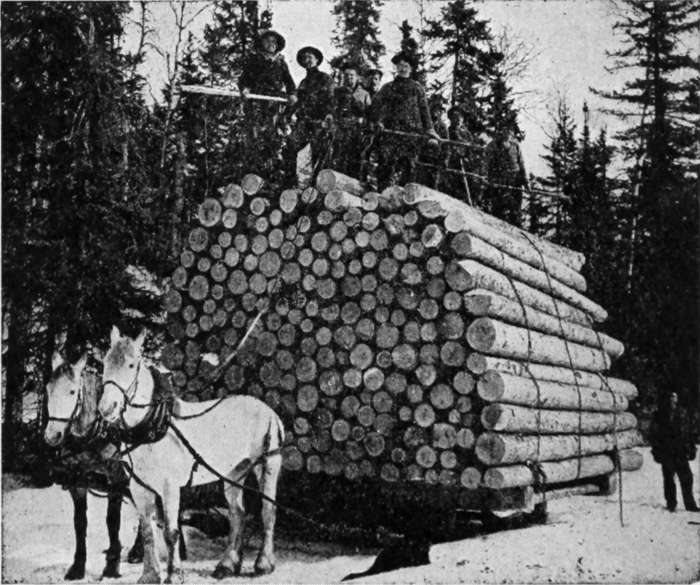
A Logging Team with a Heavy Load
But in these days man has much less need of the horse than of old. Once it did nearly the whole of man's hauling. Now the powerful locomotive takes its place. In city streets the electric car saves the horse from much of his former labor, and the automobile and auto-car are taking the place of the horse for riding and hauling. Yet[77] horses are still in use in large numbers and it will be long before man gives up this useful friend and helper.
The taming of wild horses is no light task. It is one that needs the greatest skill and daring. The lasso, a long, strong rope with a noose at its end, is the weapon of the tamer, with which he can bring down the strongest and wildest animal. Chasing the wild horse on a tamed one, trained in the art, the skilled rider, when near enough, will fling his lasso with wonderful skill and rarely fails to catch the fleeing animal in its strong noose. The horse he rides knows well its duty, which is to pull back on the rope and check the flight of the frightened creature.
To bring the wild captive to the ground is only half the labor. It must be saddled and bridled and ridden until it is worn-out and its wild spirit gives way. It will plunge and rear, whirl round and kick in all directions, even roll over and over, in a mad effort to throw the rider from its back. Only when completely subdued will it yield, but once tamed it may become a very faithful friend and servant to its tamer.
Bucking is one of the ways a wild horse seeks to get rid of his rider, and it takes a man of great skill to keep on the back of a bucking horse. Lowering its head between its fore-legs, it gives[78] a wild leap upwards and comes down with a smash of its hoofs on the ground. The man that can keep in the saddle through two or three of these jumps must make himself part of the horse.
The men who do this are splendid riders, and the cowboys of the plains, who have to take care of the great herds of cattle, almost live on horseback. Such a man can often bend over from his horse, reach down, and pick up a small object, such as a glove, from the ground while riding at full speed.
Every young horse has to be broken to harness before it is fit for work. The freedom which it has been given in its youthful days must come to an end, and this it does not like. For a race-horse the breaking is done when it is about a year and a half old, but for a working or coach horse it is left until it is three or four years old.
The horse-breaker must be gentle and patient or he may spoil the temper of the horse. He must get the colt used to be touched and to feel the halter. After that he leads out the young animal with rein and halter. The next thing is to teach the colt the feel of the bit. A bit may be put into its mouth every day while it is in the stable, so as to accustom it to the feel of the metal. It is then taken out and driven with long reins fastened to the bit, and taught to move to the pull of the rein. After this the horse can be harnessed and put to work.
All this takes much time and trouble and it is only done with fine horses, other horses being broken with less pains. But if the animal is high-bred a quick breaking may spoil its courage or ruin its temper.
Would you not like to hear some more about the Arabian horse, the noblest and best of his race? I have told how all our best racers are of Arab stock and how dearly the Arab loves his horse. A child of the desert, often having to go long and far without food and under a blazing sun, the horse becomes very hardy.
It may be tied by all four legs to stakes set in the ground and kept there for many hours, the sun burning hot, yet if now its legs are set free and its master springs upon its back it is as full of life and spirit and as eager for a wild ride as if it had been taken fresh from the stable.
The comrade of its master by day and night, his support and comfort, ready to go without food or drink in his service, the horse and its rider grow more like two lovers than like master and servant. The poverty of the Arab may at times force him to sell his horse, but it is like selling a part of himself.
"My eyes! my soul! my heart!" he will say, "must I be forced to give thee a new master, and not keep thee myself? I am poor, my antelope;[80] I brought thee up in my dwelling as a child; I did never beat or chide thee."
Then he will embrace the noble animal, wipe its eyes with his handkerchief, rub its glossy skin with his sleeve and remain long talking to it as if he was parting with his dearest child.
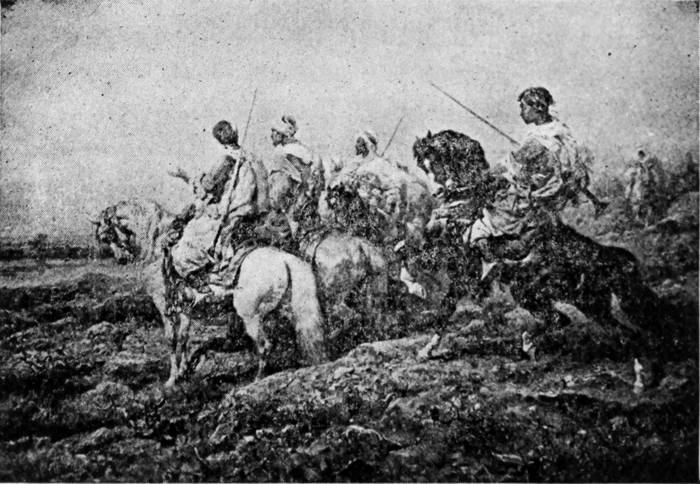
The Famous Arab Steeds and Desert Riders
"When I was at Jerusalem," says Chateaubriand, "the feats of one of those steeds made a great noise. The Bedouin to whom the animal, a mare, belonged, being pursued by the governor's guards, rushed with him from the top of the hills that overlooked Jericho. The mare scoured at full gallop down an almost perpendicular declivity without stumbling and left the soldiers lost in admiration and astonishment. The poor creature,[81] however, dropped down dead on entering Jericho, and the Bedouin, who would not quit her, was taken, weeping over the body of his faithful companion. Ali Aga showed me, in the mountains near Jericho, the footsteps of the mare that died in the attempt to save her master."
Here is one more story of the Arabian horse. "When the envoy," says Sir John Malcolm, "was encamped near Bagdad, an Arab rode a bright bay mare, of extraordinary shape and beauty, before his tent until he attracted his attention. On being asked if he would sell her—
"'What will you give me,' was the reply.
"'That depends upon her age; I suppose she is past five.'
"'Guess again,' said he.
"'Four?'
"'Look at her mouth!'
"On examination she was found to be rising three. This, from her size and fine shape, added much to her value.
"'I will give you fifty tomans,' said the envoy. (The toman is worth about five dollars.)
"'A little more—if you please.'
"'Eighty—a hundred.'
"He shook his head and smiled. The officer at last came to two hundred tomans.
"'Well,' said the Arab, 'you need not tempt me farther. You are a rich elchee (nobleman); you have fine horses, camels, and mules, and I am[82] told you have loads of silver and gold. Now,' he added, 'you want my mare, but you shall not have her for all you have got.'"
The horse has a mind of its own, and now and then lets us see that it can think, but it does not seem to have as good brain-power as the dog or the cat. There is much reason for this. The horse eats grass and does not need to think how to get its food. The dog and cat eat meat, and in their wild state have to catch other animals for food. To do this they have to use tricks and plans which need thought and thus their minds are kept busy.
Also they are in danger from other animals. Take the fox, which is a sort of cousin of the dog. When chased by men and dogs it has many ways of getting away from them besides running. This is not the case with the horse, which is one of the best of runners and trusts to its heels instead of its brain to escape from its enemies. So in its wild state it does little work with its brain.
The horse is a timid animal and easily scared. And when in a state of fright it seems to have no power of thought. All it does is to run in a mad way, rushing along over roads and streets without heed of where it is going, and sometimes knocking out its brains against a post or wall. You will not find a scared fox or wolf show such lack of sense as this. They never get into a wild panic like the horse.
Thus there is very little in the life of the horse to make it think. Yet it can think to some extent, as may be seen from a few anecdotes. It can also be taught to do tricks that need some brain-power. I think you will like to read some stories of horse-thought.
The horse has a good memory, as any one can see when riding over roads which it travelled long before. There are many stories of men trusting to their horses when they were in a dangerous place, and in this way being brought out all right. A friend of Darwin, the naturalist, wrote him this in a letter:—
"I want to tell you an instance of long memory in a horse. I have just driven my pony down from London here, and though she has not been here for eight years she remembered her way quite well, and made a bolt for the stables where I used to keep her."
This is only one out of many cases that could be told. A horse driven by a doctor or milkman does not need to be drawn up before certain houses. It knows just where to stop. There is a story told of a gentleman who was in the habit of stopping his horse to give money to every beggar he met on the road. He loaned or sold this horse to a friend, who soon wrote to him asking him to take his horse back again.
"I cannot pass a beggar on the road but the old fellow will stop and will not start again until[84] I have given the man something. If I have no money I have to pretend to give before I can get him to move on."
Some horses have the sense to help themselves in various ways. One of these learned how to step out of its halter when the coachman had left it for the night. Then it would pull out the sticks in the pipe of the oat-bin so as to let all the oats run down over the stable-floor. Of course, it had seen the coachman pull out these sticks and knew that this was the way to get a free lunch. The same horse would also turn the water-tap to get a drink and pull the window cord to open the window on hot nights.
Not many horses are as smart as this, yet numerous tricks played by horses could be told. There is one told of a horse which, when turned into a field where there was a pump, soon found out how to get water. He would take the pump-handle in his mouth and work it with his head until he had all the water in the trough he wanted to drink. Of course, he had seen men work the handle in this way.
A number of stories could be told of horses which went themselves to the blacksmith shop when their shoes were out of order. One is of a Shetland pony which came to a blacksmith shop a long distance from its home and thrust its head in the door. The blacksmith drove it away but it soon came back again. Then the smith looked[85] at its feet and found that one shoe was gone. He made and put on a shoe and then waited to see what the animal would do.
"For a moment it looked at the blacksmith as if asking whether he was done. Then it pawed once or twice to see if the newly-shod foot was comfortable, and finally gave a pleased neigh, lifted its head, and started homewards at a brisk trot. The owner was much surprised to find the horse at home that evening, fully shod, and could not understand it until the smith had told him the story of his pony's wit."
One of the smartest tricks we have met with is told of a mule, an animal which is not supposed to have the sense of a horse. It belonged to a gentleman living at Iowa City, and was an expert at getting into mischief. It took every chance when the yard-gate and barn-door were open to slip in and steal a mouthful of oats. One morning it was found in the barn with the gate shut and latched and no one could tell how it got there. This went on for some time, until a watch was set and the smart mule was "caught in the act."
This is the way it worked. It would reach over the fence with its head and lift the gate latch. Then when the gate swung open it would go through into the yard and back up against it, pushing it to till the latch caught. This done, it went to the barn, pulled out the pin that held the door, and walked calmly in. The owner says: "I[86] am of the opinion, had not discovery of the trick prevented, it would soon have occurred to him to retrace his steps before daylight, in order to avoid the clubbing which the stable boys gave him in the morning."
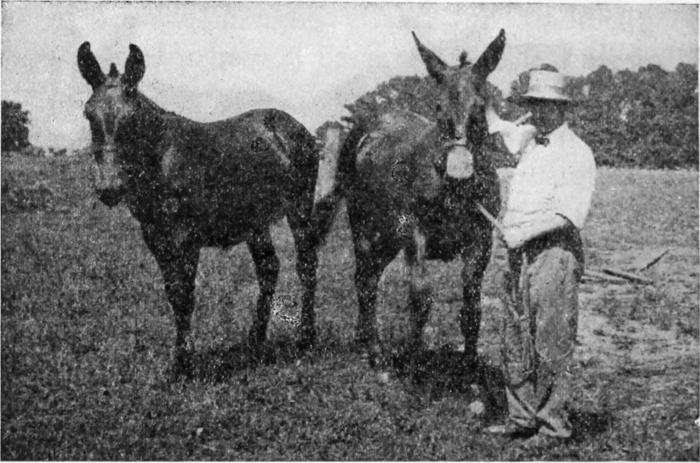
A Pair of Prize Mules
The animal called the ass is a near relation of the horse, one best known to us under its common name of Donkey. It is like the horse in some ways and not like it in others. The ass is much smaller than the horse, being nearer the size of the pony. It has a heavy head, thick lips, long ears, and a tail not covered with long hair like the horse's tail, but with a tuft of hair at the end like that of a cow. A decided difference is in its[87] voice, the bray of the donkey being an ear-splitting sound, not at all like the neigh of the horse.
The wild ass is found through all parts of Central and Southern Asia and also in Northern Africa. It is spoken of in the Bible. The book of Job praises this animal for its love of liberty. Job says of it: "He scorneth the multitude of the city, neither regardeth he the cry of the driver. The range of the mountains is his pasture and he searcheth after every green thing."
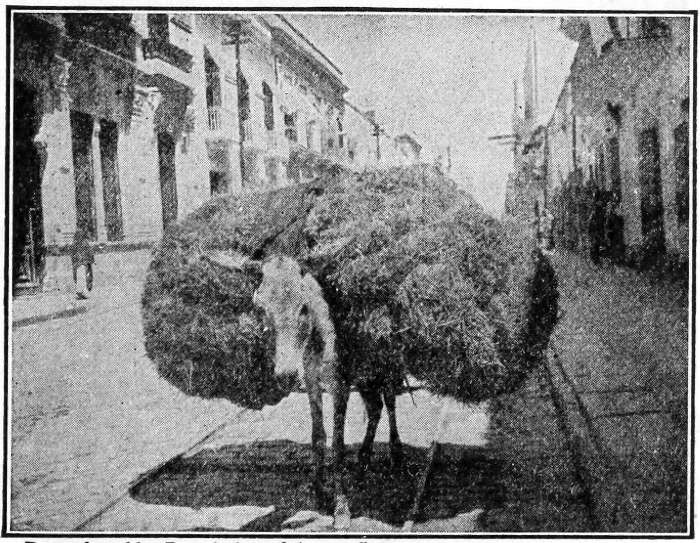
Reproduced by Permission of Amer. Conservatory
Mexican Donkey Waiting for the Last Straw
That is a good picture of the wild ass, for it seems to like every green thing. It eats the bitter herbs of its favorite regions, the mountain spinach, the dandelion, the thistle, and the witch grass, and drinks the salt water of the Caspian Sea as readily as fresh water. It is taller and stouter[88] than the donkey, very active and able to bear fatigue. Its winter coat resembles that of a camel, being long and fleecy, but in summer its hair is soft and silky and silvery white beneath.
The Tartars and Persians kill and eat this animal, but it has sharp eyes and keen ears and is a swift runner, so that it is hard to shoot. When taken young it is easily tamed, and if well fed grows to be a strong and handsome animal which sells at good prices.
Such is the fine animal which has been turned into the dwarfed and stupid donkey of Europe. To be dull and obstinate is not native to this animal. Its lack of sense comes in great part from the way it is treated and its being taken to a climate too damp and cold for it. In the warm, dry regions of the south it is a finer animal and gets better care, and here the people often pet and love their donkeys.
In China and Persia there is a fine race of asses, used only for riding, and these are so thick in Bokhara that the streets are often crowded with them. They are of many colors, white, black, brown, blue-gray, etc. The donkeys of Egypt also are handsome animals, with an easy gait that makes them much liked for riding. Still handsomer are those of Upper Egypt and Nubia, which are such fine creatures that they sell for more than horses.
In the western states of this country and in the[89] Spanish republics is a very small donkey, called the Burro, much used as a carrier of loads in the mountain regions and in the streets of cities. There are also great numbers of wild asses in parts of South America, Patagonia having very many of them. They were once so abundant in the Cape Verde and Canary Islands that they were hunted and killed like beasts of game. Aside from their flesh, which is much liked when they are young, the skin is of value, being made into parchment, vellum and shagreen.
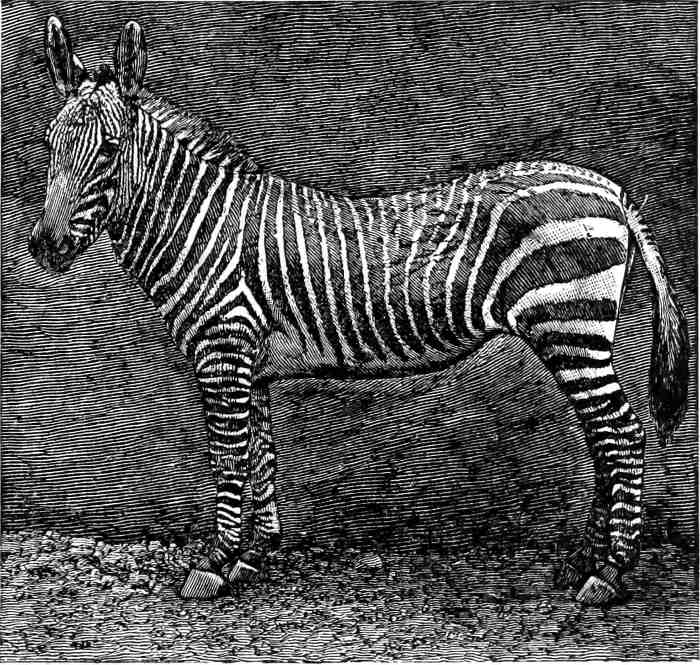
The Striped Zebra of Africa
The Zebra, one of the most beautiful of animals, from its handsomely striped skin, is a member of the horse family, but one of which we do not need[90] to speak, since it is found only in a wild state. It has in some cases been tamed and trained to harness, but it is an obstinate and hot-tempered brute, so that few have tried to tame it.
Another striped animal of Africa rather like the zebra, is the Quagga, but this has been hunted and killed till now none of them can be found. Its name came from its cry ("quag-ga quag-ga"), as different from the neigh of the horse as from the bray of the ass.
A cross has been made between the zebra and the horse, which has been named the Zebrule or Zebroid. These have proved strong and easy to train for harness and saddle. There are several of them now in the government collection of animals at Washington, and some time they may prove useful.
But the best cross-breed is that between the horse and the ass, well known to us all as the Mule. The breeding of mules has been carried on from very old times and is now common in many parts of the earth. It yields an animal which is cheaper to keep than the horse and better fitted for many kinds of work.
I hardly need tell you what the mule is like, for all of you have often seen this ugly and at times very obstinate, but hard-working brute. The mule is much like the horse in size and shape, but it has the long ears, the tufted tail, the thin, wiry legs, and the narrow hoofs of the ass. And[91] while its coat is like that of the horse, its voice comes near that of the ass.
The mule is like the ass also in being strong, hardy and not given to disease. Even when thirty years old it often shows no sign of age. Thus it is useful for more years than the horse, eats less, and is fit for work not suited to the horse.
The mule is of great use in carrying loads over mountain paths. It has a firm, sure foot and can carry loads of five hundred pounds for weeks at a time over pathless hills. The planters of the South could not do without it in their cotton and sugar fields and it takes the place of the horse for much of the street work of cities.
This is not all. Mules are often used for riding and are very good for this. They are also used in carriages. They are raised in large numbers in Spain, where fine ones bring high prices, selling from $150 to $350.
We should hardly look to the donkey and the mule for signs of powers of thought, but it is likely that they are equal to the horse in intellect. The story of a gate-opening mule, given above, goes beyond anything we have found said about the horse, and it is very likely that all those members of the horse tribe, which are much alike in habits, are also much alike in thought powers.

Now we come to the two-toed animals, those called the cloven-hoofed. Looking at our own arms and legs we find five toes on each foot and five fingers on each hand and might fancy that this is the natural number. We find it to be so with the monkeys and with many other animals but we soon find some with fewer toes. Thus the dog, while it has five toes on its fore feet, has only four on its hind feet.
In the tapir and the rhinoceros we meet with three-toed animals and soon come across two-toed and one-toed animals. The two-toed are very common, for we find them in the sheep and cattle of our fields, the pig of the barnyard, the camel, the deer, the antelope, and several other kinds. As for the one-toed, their story has just been told.
Is it not worth knowing that the fewer toes an animal has the faster and longer it can run? We find this in the one-toed horse, and its cousins, the ass and the zebra, the greatest runners of all animals. Next to them come the two-toed animals. Of these the deer and antelopes are fast[93] runners, though some of them run very little. We do not find many runners among the five-toed animals. Those of the cat tribe are better at jumping than running. In the dog tribe, in which are the wolves and foxes, there are good runners, but these animals trust to their wits as much as to their legs, catching their game often by cunning tricks.
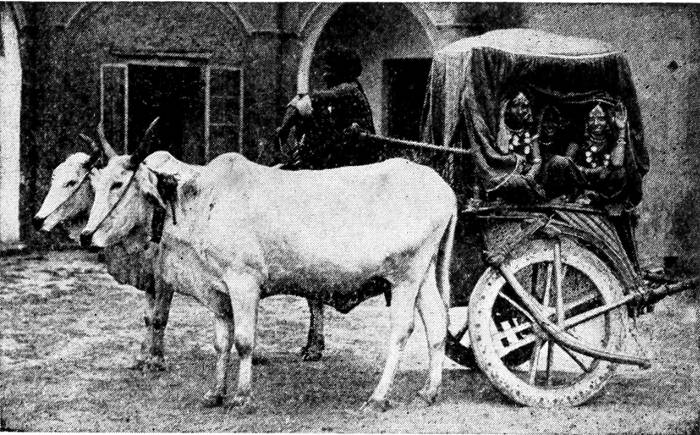
Reproduced by Permission of the Philadelphia Museums
The Native Ox Cart of Delhi, India
Another matter of some interest is the fact that all the one-toed animals are much alike in form and habit, while the two-toed differ so much that we can find little or no likeness between them. Take the ox, the goat, the pig, the buffalo, and the camel. Are these alike in anything except their split hoofs? The fact is that the single hoof seems to fit animals only for running, while the double hoof fits them for various kinds of life. We find[94] them at home in the desert, on the mountains and plains, in the forest depths, and in swampy regions, their forms and habits changing to suit the kind of life they lead.
Many of these animals have been tamed and made to serve man in various ways. We can see them all about us, some of them kept for food, some for work in the field or on the road. Let us take a look at those used for work.
That great lumbering beast we call the ox, with his long horns and his slow, lazy walk, is one of the strong workers of the world. Go where we will we see him, pulling the plough or the cart and wagon. If we leave home and go over the world we shall find many people using the ox. In South Africa we may see long teams of them pulling the heavy wagons of the farmers. In India the Hindu people eat no meat, but they keep many cattle to work in their fields. It is the same in many other countries both of the Old and the New World.
Among our own people the ox is much used as a working animal. While large use is made of the horse and donkey, the strength and patience of the ox give it great value and it is used for many kinds of work. Though a slow, plodding animal, it can pull a big load by the aid of its wooden yoke. In the fields of the South the farmers and planters could not well get along without it.
Our ox is not the only worker of his kind. In far-off Asia there are two other animals which are cousins of the ox and are made to work like him. Their names belong to the end of the alphabet, for they are called the Yak and the Zebu. The Yak is found in Tibet and other parts of Central Asia, where it is tamed and put to work, but not to pull the cart or the plough. It can carry heavy loads and travel twenty miles a day.
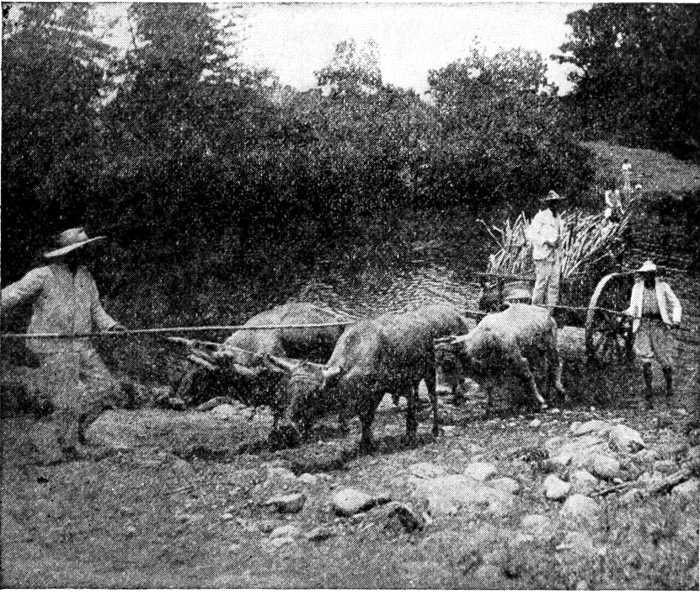
Hauling Sugar Cane in Puerto Rico
This animal has a thick coat of long, silky hair, which hangs nearly to the ground. Ropes and cloth are made from it. The tail is just a great[96] bunch of long hair. The Yak does not bellow like the ox but gives a short grunt. Its milk is very rich, and fine butter is made from it.

The White Yak of the Asiatic Mountains
The Zebu is kept in India, China, East Africa and the islands of the eastern seas. It is much like the ox but has a big hump of fat on its shoulders. Sometimes there are two humps. In this way it is like the camel. Some of the zebus are larger than any oxen and some are only as big as a large mastiff dog. They are quiet, gentle animals, made to work in the plough and in the road and also used for riding. They can travel from twenty to thirty miles a day.
There is another animal much used for the same kind of work, the Buffalo. This is not the animal long known in our country as the buffalo, but which is really not a buffalo, its proper name being[97] bison. It is not a savage animal and could easily have been tamed and put to work. But as the settlers in the colonies had the ox and the horse already trained to their work no one tried to tame the bison. Since no one cared for these great animals, the hunters got after them and shot them in such vast numbers that now they are nearly all gone. Where fifty years ago there were millions of them in the West, to-day there are only a few hundreds to be found anywhere.
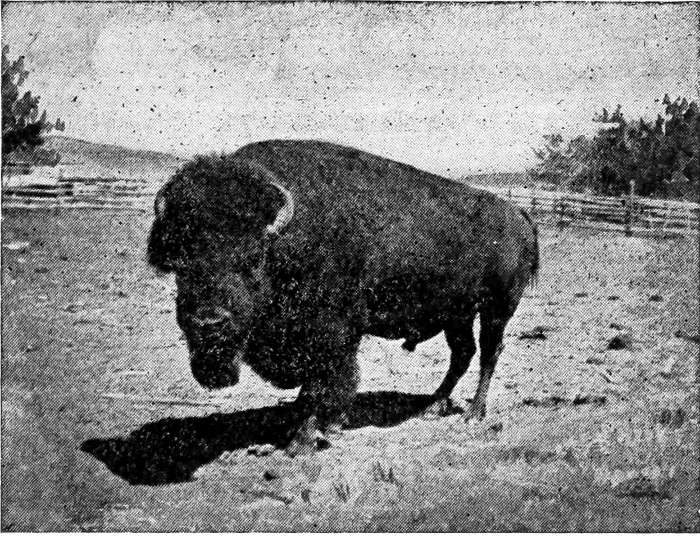
The American Bison alone on the Prairie
The real buffalo is found in the south of Asia and Europe, where it is tamed and put to work, much use being made of it. There is another species found in Africa which is very fierce and savage, hunters often being more afraid of it than they are of the lion. The buffalo of India is also savage in its wild state and the princes of that[98] country set it to fight with the tiger in their public shows. Armed with great, sharp horns, it is more than a match for the tiger.
In its tame state the buffalo is a very docile animal when it is well treated, but will not bear bad treatment. In size and shape it is like a large, clumsy ox, but it is much stronger than the ox and can carry or draw a much heavier load. Thus it is of great value as a working animal.
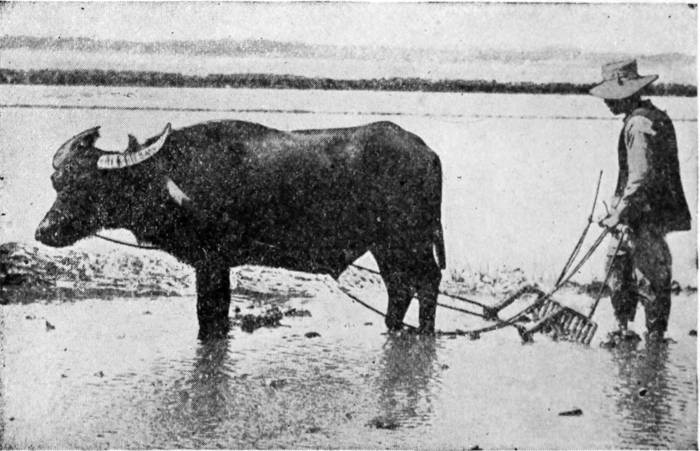
Reproduced by Permission of the Philadelphia Museums
Cultivating Rice Field with the Chinese Ox. Hawaii
It is used in many parts of the East. The farmer in the Philippine Islands could not get along without it, as it is his common helper in the fields. Known there by the name of Carabao, it is loved by its owner and played with by his children, and is the plough-horse of the islands. It[99] can be driven by a mere child. The plough used there is no more than a heavy stick of wood sharpened to a point at one end, with a handle for the farmer and a beam to which the buffalo is harnessed.
This is the way in which the rice fields of the East are worked. The buffalo is also kept in Egypt, Greece, Italy and some other countries and everywhere is a very useful working animal. But it has one habit that needs to be looked after.
By nature it is a swamp dweller, and can keep its head under water for two minutes at a time, feeling at the bottom of pools and streams for certain favorite plants. If it is to be kept in health it must have its daily mud-bath. It loves to fling itself in the mire and shuffle about until it is covered with mud from its tail to its eyes. When it has dried itself in the sun it looks like a huge clay image. It has its reason for this, for in those swamp regions are millions of stinging flies and the mud is intended as a coat of armor.
Strong as the buffalo is, it cannot work for more than two hours without rest, and will not live long if kept at a distance from streams. Its fondness for mud and water is the habit that needs to be looked after. It is not safe to load it with any goods that are likely to be spoiled by water, for it will lie down with its load in any stream it comes near.
Travellers who have ridden on the Philippine Carabaos have found out this habit in a way not to[100] their liking, for they have more than once been flung suddenly into a mud-bath by their ugly steeds. If the animal sees a bed of mud along the road he is sure to fling himself into it unless kept out by a strong rein. And unless his rider gets off in a hurry he will be treated in the same way. In Italy the buffalo is most at home in the Pontine Marshes, and no one can keep it anywhere unless there are mud and water near at hand.

Reproduced by Permission of the Philadelphia Museums
The Carabao, the Working Animal of the Philippine Islands
While the buffalo is the draught animal of the sultry south and the ox of the more temperate regions, in the freezing north the Reindeer takes their place. Among the many species of deer, some of which,[101] as the moose and elk, are large and strong, this is the only one that has been made to work for man. The people of Lapland could not live without it, and it is also of very much use to the tribes of northern Siberia. We have the same animal in the northern parts of America, where it is called the Caribou, but there it has rarely been tamed and is hunted as game.
The Laplander uses the reindeer as we use the horse and as the Eskimo uses the dog, as a travelling animal. It is strong and swift and can easily draw a weight of two hundred pounds on a sledge. It can travel for a long time at a speed of nine or ten miles an hour.
A rich Laplander is a man who owns a great many reindeer, some of them having herds of two thousand or more. To the men of Lapland, as we are told, "the reindeer serves as a substitute for horse, cow, sheep, and goat." It gives fine milk, is a good traveller, its hair is of use, and its flesh and skin are of much value. Almost every part of the dead animal can be used in some way, so that it serves the Laplander dead or alive.
It is not hard to keep. In the summer it feeds on the shoots of the willow and the birch, and in winter on the reindeer-moss and other snow-covered plants. To get at these it uses both its hoofs and its long, branching antlers in digging through the snow. This is the way in which various hoofed animals keep themselves in the winter, such as the[102] musk-ox of the far north. The horse does the same in such cold countries as Iceland.
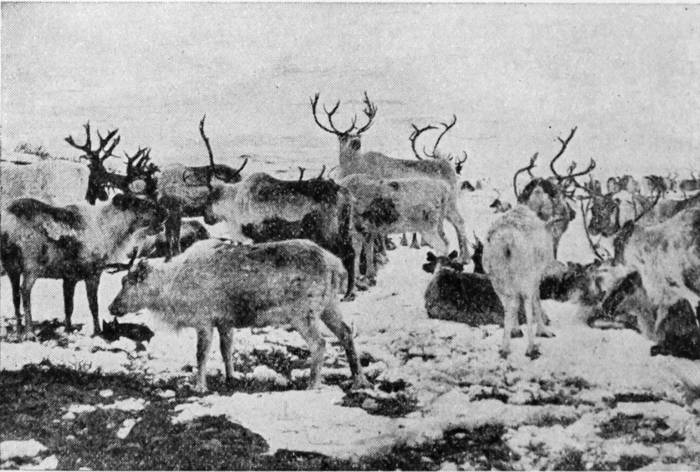
Herd of Reindeer Brought from Lapland for the Use of the Indians of Alaska
As I have said, we have a reindeer of our own in the Caribou, but no one has really tamed it and put it to work. Yet it would be useful in the north of Canada, and reindeer have been brought from Lapland to Alaska and Labrador. They seem to do well there and may in time become of much service to the Indians and to white settlers.
Far away from where we live, in what may be called the world of the East, there are mighty deserts, almost oceans of sand. These are oceans without water, vast tracts of land in which no[103] blade of grass can grow, except where a green oasis rises like an island in their midst. Such a desert covers nearly the whole of Arabia and other wide regions in Asia. On the map of Africa may be seen a still greater one, that which bears the name of the Sahara.
In these deserts no rain falls to water the thirsty soil, springs are few and far apart, and those who travel through them must carry food and water on their journeys. These great sand oceans have their native animal, the humped and long-necked Camel, the "ship of the desert," as it is fitly called, since it carries freight and passengers over the sand-strewn lands as ships do over the wide seas.
An ugly brute is the camel, with its humped back, its long neck, short legs, and bunches of shaggy hair. But ugly as it is the Arab finds something in it to praise, and could not well live in the desert without it. Arabia and the other deserts of Asia are the camel's native soil, and nature has fitted it well for its home in the sands. It does not belong to the Sahara, but was taken there by the Arabs. But it finds itself much at home on that world of sand. It is not well suited for fertile countries, though it is used in India and China to carry loads for their people.
The camel is a two-toed animal but is like the horse in having only one hoof. This is a broad pad or cushion which takes in both its toes and fits it to travel over the soft sand. It is not hard,[104] like the horse's hoof, but elastic so as to yield at every step.
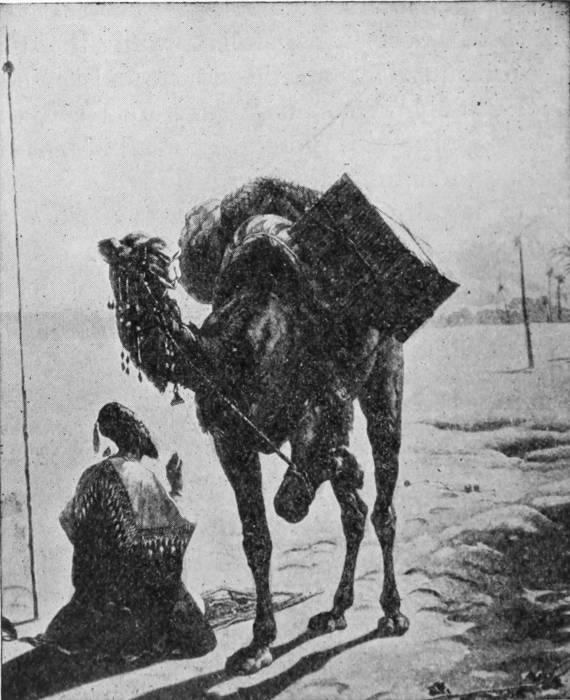
A Sahara Desert Scene. The Mohammedan driver hobbles the animal's foot while at prayer
It is not only by its foot that the camel is fitted to dwell in the realms of sand, for it seems made for the desert in every part of its body. There are two kinds of camels, the Arabian, with one hump, and the Bactrian, of the northern deserts, with[105] two humps, and it is these which give it so ugly a shape.
Are these humps a kind of saddle made for man's use, you ask? Not at all, for the camel had them before there were any men to ride him. They are really food supplies, masses of fat which help to keep the animals alive on long journeys. No wise Arab will set out to cross the desert without feeding his camel until its hump is full and plump, for in this the animal carries its own food. It dines and sups on its hump when there is nothing else to eat, so that the hump shrinks and grows smaller.
But how does the camel find water to drink in the dry desert? Has it a water supply as well as a food supply? We should not think this possible, yet it has. In long journeys it needs water as well as food and inside it is a well-filled water vessel. There are "water-cells" in its stomach, in which about a gallon and a half of water can be stored away, enough to last for three days if no water is found. At times, when the rider is in great need of water, he will kill his camel so as to get this store from its stomach.
There are still other ways in which the camel is fitted for a desert life. Thus it has fine powers of sight and smell. It can smell water when it is more than a mile away and if tethered will break its halter and run in a straight line for the well or spring. Its nostrils are mere slits, which it can[106] close when the wind fills the air with sand. At times a burning wind called the simoon blows fiercely across the desert. Then the camel falls on its knees, stretches its long neck like a snake along the sand, and closes its nostrils to keep out the sand carried by the wind. Thus it stays till the storm is past. At the same time the driver wraps his face in his mantle and hides himself behind his beast.
There is one other thing to say. The camel likes good food when it is to be had, but it can live on any kind of plants. It will eat anything in the way of leaves, shrubs, dry sticks, or vegetable matter of any sort, and can live on food on which many animals would starve. You may see from all this how wonderfully it is fitted for a desert life.
Are we not right in saying that without the camel the Arab would find it hard to live in the desert? For ages past long caravans of camels have been crossing the sea of sand from the fertile lands of the nearby countries to the oases where the settled Arabs dwell. Not until the camel is four years old does its training as a carrier of loads begin. Then it is taught to kneel down and to rise at a given signal, light weights being at first put on it and heavier ones afterwards.
It can carry heavy weights, its loads ranging from 500 to 1000 pounds, some breeds of camels being much stronger than others. In desert journeys it is expected to carry this load twenty-five[107] miles a day for three days without drink. The swift animals used for riding will carry their rider with his food and water fifty miles a day for five days without drinking. A camel lives from forty to fifty years, so you may see that it is of great value to its master.

A Rug Laden Caravan
If too heavy a load is put on its back the camel will not rise from its knees; but when once on foot it is very patient and will plod on under its heavy load until it is ready to die. When its load is taken off it does not seek the shade, like other animals, but kneels down in the full glare of the sun, as if it loved the burning sand.
There are almost as many breeds of camels as there are of horses, and the kind used for riding is as different from the load-carrier as the race-horse is from the cart-horse. The burden-bearer has a thick body, heavy feet, coarse hair, and a slow pace. The racing breed is thin of body, fine-haired, and much more elegant in shape. It is as[108] celebrated for its swift speed as is the Arabian horse, and a good animal is able to carry its rider a hundred miles in a day.
While all the single-humped camels are often called dromedaries, it is more correct to speak of the racing camel as the dromedary. An Arab sheik is as proud of a fine animal of this kind as an American or Englishman is of his fine race-horse.
But if any of you should ever be asked to mount a camel it would be wise to decline the honor, unless you are good at holding on, for camel-riding is an art that must be learned. The awkward animal has a swinging and jolting gait that is hard to get used to. During the world's fair at Chicago in 1893 one of the greatest amusements of the Midway was to see people trying to ride the camels which had been brought to the Egyptian section of the fair. It was much better fun for the lookers-on than for the riders. In camel-riding a saddle is not used, as on the horse, but a sort of platform is fastened on the hump.
The camel we have so far spoken of is the one-humped Arabian kind. The two-humped or Bactrian species is larger and stronger but is not nearly so common. It is found in the desert region of the north from the Black Sea to China. Both kinds are found in Central Asia, but the Bactrian goes as far north as Siberia, where the cold is often very severe and it has to live on the leaves and twigs of the willow and birch trees.
Though the camel is fitted by nature for life in the desert, it is much used elsewhere. For ages past it has been the great carrier in Asia, long camel trains, or caravans, taking the place of the modern railroad train. It is also used for pulling carts and for ploughing, in which yokes of four camels may be seen. You could not think of anything more awkward or clumsy-looking than a camel harnessed to a cart.
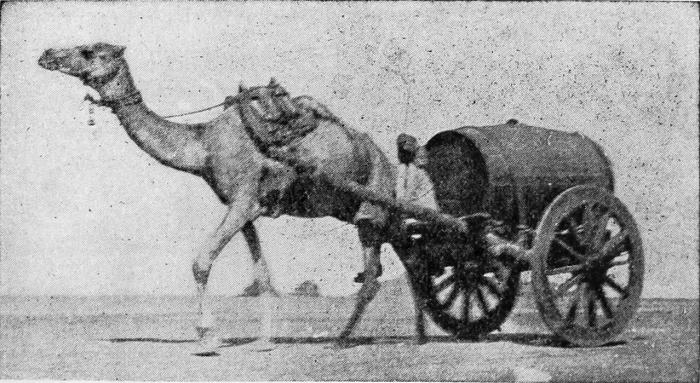
From Madeira's Hunting in British East Africa
Camel Hauling Water. The Camel is Used Alike as a Carrier and a Drawer of Burdens
If any one asks about the intellect of the camel we can only say that it does not show much sign of having any. It seems to be a stupid creature, with only sense enough to protest against bad treatment. In most cases it is very docile but if ill-treated it can be as obstinate as a mule. Also it bears in mind a wrong done to it and will at times[110] wait a long time to revenge itself. The camel-driver knows this and if he thinks the animal is waiting its chance to attack him he will throw his clothes before it. These the animal tosses and tramps on in a wild rage. After that it appears to forget the wrong done it and the man is safe.
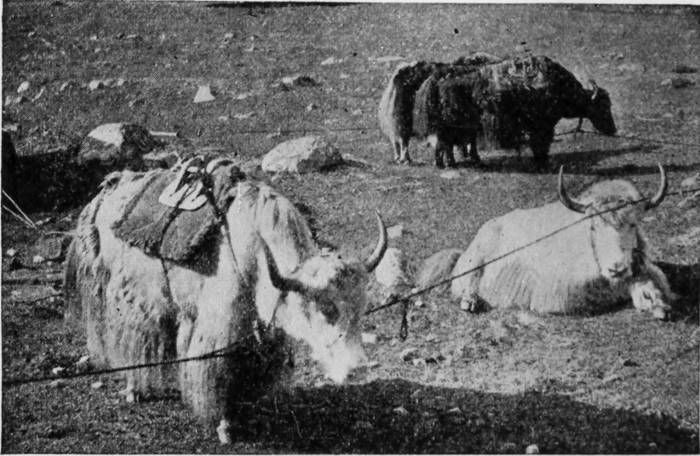
Reproduced by Permission of the Philadelphia Museums
Yaks Picketed near Camp in India
The camel is useful to its owner in other ways than those mentioned. Thus it supplies him with food, the Arabs being fond of the flesh of the young camel, which tastes like veal. Camel's milk is also excellent to drink and can be made to yield butter and cheese. The hair is woven by the Arab into cloths suitable for clothing and for tent covers and the finer hair is used for paint brushes. So living and dead the camel serves his master.
If my readers are now ready to leave the deserts of Asia and go with me to the mountains of South America they will find there the only animals on the earth that are relatives of the camel. How the family of the camels came to be so widely separated no one knows. As it is, we find than on two sides of the earth with no links to join them.
In Peru and Chile there are four different kinds of these camels of the New World, two of which, the Llama and Alpaca, have been tamed, the others being wild. These are not animals of the desert, but lovers of the hills, as they dwell on the highest parts of the Andes. Like the camels of the East, they have long been in the service of man. The Llama was the bearer of burdens for the old Peruvians and is a burden-bearer to-day, though the mule is beginning to take its place.
These animals do not look like the camel. Their backs have no humps and their heads are more like that of the deer. Instead of the small ears of the camel they have erect ears like the mule. But they have long necks like the camel, also cushioned feet and a stomach that is fitted to hold water. This is strange in animals that have no need to store up water. It seems as if the habit of storing water began very long ago among the ancestors of the camel tribe.
The Llama is a much smaller animal than the[112] camel, being about three feet high at the shoulders. It keeps its head raised like a deer and is a gentle and docile animal, though it has a habit that is not much liked by those that make it angry. This is to squirt a mouthful of its yellow spittle into their faces. This has an unpleasant odor and this nasty habit makes drivers careful not to overwork the animals.
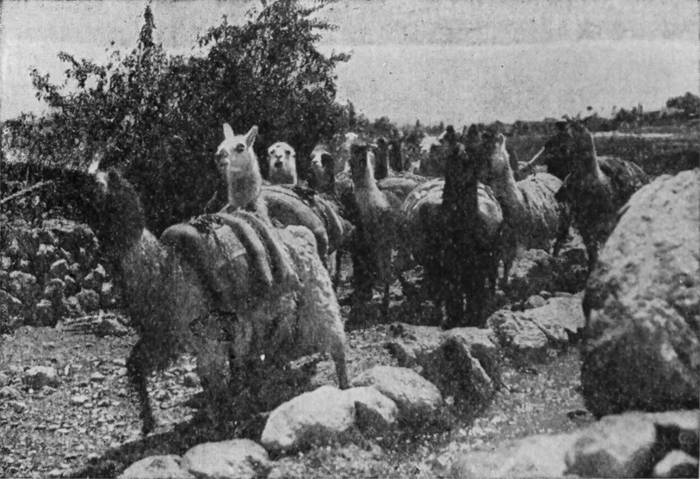
A Llama Train Descending the Mountains of Peru
The Llama is a sure-footed creature, knows how to find food for itself, and can carry a weight of a hundred pounds about twelve miles a day. This makes it very useful for the miners of the Andes, who use it to carry their ore down the rough and steep mountain paths. When the animals are tired they will lie down, and the only way to make[113] them get up is to take off their loads. That is another way they have to make their drivers treat them kindly.
The Alpaca is a smaller animal than the Llama and is not used to carry goods, but for all that it has its uses and is kept in large flocks on the high levels of the Andes. Its value lies in its wool. While the hair of the Llama is coarse and of little use, the Alpaca is covered with a long, fine wool, of a silky lustre, which if left uncut will grow to twenty, and even to thirty inches in length. If cut every year it grows to be about six or eight inches in length. Its color is often a yellowish-brown, but is sometimes gray or black.
For very many years the Indians have made their blankets and cloaks of alpaca wool, and for more than fifty years it has been used in Europe and America to make shawls, coat-linings, umbrella-covers and other goods. The wild species have also a very delicate and soft wool, of high value in weaving, but it is not nearly so long as that of the alpaca.
A fact many of you may know is that nearly all the animals kept by man for work or for food are those with hoofed feet. Among other animals that he puts to work may be named the dog, and this is not used much as a worker. A little has been said in former pages about working dogs,[114] but the only region in which the dog is kept only for work is in the Arctic zone. The dog is the working animal of the Eskimo and the only one. Therefore in speaking of animals that work for man we must not forget the Eskimo dog.
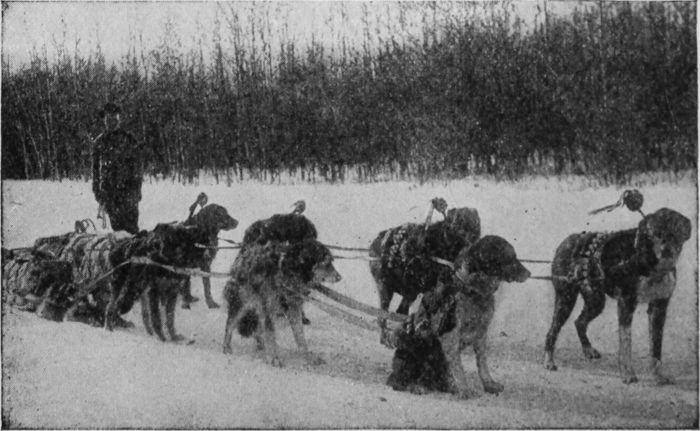
Reproduced by Permission of The Philadelphia Museums
Dog Train Hauling Provision in Northern Canada
These big, strong, savage, thick-coated dogs of the realm of ice, are so much like the wolf that if let loose they would soon begin to make their living in the wolf's way. Their owners do not think of making pets or hunters of them. They simply feed and drive them and keep them in order with the whip. What the Eskimo dog dearly loves is a fight, and they snarl and snap at one another as savagely as any wolf could do. Only the sharp use of the whip can keep them from fighting.
The Eskimos could not live in their cold country without the aid of these hardy animals. No other creatures could be found so well suited to their needs. With their thick and warm coat of hair these dogs can bear the greatest cold, and at night all they need for bed or shelter is a snow-bank into which they can dig and bury themselves. Here they sleep as cosily as if they were in a bed of feathers.
They will eat any kind of meat or fish, and can drag a sledge with great speed and for hours at a time over the ice. Thus it may be seen that the Eskimos and Indians of the north have a useful servant in the dog. They hitch it to their sledges, the number of dogs varying with the load to be drawn. No reins are needed. There is a leader to the team trained to follow a trail and to obey its master's orders. The driver also carries a long, stinging whip with which he is very expert and can reach any dog in the team. If they get into a fight, as they are apt to do even when drawing a sledge, the whip is used to bring them back to their work.
What would travellers in the sea of ice or seekers for the North Pole have done without the dog? It has drawn them and their food in all their journeys over the ice and the Eskimo dog is the only animal besides man that ever reached the Pole. Without its aid Peary, the great explorer, would never have got to the North Pole or got back again to[116] his ship. Is it not well to speak, then, about how the dog helped him in this famous discovery?
When Peary took his ship, the Roosevelt, far to the north, he had on board more than two hundred dogs and plenty of walrus meat to feed them. When he went north over the ice these dogs were used to draw the sledges loaded with food and other supplies. The explorers had to walk; no dogs could be spared to draw them.
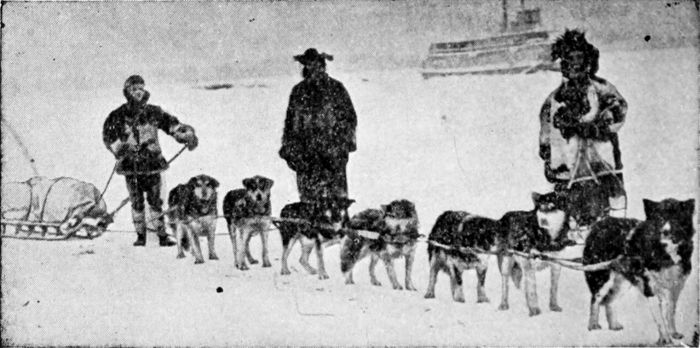
Alaskan Dog Team. The Winter Mail-Carriers
On his last dash to the north, from 87° 57´ north latitude to 90° (a distance of about 140 miles), he had five sledges and forty dogs. The sledges were the pick of twenty-five that had started from the ship and the dogs were the best of all his teams. Also for drivers he had his four best Eskimos. With these sledges and men and dogs he got to the North Pole, which no one had ever reached before, and the faithful dogs shared the glory of the discovery. They came back with him—some[117] of them, for some died on the way. The poor brutes did not know what they had done, and no doubt thought a good meal of walrus meat better than a dozen Poles, either North or South.
Now shall we say something about the South Pole? Dogs have been used there too, but when Lieutenant Shackleton, the English explorer, made his famous journey in that region in 1909, he took with him four of the hardy ponies of the North, thinking they would be better than dogs. But his ponies died, one by one, and he and his men had to drag their sledges back by hand, eating the frozen pony meat as they toiled along over mountains of ice. Later explorers have taken dogs with them as better fitted for the work than the best ponies.
I do not need to tell you what the Elephant is like. Almost everybody has seen this noble creature, the largest of all animals except the whale. It belongs in its way to the hoofed animals, though it has five toes on each foot. For these are covered by a sort of elastic hoof, something like that of the camel, which gives it an easy, springy step. Though its home is in Asia and Africa, it has often been brought to America and shown in menageries and other places. It is a great, clumsy-looking brute, with a long, flexible trunk, ivory tusks, great flapping ears, stout legs and broad hoofs.[118] The tusks, you know, are great overgrown teeth made of hard ivory.
It does not look like an animal that could think, but few of the animals below man have done so many wise and smart things. Only the dog and the monkey are its equals. I shall speak of its thinking powers further on, but here I wish to deal with the elephant as a worker for man.
The wild elephant loves its freedom and fights hard against those who seek to capture it, but when taken and tamed is often very mild and gentle. In India large parties of men, four hundred or more in number, are sent out to drive the wild elephants into great, strong pens that have been built of heavy timbers. Here tame elephants are used to hold the wild ones while they are being tied fast. By these and other means many of them are made captives and they soon become man's willing friends and helpers.
The elephant is made use of in various ways. In ancient times it was often used in war. Troops of elephants were made to rush on the ranks of enemies and kill them with trunk and hoofs. In this way even the Roman armies were put to flight, they being scared when they first saw these huge, strange animals. But they soon learned how to frighten them with torches and drive them back upon their friends.
The elephant has long been used in India as a working animal, and for this its great strength[119] makes it of much use. It can lift and move heavy loads and a common elephant can carry half a ton for a long distance. But they need much care and cost a good deal to keep, for it takes about 800 pounds of fodder a day to feed a large one.
When at work they show very good sense and know well how to do things. You would think so if you could see them at work in piling or moving timber. I fancy you would laugh to see how nicely and neatly they do it and what good sense they show.
The female elephants have no large tusks, so that they can use only their trunks in moving the logs, but the male animals use their great tusks as well as the trunk. They will push logs weighing a ton and a half with ease. If the log has to go into the river they will push and roll it along to the bank, and as it slides down the muddy bank to the water will give it a slap with the trunk, as if to say, "Good-bye, old fellow; there you go."
If the log to be moved happens to be jammed among the others, the wise animal soon sets it right. He will begin by getting his tusks under it and lifting it to the proper height. If the log is a heavy one, he will sink down on his knees so as to get a better lift upon it. It is a lesson in elephant wit to see him stack timbers. He will lift one end of the log nine or ten feet, and put it on top of the pile. Then he will go to the other end and push this forward until the log lies straight.
The driver helps him in this by words and signs, all of which he knows as well as a sheep dog knows the words of the shepherd. The best trained animals are put to work in the saw mills, where they move about with much care among the saws and other machines. One man who saw an elephant laying planks and slats to be sawed, said in a newspaper that he saw the animal shut one eye while it squinted along the bench with the other to make sure the timber was laid straight. Perhaps the reporter had both eyes shut when he saw this.
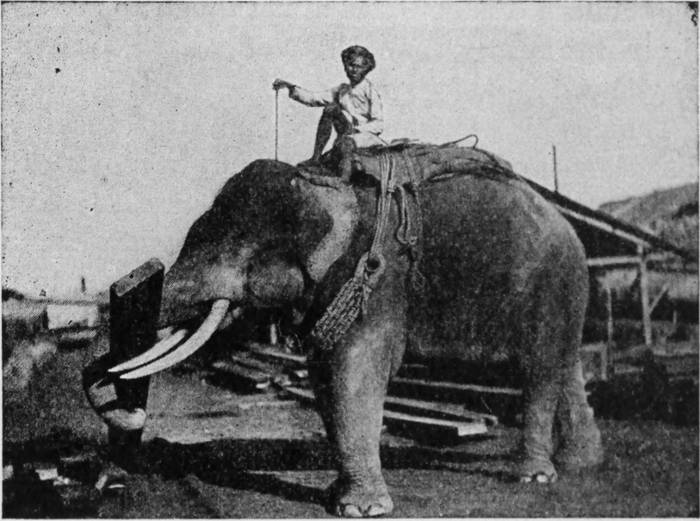
Elephant Piling Lumber. Observe How the Log is Grasped between the Trunk and the Tusks
It must be said that elephants are in some ways[121] like men and boys. There are willing ones and lazy ones; some that like to work and some that hate work. You will see the willing ones drag along a log that weighs two tons without a groan. The lazy ones may be as strong as the willing ones, but they will make a dreadful fuss over a log not half as heavy. They are like boys, too, in the fact that some of them have good tempers while others are cross and surly.
There is one thing more to be said about the elephant. It knows how heavy it is and does not like to go over a weak place. Thus it will not walk over a bridge until it has tried it to learn if it is strong enough, and it will not go into a boat without doing the same. You may see that it has sense enough to take care of itself.
Here is the story of an elephant that had every day to go over a small bridge. "He one day refused to go over it, and it was only by goring him most cruelly with the hunkoss (a sharp iron goad) that the driver could get him to venture on the bridge, the strength of which he had first tried with his trunk. At last he went on, but before he could get over the bridge gave way and they fell into the ditch, which killed the driver and greatly injured the elephant." It is very likely that the wise animal had found it to be weak when he last crossed it and knew it was not safe.
I must tell you the story of some elephants that were with a body of troops in the mountain region[122] of India. In their march they came to a steep place where the men laid a stairway of logs for the elephants to climb up. The first elephant came to it, took a good look, shook his head, and backed off. When the driver tried to force him to climb he would not move, but roared like a scared boy. Only when some change was made in the stairs could he be got to set foot on them, and he climbed up with great care, trying every step as he went.
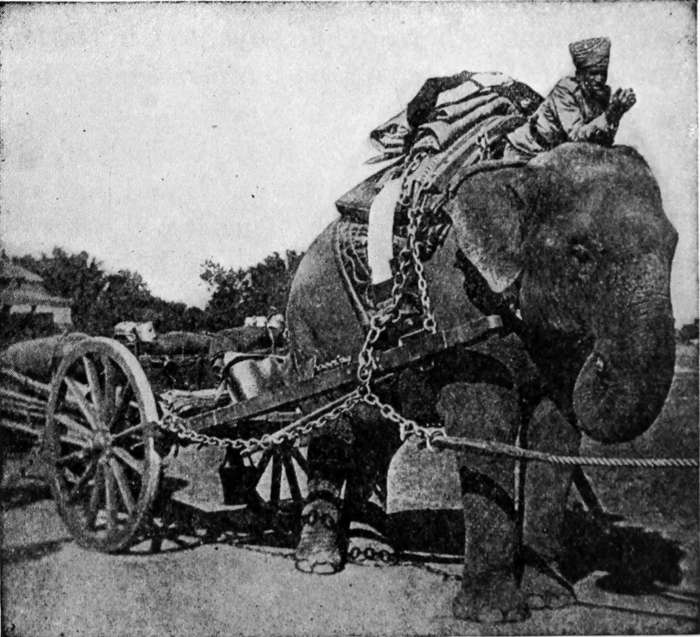
Reproduced by Permission of the Philadelphia Museums
A Military Elephant on Duty, India
When he was part way up he came to a tree which he tried with his trunk and did not like. It seemed too weak. Again he stopped. The driver tried to get him to go on with such words as "My life," "Well done, my dear," "My son," and other kind words of which elephants are very fond, but he would not be got to move. Then force was tried. The elephant roared terribly but would not stir.
At length some other change was made in the logs. This the wise creature tried and then went on until he reached the top. When he got there he showed the greatest delight, caressing the keeper with his trunk and throwing dirt about in the most playful manner.
The elephant that followed was a much younger one. It had watched its comrade go up with great interest, making movements with its head and trunk as if it was helping him. When he reached the top it gave a salute like the sound of a trumpet. But when it was called on to take its turn it was greatly scared and had to be forced to mount the slope. When it got near the top the older animal reached down his trunk and twined it around that of the younger and thus helped him to the summit.
Then the two animals greeted each other in the most friendly manner, as if they were old friends just met. They embraced each other with their trunks and stood for many minutes face to face as if they were talking over what they had done.[124] All this goes to show that the elephant has a good deal of human nature in his huge carcass, and along with it a good deal of sound sense.
The stories just told show that the great beast we are talking about has a keen idea of danger, often a better one than his drivers, and is more careful than a good many men we have seen. We give them as examples of the wit and wisdom of this sensible animal. If we look for stories of this kind among the other working animals, such as the ox, the buffalo, and the camel, we find little show of powers of thought, but of the elephant as a thinker there are very many interesting anecdotes. Some of these you may like to read.
The story has often been told that the elephant, when he wants to get something a little out of reach, will blow on the ground or a wall beyond, so as to drive it inward by the wind of his breath. Here is the story of an elephant in which the cunning fellow took a different way of doing this.
"I was one day feeding an elephant with potatoes, which he took out of my hand. One of them, a round one, fell on the floor, just out of reach of his trunk. After trying in vain to reach it, he at length blew the potato against the opposite wall with such force as to make it rebound, and he then without difficulty secured it." That is much like what a boy does in playing hand ball.
The elephant has a good memory and also a fine sense of justice. It is not a safe animal to play tricks upon, for it does not forget the man who did this and will wait long for a chance to get even with him. Here is an instance told by a Captain Shipp, who wished to learn for himself if the elephant would bear in mind an injury and try to repay it.
One day he gave an elephant a sandwich of bread, butter and cayenne pepper. After he had waited for six months he visited the animal to see how it would act and began to fondle it as he had been used to do. The great beast showed no signs of anger and the captain thought that it must have forgotten him and his pepper sandwich. But suddenly, while he was not looking, the elephant filled his trunk with dirty water and drenched the captain from head to foot.
You may see from this that elephants have very good memories.
One gentleman tells of visiting some elephants in London, and moving out of reach with his cane a part of the hay one of them was feeding on. The great beast showed much anger at this act. "Look out for him," said the keeper; "he will never forget it." The joker forgot it, for some weeks later he visited the same place and came within reach of the animal's trunk. Instantly it made a savage blow at him, that would have cracked his skull and killed him on the spot if he had not jumped back.
In fact, many instances might be given where elephants have killed those who had injured them. Numbers of such tales could be told. Here is a story that teaches more than one lesson of elephant nature.
An English gentleman, Mr. G. L. Layard, was visiting Ceylon and there saw a troop of working elephants coming up the road in the evening. Mrs. Layard asked if she might go down from the bungalow and see them nearer at hand. "Certainly," said Mr. Birch, the gentleman who had them in charge.
He took a bunch of bananas from the lunch table and led the way to a fine female elephant, who was swinging her trunk about and looking at them. He gave the fruit to the lady and said:—
"You may give them to her, Mrs. Layard; she is a nice, quiet beast."
Mrs. Layard held them out to the elephant, who took them gently, put them in her mouth and swallowed them, and then fondled the giver with her trunk. After patting and talking to her for some time they walked back to the house, where something was said in praise of the animal.
"Yes," said Mr. Birch, "she is a noble beast, and very intelligent. She has killed two of her keepers within the last month."
The lady grew pale as death on hearing this, and Layard turned on the speaker in a rage.
"And you let my wife put herself in that creature's power!" he cried. "What do you mean by that?"
"Oh," said Birch quietly, "do you think I would have let Mrs. Layard go near her if there had been any danger! She is the quietest and best tempered beast in the stud. She was quite right to kill her keepers. They had robbed her of her food."
You may see from this that there is a code of right and wrong among elephants. Kind treatment they meet with kindness and ill treatment with revenge, and while they have a sense of justice they also have a sense of humor, and can give trick for trick. You can at times see them fairly laughing at some trick they have played.
While an elephant was being shown at Dublin, doing a number of things he had been taught, a little boy, full of mischief but not of sense, was doing everything he could to annoy the great beast. The elephant gave no sign of taking notice, but it saw all that was passing, and when the boy came near enough thrust out its trunk and snatched his hat from his head. Then it turned half round, snorted loudly, and acted its part so well that all who were there thought it had swallowed the hat.
The imp of mischief stood scratching his head and looking very blank, while the great animal appeared as if he enjoyed the joke highly. By[128] the twinkle in his eyes he seemed to be laughing inwardly. In the end he drew the missing cap from his mouth and flung it into the boy's face with such an air of fun-making that all present broke into a loud roar of laughter.
One would not think of such a huge brute playing tricks, but the elephant is fond of a joke and seems to enjoy it as much as one of us would. Elephants will raise latches, open doors, and show a fondness for mischief in other ways. They will also steal and hide their theft if the chance offers. An American showman saw one of them pull up the stake to which he was chained, go to an oat-bin, wrench off the lock, raise the lid, and eat all he wanted. Then he put down the lid again, went back to his place, poked the stake into the same hole, and stamped it down with his foot.
When his keeper came the cunning brute looked as innocent as a lamb. The keeper raged and stormed on finding that he had been robbed, while the big thief stood quietly by, with an odd twinkle in its little eyes.
Here is another story of the same kind. "An elephant in India was chained to a tree, and his driver made an oven at a short distance in which he put his rice-cakes to bake, and then covered them with stones and grass and went away. When he was gone the elephant unfastened with his trunk the chain round his foot, went to the oven and uncovered it, took out and ate the cakes,[129] re-covered the oven with the grass and stones as before, and went back to his place.
"He could not fasten the chain again round his own foot, so he twisted it round and round it in order to look the same, and when the driver returned the elephant was standing with his back to the oven. The driver went to his cakes, discovered the theft, and, looking round, caught the elephant's eye as he looked back over his shoulder out of the corner of it. Instantly he detected the culprit and punishment followed. The whole affair was seen from the windows by the family."
No other animal has a weapon that can compare with the trunk of the elephant. With this long and flexible nose he can tear off great limbs from trees, and with the same trunk can be taught to pick up a pin. But great and strong as he is, the elephant is very nervous. He is ready to fight a tiger, yet mosquitoes disturb him very much and we are told that he is as much afraid of a mouse as any nervous girl, and will trumpet with terror if one comes near him.
Elephants like bright colors and sweet perfumes, they are very dainty in their tastes, and are as fond of bathing as any one of us could be. They dearly love to revel in the water, and an elephant bath is something worth seeing. It is wonderful what tricks they can be taught and how neatly they will go through with them.
In circuses and menageries the tricks of trained[130] elephants are things people like to see. Most of us have seen how these animals, clumsy as they look, can balance themselves on tubs, stand on their hind legs like a poodle, with their fore-feet in the air, and do many other tricks, such as standing on their heads, with their hind feet raised.
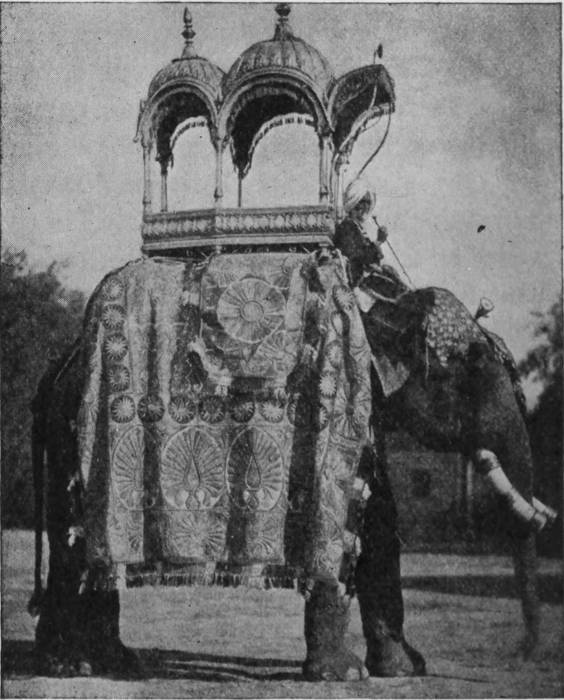
Reproduced by Permission of the Philadelphia Museums
A State Elephant of India with Howdah
Baby-elephants also can be taught to play many tricks, such as to sit at table, use the fan, and the like. We are told of two of them named[131] Jock and Jenny, that would come in, bow to the audience, mount on a plank, and see-saw like a couple of children. One of them would then walk on the tops of a double row of bottles. They would also play on an organ and drum, dance to the sound of bells, and do other clever tricks.
If we seek elephant stories of another kind there are a number of cases in which the animals have been hurt and borne surgical treatment with great patience. There is a case where one went blind through some disease in its eyes. Nitrate of silver was applied to one eye and caused so great a pain that the animal roared wildly. But the treatment did the eyes so much good that when the doctor came the next day to try it on the other eye, the animal lay down, placed his head quietly to one side, and drew in his breath as we would do when expecting to be hurt. When it was over he gave a sigh of relief, and showed how grateful he was by movements of his trunk.
This is one out of various tales of this kind that could be told. The elephant here learned by the good done to one eye that he was going to be helped with the other, and made up his mind to bear the pain for the good it would bring him.
Not many animals can learn things without being taught, but the elephant can. One thing a tamed elephant is taught to do is to pick up things from the ground and hand them to the driver on his shoulders. At first he is made to pick up only[132] soft articles, for he is apt to throw them up with force and might hurt the man above.
After a time the animal gets to notice the difference between soft things and hard things. A bundle of clothes may still be thrown up with force, but a hard and heavy thing, such as a piece of iron chain, will be handed up gently. The wise creature learns in time to pick up a sharp knife by its handle and lay it on his head so that the driver can also take it up by the handle, and when made to pick up things it has never seen before it shows that it knows how to deal with them.
We might go on and give many other examples of the mental powers of the elephant, but enough have been given to show that this great creature is one of the most sensible of all beasts and is as quick at learning the best way to do things as any others of the animal tribe. And it can think out things for itself, which shows finer thought than to have them taught it by others.

When we think of the many things man does with the animals he has tamed, the first that comes into our minds is their use in hunting and as house guards and pets. But we must not forget how useful they are as workers, in the fields and in the roads, in war and in peace. For long ages they were the only helpers that men had in work and travel. Only within our own times have we found out how to put the forces of nature at work for us and how much stronger those are than any animals. The animals kept by us have one value for which the forces of nature can never serve. That is their value for food. While we can use the power of the winds and of coal and iron in doing work, we cannot feed upon these or anything of this kind. To live we must have food, and this we can get only from the world of plants and animals. We also use the skins and furs of animals for clothing, and weave warm cloths out of their wool and hair. These are the things I now propose to talk about.
Is there anything that adds more to the beauty of a scene in the country than the grazing cows that give life to the fields, now cropping the grass, now resting under the shade of the trees, now wading in cool streams, now lying in midday rest? They are so mild and gentle, and look at us so quietly out of their big, kindly eyes that we cannot help keeping a soft spot for them in our hearts.
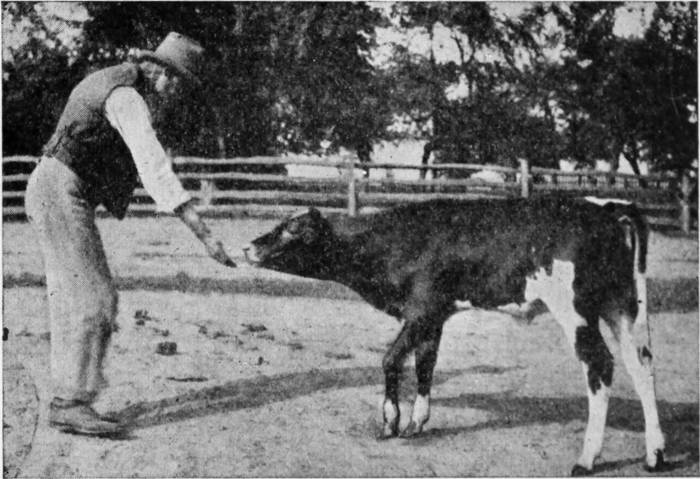
Making Friends with a Guernsey Calf
They wear horns, but they do not use them, and we can walk through a herd of these large animals as safely as through a grove of trees; that is, if they are all cows, if there is not a bull among them. The bull, the male form of the cattle tribe,[135] is a creature we must watch. If he happens to be cross and bad-tempered, as is often the case, he is not safe to trust. It is certainly not wise to wear a red coat or hat in a field where a bull is kept, for he seems to look on this color as a challenge to battle. To have to run from a bull is no fun, at least not if he gets close enough to help you over a fence with his horns.
But we seldom see a savage cow. These are quiet, dull animals, that have no thought of anything but to crop the grass and flick off the flies from their skin with their waving tails. They do not have to take care of themselves. Their masters and mistresses take care of them, so they have nothing to do or think of but to grow fat and yield milk.
There are wild cattle in various parts of the earth, and these have to take care of themselves, but the cattle of our fields have been kept tame so long that it is hard to tell from what wild species they came. We know that they were kept by the people of Egypt and China thousands of years ago, and that the Egyptians had certain bulls which they worshiped as gods. The bull and the cow are sacred animals in India and are never killed for food by the Hindu people.
In modern times the cow has been kept chiefly for the milk she gives. She is also kept as a food animal, but is not made to work, like the bull and the ox. The animal that is killed for food is a[136] large, well-fed beast, with straight back and well developed body. As for the bull, its savage nature is made use of in the bull-fights of Spain and it is also used in the "bull-races" of the South of France.
Cows, as well as bulls and oxen, have two horns on their head. In some breeds these are very long and powerful, but there are others that have no horns and in fighting use their heads to butt with. In this way they can give a powerful blow. With his head, his horns and his hoofs an angry bull is an animal that it is best to keep away from.
Cattle are of many colors and it is this which gives beauty to many of them. Among them we find such colors as black, white, yellow, brown, fawn, reddish brown, black-spotted and other hues, this variety of colors giving new beauty to a herd of grazing cows. It is a pretty sight to see them strolling up the leafy lane in the evening to the milking shed, with a boy and a dog to keep them moving.
There are a number of animals from which men get milk, but chief of all these is the cow. Those are breeds of cows which are kept only for milk-giving and which have been brought to yield so much and such rich milk as to make them of great value. In all history we read of the milkmaid, the girl whose duty it is to milk the cows, one of[137] the chief duties on a farm. Nowadays we do not hear so much about the milkmaid. She has for the most part gone out of business.
No doubt, many of my young friends have seen how milking is done, the cow with its full udders, the white stream of milk which flows from the teats when pressed, and the large quantity of this rich fluid which some cows will give. Perhaps some of you may have tried the art yourselves, but it is an art that needs to be learned, and many cows will not yield their milk to awkward fingers. Some of them, indeed, when they do not like the milker, will kick over the full bucket and now and then the milker with it.
In some way the cow turns part of the grass she eats into this rich fluid, so useful to mankind, not only as a drink, but for the butter and cheese it yields. Nature provides milk to all animals of the class known as mammals as food for their young, but by long usage the cow has been brought to give milk at all times and thus helps to feed her keepers as well as her calves.
I hardly need tell you that milk is a white fluid in which float small globes of fat. This fat is the butter of which we make so much use. If the milk is let stand, the butter floats to the top and is skimmed off in a rich fluid we call cream. By various modes of churning the butter is got out of the cream, leaving a thin liquid behind called buttermilk.
Butter is not the only thing got from milk. Cheese is another product of much use. It is made from the solid parts of the milk. When an acid, or a substance called rennet, which is obtained from the calf's stomach, is put into the milk, the solids come together in a soft, white jelly, leaving a greenish, watery liquid called whey. It is from this jelly, or curd, that cheese is made by pressing out the whey and leaving a hard, solid mass. There are many ways of making cheese and many different kinds of cheese, often so unlike that we can scarcely think they came from the same source.
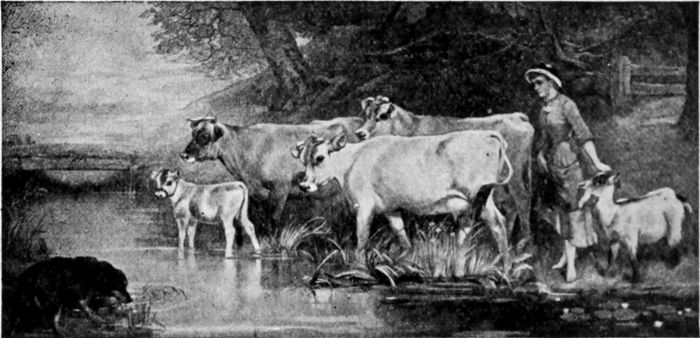
Back to the Pasture After the Milking
Now let me say something about the various breeds of milk-giving or dairy cows. They differ very much. Some give a great deal of milk; some much less. There are cows that have given as much as twenty-four quarts of milk a day. Think of six gallons from one cow in one day, enough to[139] fill a vessel of large size! Others may give only ten quarts or even less.
But the cow that gives the most milk does not always give the best, for there is great difference in the richness of milk. Thus the best butter makers may not be those that fill the fullest pail. The quantity of milk depends on the food eaten, the kind and plenty of grass in the fields or hay in the stables. But the amount of butter in it seems to come from something in the animal herself.
You have often heard, and perhaps often seen, the different breeds of dairy cows, the Jerseys and others. There are many of these breeds. The Dutch cattle, those that come from Holland, are mostly good milk-givers, also those of Holstein and Friesland yield a very full pail, and there are splendid milk-givers elsewhere.
All of us must have seen the beautiful cows from the Channel Islands, near the coast of France, known as Jerseys and Guernseys, often called Alderneys, now so common in our fields and which give such rich milk, from which splendid butter is made. We may also speak of the Ayrshire cow of Scotland, which is of high value to the cheese-maker. All these and other cows have been brought in numbers to this country, which has no good breeds of its own.
Did any of my readers ever try to churn cream into butter? Those who have done so did not[140] find it very easy work. To lift a long rod up and down or turn a handle till your arms feel ready to drop off is never the best of fun. In past times all butter-making had to be done in this way, with some sort of churn, but now in large dairies a small engine is used to do the work. In our days great part of the butter is made in creameries to which the farmers take their milk. Here the cream from 600 or 800 cows may be dealt with by one skilful butter-maker, who handles it with great care, so that we get a better quality of butter than was of old made on most of the farms.

From Davis's Practical Farming
The Holstein Cow, a Great Milk Giver
This way of getting the butter from the cream[141] was started in the United States, where now there are thousands of creameries in the many states. From this country it has spread to many parts of Europe, but there most of the butter is still made on the farm. Cheese is also made in the same wholesale way and American cheese is sold in many parts of the world.
We use here so much milk and butter that it is not easy for us to see how people anywhere can do without it. Yet there are parts of the world where cow's milk is not used. Thus if one should go to China he would find the people making no use of the milk of their cows. And in India the milk of the buffalo is liked better than that of the cow. Even in parts of Europe little use is made of milk and butter. This is the case in Italy, where olive oil takes the place of butter. But almost everywhere, except in India, much use is made of cattle for food, and of this something must now be said.
In the United States the raising of cattle for meat is a great business. For years past this country has fed its own people and helped to feed those of Europe. The meat of cattle killed in Chicago and other cities is sold in the markets of London and other parts of England and the people of that country have long been growing fat on American beef. This is not so much the case in Germany, France, and Russia, for great num[142]bers of cattle are raised there, but at times we could find the beef of our country on the tables of most of these lands.
When the white man went to America he found no cattle there. But it was not long before there were plenty of them, brought from Spain, France, England and other countries. These spread all over the continent until there were cattle everywhere. But these were not the best of cattle. There were no fine breeds raised here as in Europe.
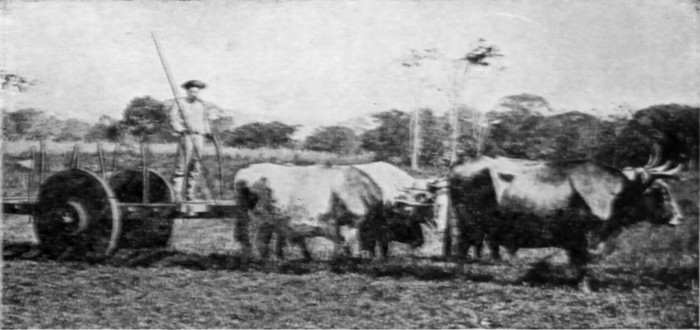
Reproduced by Permission of the Philadelphia Museums
Ox Team and Native Cart, with Wooden Wheels, Nicaragua
This is the reason why so many Jersey, Ayrshire, Dutch and other fine milk-givers have been brought here from Europe. Meat-making cattle have also been brought, those known as Shorthorns, Herefords, and others, and now we can find in our fields great numbers of fine, fat animals, which are taking the place of the old poor stock.
Good beef cattle are large and square in shape, full and broad over the back, with thick legs,[143] short necks, and well rounded bodies. The eye is bright, the face short, the skin soft, the flesh mellow and rich.
Cattle of this kind are to be seen now in numbers in our fields. But the great cattle-raising sections of this country are the broad grassy plains of the West and the vast fields of Texas. Here may be seen the great ranges, where for long years past cattle have been kept by the millions, roaming about, feeding on the rich grass, and growing fat and juicy.
Here also is the home of the cowboy, the man who lives on the horse and rides as if horse and man were one animal. His duty it is to ride among the great herds, keep them in order, stop them when they run away in mad fright, and live among them as the sheep-dog lives among the sheep. Brave fellows and splendid riders are these cowboys, among the best in the world.
If you should go west to-day you would not find the open cattle range of the past. The cattle-owners have found it best to fence in their ground, and wire fences may now be seen all over that once open country. But the fields thus made are very large and the cowboy still finds plenty to keep him busy.
If we seek other parts of the world we shall find cattle-ranges like those of the United States. In South America there are two great regions of this kind. One of these is in Venezuela. Here are great[144] open plains called llanos, covered with rich, thick grass on which millions of cattle feed. The same is the case with the pampas of Argentina, vast prairies over which cattle roam in countless numbers.
On those great plains dwell the brothers of the cowboy, daring riders whose lives are spent in the care of the grazing herds. The Gauchos, as the cattlemen of Argentina are called, are not the sons of civilized fathers like our cowboys. They are a race by themselves, bold and hardy, but ignorant, many of them part Indian. But they are born and bred to the saddle and no riders can surpass them in handling their swift horses.
Of the other countries where great herds of cattle are to be found we may name South Africa and Russia. Mongolia, in the Asiatic part of Russia, is a land of vast plains, called steppes. This may have been the first region in which cattle were kept. As far back as history goes the herdsmen of this great region have been roaming about with their cattle, horses and other animals, living in tents, and moving from place to place seeking new fields of grass when the old ones are cropped. This was their life thousands of years ago and this is their life to-day, and they seem no more civilized now than they were then.
We do not care to talk about the killing of these fat herds. That has nothing to do with Home-Life, except in so far as we find their meat on our tables, for the killing is mostly done in great sheds[145] and pens built for that purpose. It will be enough to say that the animals we have been talking about are of the greatest use to man. They work for him, they feed him with their milk and flesh, and after their death nearly every part of them is of use. From their skins leather is made and we walk upon their hides in our shoes. From the bones glue and gelatine are obtained, and when the bones are ground they are used to fertilize our fields. In fact use is made of nearly all parts of the animal and hardly a scrap of it goes to waste.
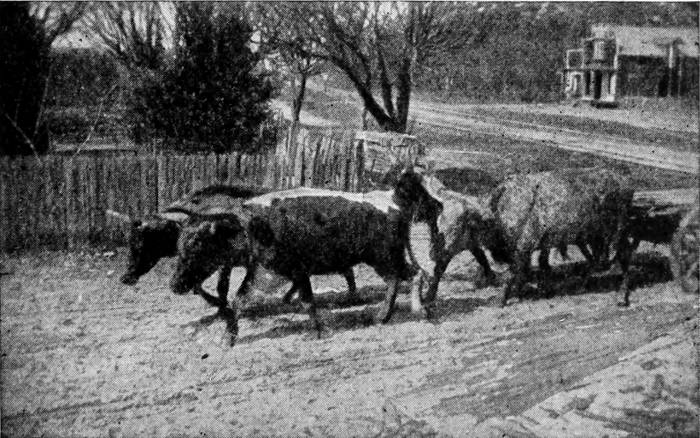
An Ox-team on a Florida Plantation
The bull is not a nice animal to deal with. It is often surly and savage, and few of us care to be in the same field with it. In some parts of the[146] world its courage is made use of in a brutal kind of sport. In former times what was called bull-baiting was very common in England, and might be to-day only for the laws. A bull was driven into a closed-in place and dogs were sent in to fight with him. Sometimes, to make him furious, pepper was blown into his nose before he was set free.
At times a dozen or more dogs were sent in at once. At other times the bull was tied to a stake by a rope of some length, and bulldogs were set upon him, one at a time. They were trained to seize the fierce animal by the nose, which was called "pinning the bull." But the best fun to the lookers-on was when the bull lowered his head to the ground, caught a dog on his horns and tossed him a long distance away. Bull-baiting was kept up until 1835, when laws were passed to stop this cruel sport.
But bull-fighting, which has long been very common in Spain, is still kept up in that country. In ancient times fights between bulls and men were common in Greece and Rome, but in modern times they have been held only in Spain and its colonies. They may be seen to-day in the cities of Spain and Mexico.
As we have a baseball season in this country so they have a bull-fight season in Spain. In the city of Madrid it lasts from April to November, there being at least one fight every week. The[147] fights are held in a kind of circus, with seats for 10,000 or 15,000 people, who have to pay well to see the brutal game.
There are three classes of men who take part in a bull-fight. The first of these are the "picadores." These fight on horseback, each of them with a lance. If the bull is a coward they crowd upon and kill it. If it is brave they often have to fight for their own lives. The bull may lift the poor horse on its horns or may throw the rider, who is sometimes killed.
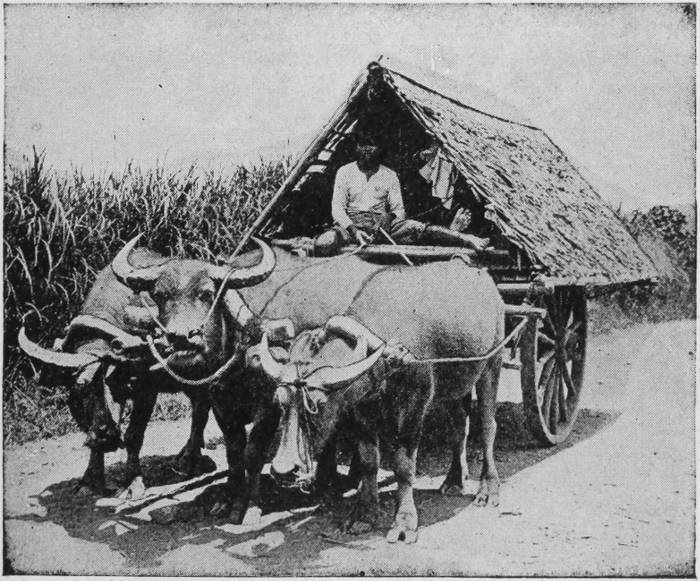
Reproduced by Permission of the Philadelphia Museums
Carting Manila Hemp. Philippine Islands
When the picadore is in danger the second class, the "chulos," run in. They wear bright-colored[148] cloaks and gay ribbons and draw the bull after them by waving their bright cloaks in his face. When the bull shows signs of being tired these men throw darts at him which stick into his neck. Some of these bear fire-crackers, the noise of which makes the bull furious.
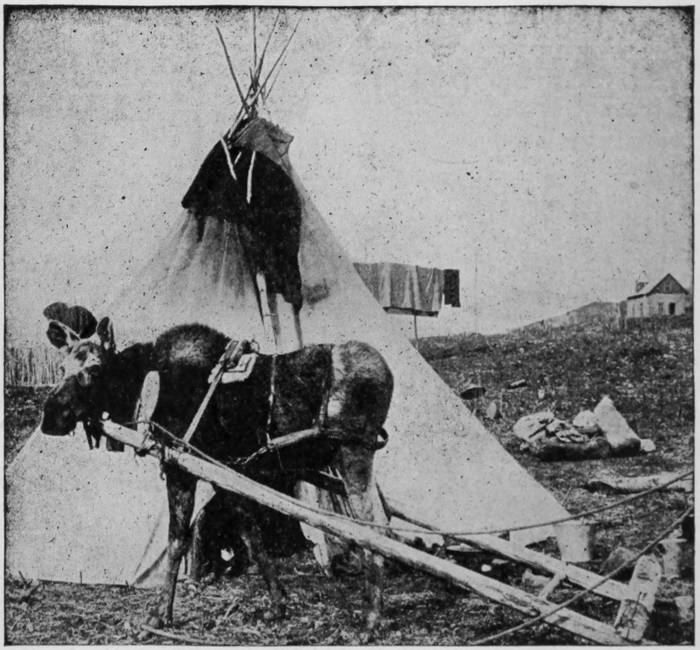
Reproduced by Permission of the Philadelphia Museums
Moose in Harness. This is a Rare Use of this Great Deer-like Animal
Now the third man comes in, the "matadore." He is on foot and carries a sword, and in his left hand is a short stick with a piece of red silk tied to it. When the angry bull sees this red stick he[149] rushes at it, for he hates anything red. Now the matadore has his chance. With one quick stroke he thrusts the sword into the animal between the shoulder-blade and the spine, driving it in to the hilt, and the poor bull falls dead.
Then a team of mules, gay with flags and bells, enter and drag out the dead bull, another is driven in, and the fight begins again. The horses and bulls are the chief sufferers, it being said that about 2500 bulls and 3500 horses are killed every year in the bull-fights of Spain. The horses used are poor creatures, only fit to end their lives in a bull-fight.
The people cheer the matadore for his victory; but they are quite as ready to cheer the bull that has killed his man. But it is a rare thing for a man to be killed in the fight, usually it is only the poor animals that suffer. The other nations of Europe and the people of this country do not like bull-fights. They look on them as cruel and unfit for civilized times. But the people of Spain love them and will not give them up.
Long, long ago, hundreds of years before men began to write history, perhaps before they had tamed any other animal, the woolly creature called the sheep began to share the home-life of man. In the first pages of the Bible we find its name. Abel, the second son of Adam and Eve, was a keeper[150] of sheep before he was killed by his brother Cain. It may have been kept in very early times in all parts of the earth, for the sheep can live in all climates, from hot to cold, and its meat and wool are of great use for food and clothing.
Also it is easily tamed, and in the ages of the past it became so used to being taken care of that it has long forgotten how to take care of itself. Thus the sheep that crop the grass in our fields have come to be stupid animals. But this is not the case with the wild sheep which are found in various parts of the earth. These are quite able to fight their own battles and are sharp-witted, like most wild animals.
It is only the female sheep, the ewe, that is so dull. We all know that the male sheep, the ram, is much more wide-awake. These often have very large horns, and the wild ram knows quite well how to take care of himself and his family. They will run from danger if they have to, but if cornered can make a very good fight. Even one of our field rams has at times shown itself a good match for a bull. While much smaller in size, it is far more active and can hit a very hard blow with its bony head and big horns.
Have you ever seen a fighting ram? One of them has been known to throw a bull to the ground at the first rush. It can fight dogs, too, and is always ready to defend itself and its flock. Rams also fight one another, and when two of them come[151] together at full run, their heads crack like the sound of a musket and their hind parts are lifted into the air. Many sheep have no horns, and these are not so fond of fighting, as the horns are a great help to them.
Men keep sheep for two things, their wool and their meat. The same is the case with cattle, which are also kept for two things, their milk and their meat. All over the earth people are fond of mutton, or the meat of the sheep, while the wool is used wherever warm clothes are needed. In some cold countries the skin of the sheep, with its woolly coat, is used as a cloak and is found a warm covering.
The wool of wild sheep is short and lies below an outside coat of long, straight hair. But this hair is lost in the tame animals and a coat of long, thick wool takes its place. Wool, you should know, differs from hair in having a scaly surface, which causes its fibres to cling together. This makes it good for twisting into yarn and weaving into cloth, also for felting, as in the making of felt hats and rugs.
Of course very many of you have seen the sheep in the field, walking slowly about all day long, cropping, cropping, cropping, as if eating were all it lived for. This is the case all over the earth, for sheep are the most common of our farm animals and are kept in vast multitudes in various countries. So tame and gentle are they that the shep[152]herd and his dog can easily keep a large flock in order. He has to guard them in some countries against wolves and also against sheep-killing dogs.
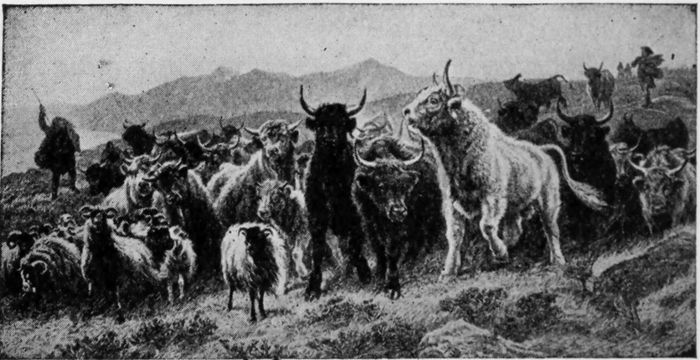
Cattle and Sheep of the Scottish Highlands
The sheep is a mountain animal, not a native of the level plains like the horse and the ox. The wild sheep do not live on level ground but among the lofty hills and are often found in very high places. We have one species in our own country, the Big-horn or Rocky Mountain Sheep, which can climb over the roughest cliffs and plunge down steep places without hurting itself. There are other species in Asia and Africa, with the same habits.
From this we know why tame sheep are so fond of hill climbing and why they do so well in such rough regions as the Highlands of Scotland. Young lambs are very fond of climbing every little hill they see. When feeding, sheep like moun[153]tain sides better than they do plains. Here they nibble away at the short, fine grasses, which they like better than any other food.
You may have read of troubles and fights between the shepherds and cowboys of our western plains. This comes from the close nibbling of the sheep, which cuts the grass down to its roots and leaves no food for the cattle. On this account the cattlemen hate the sheep-men and in some cases kill large flocks of sheep. The sheep are said to do harm also on the mountain sides, clipping the grass so close with their sharp teeth that the rains carry away the soil, and leave none for the trees to take root in.
There are a number of countries in which sheep are kept in mighty flocks. These are the United States, Europe, Argentina, Australia and New Zealand. There are numbers of them also in Asia and Africa and here there are several queer kinds, which would seem very strange to us. The oddest of these is the fat-tailed sheep. The tail of this animal grows to a very great size and has been known to weigh 70 or 80 pounds. It is a big bunch of fat of which the people of those countries are very fond. In some cases, to keep it from being hurt by dragging on the ground, little wagons are used and the sheep go about dragging their tail behind them in a sort of baby carriage.
There is another kind with a huge hump of fat on its hind-quarters and hardly any tail at all.[154] On the other hand the Circassian sheep has a tail so long that it trails behind on the grass and is covered with fine, long wool. There is a kind of sheep in Africa with very long legs and hanging ears, and in several places they have odd kinds of horns. Those of the sheep of Wallachia make a complete turn and then rise up from the head to a great length. The Iceland sheep and some of those of Russia has three, four, and even five horns.
In Europe sheep have been kept during many centuries and a number of useful breeds are now to be found in the different countries, some with fine, thick wool, some with rich, juicy meat. All of the sheep of this country were brought from Europe, and many of the best breeds are kept here, among them the Southdown of England, which is of value for its splendid mutton.
But nearly the whole of our sheep came from the Merinos of Spain, a kind of sheep which has been kept in that country from the past ages on account of its fine, soft wool. The Merino may now be found all over America and Europe and also in Australia, so that it is the most common kind of sheep on the earth. The first of them were brought to our country in 1801 and we have now many millions of their descendants.
There is much more that could be said about sheep. No meat is more common on our tables than mutton and in all cold countries woolen clothing is worn. In Bokhara, a country of Cen[155]tral Asia, is a sheep which yields the valuable astrakhan fur. This is not taken from the full-grown sheep, but from the lambs. When very young these bear a short, fine wool, curled all over them in small locks. To make it curl better they are sewn up, while very young, in another skin or a piece of coarse linen. Long hairs soon grow through the wool and to prevent this the lambs are killed when they are only a few days old.

The Merino Ram, the Great Wool Bearer
There is still another use to which sheep are put. This is the making of cheese. There is a breed in the south of France which are milked[156] and from their milk is made the famous Roquefort cheese. In making this layers of moist bread crumbs, ground to powder, are placed between layers of the milk curds. This mixture is pressed and salted and then kept for a month or more in dark mountain caves. There the cheese ripens and gets the special flavor for which it is liked.
Sheep are of value for various things: their meat, which so many like; their skins, from which parchment and fine leather are made; their bones, used in making buttons; their fat, for soap and candles; but most of all their wool, which has long been the most valued product. So here I must tell the story of this very useful animal fibre.
Go back as far as we can in history we read of the sheep-shearing. You may find it spoken of in the early parts of the Bible as a time of feasting and merry-making. In many countries it is a festival time. In past ages people seem to have cared more for the wool than for the meat, though now sheep are kept as much for their mutton as for their wool.
In the past the custom was to pull the wool from the sheep at the molting season. This is the time when the sheep shed their wool and when it comes out easily. But it is at times a cruel process, as the skin may come off with the wool. It is still done in Ireland and in parts of Europe,[157] but the common custom in these days is to cut the wool with a sort of tool or machine. This cuts the wool in a smooth and even manner and does not hurt the sheep. It also can be done in much less time. When in the old way it took half an hour to shear a sheep, in the new way it can be done in ten minutes or less.
The sheep should be washed and the wool cleaned before they are sheared and this is done in our country and in some others. But in many places it is not done and the fleece is cut with all the grease and sweat in it. Of course, these fleeces have to be washed by the buyers, and do not bring so good a price.
Shall I say something about the uses of wool? In all times it has been used for making cloth for clothing, and spinning and weaving are very old duties of the household. If wool is made damp and then pounded it clings together so as to form a kind of felt, and in our times much wool is used in this way to make felts for hats, carpets and shoes.
Felting is a simple process, but in weaving there are many things to be done. The wool has to be combed out, spun into yarn, and handled in other ways before it can be woven into cloth and fitted for making into clothes.
All this business of yarn-making and weaving is now done in great factories, fitted with machines, which rattle and roar as they swiftly change the rough fleeces of wool into smooth sheets of cloth.[158] But all this work in former times had to be done at home, in a much slower way, from which there came a rough, coarse cloth called homespun.
This was the way in use in this country in the times of the colonies. Many of the old spinning-wheels, by which the wool was spun into yarn, are still kept and may be seen in museums, and some of the old looms by which the yarn was woven into cloth are also to be seen.
It was hard work for the women of the house to make the clothing of the family in this slow way. A suit of clothes then had to be worn for a long time, for they took too much labor in the making to be thrown aside as quickly as they now are. It was in these homespun clothes that our soldiers won freedom in the Revolution, and they were woven after that date. But in time the factory came, cloth grew plentiful and cheap, and the rattle of the old spinning-wheel was no longer heard in the land.
Now we come to an animal in some ways much like the sheep, but in other ways very little like it. This is the goat, a more vigorous and hardy animal. Unlike the sheep, it wears a beard under its chin. It is not kept much in our country, for it is not well fitted for cold climates, but likes best the warm airs of Southern Europe and Asia and Northern Africa. Some of my readers may only know this animal from taking a ride in a goat[159] carriage when young. Or they may have seen it roaming about in rough places eating anything it could find, for that is the way with the goat. It will even eat tobacco and seems to think this a fine diet.
The wild goat, like the wild sheep, is a dweller in the mountains. It is still more daring than the sheep. No peaks are too high for it to climb, and when chased by the hunter it will make long jumps from one pointed rock to another where no man would dare to follow. No other animal can equal the goat in climbing and leaping. It is even said that some kinds of goats will jump down from a high place and save themselves by falling on their strong horns. But I do not know if anybody ever saw this done.
A well-known wild goat is the Ibex of the Alps. This is a splendid fellow, with long and strong horns but no beard. It used to be very common, but has been shot at so much that very few are left. The Chamois of the Alps is an antelope, but is much like the goat, and is a wonderful jumper. It thinks nothing of leaping over a ravine sixteen or eighteen feet wide, or over a wall fourteen feet high, or of running up and down very steep hills. But the hunters have killed most of these animals also. They think it fine sport to shoot a poor chamois and let it fall to die in a deep abyss where no one can reach it to get its body. There are many who do not think this good sport.
Goats, like sheep, were tamed and made natives of the home and farm very long ago, no one knows how long. The tame kind comes from the wild goat of Southern Asia, but it has grown smaller in size and its horns have become shorter. It was kept in Bible times and by the old Greeks and Romans. These kept it for its milk and the cheese made from it, and also for its meat. The flesh of the kid, or young goat, is very good, but that of the old goat has a strong and unpleasant smell which few people can endure.
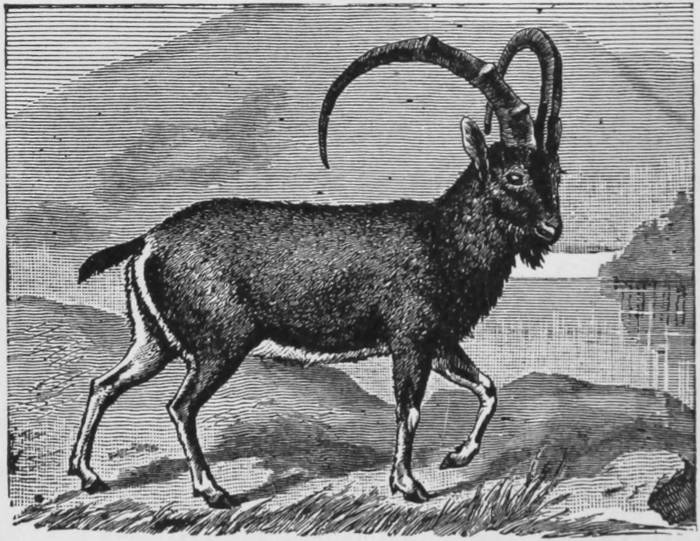
The Alpine Ibex. Note the Curiously Knobbed Horns
In modern times Greece and its islands have more goats than they have people and there are many in Malta and Corsica, Italy and Spain. They are not kept largely in the United States, there being about one goat to every fifty sheep.
The goat will thrive where the ox and the sheep[161] would starve, as on rocky hill-sides or thin, poor soil. There is little they will not eat, though you had best not believe that they are fond of old tin cans or any diet of this kind. One bad habit they have is to gnaw the young shoots of trees, of which they are very fond. This makes them deadly to forests, for no young trees can grow where they are kept. The goat has done much to kill out the trees on the hills of southern Europe and Asia and thus to destroy the forests of those regions. It is also fond of the grape-vine, and on this account, in ancient times, it was sacrificed to Bacchus, the god of wine.
The goat is far from being so dull and stupid an animal as the sheep. It makes friends with its keepers and is a cunning and curious brute, though too fond of using its horns. This is often done in play, but in a way that is not very funny, except to those who look on. It will rear up and pretend to attack you with its head and horns, but this is only its way to ask you to play with it. The playful pranks of the kid, or young goat, are often spoken of in poetry. It is a gay little creature, fond of capering about in an amusing way.
In fact the goat is not at all stupid and has often shown sense and cunning. There is a story of a goat that rang a door bell when hungry for its dinner, by hooking its horn in the wire. Another story is of two goats that came face to face on a narrow ridge in the rocks. There was no room to[162] pass and after looking at each other for some minutes one of them lay down and let the other walk over its body. Two men could not have done better than that. The long-eared Syrian goat is trained to do all sorts of tricks. One of these is to balance itself on a pile of small wooden blocks built up to a height of several feet. Fancy a sheep doing this!
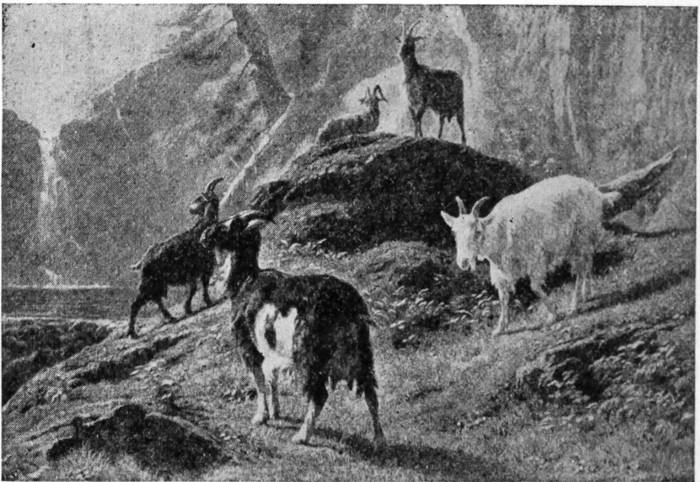
Milk Goats in the Alps
If it be asked what are goats kept for, the answer would be, chiefly for their milk. Goats' milk is very rich and is easy to digest and this makes it of much use for sick or feeble persons, to whom cows' milk is at times dangerous. It is very good for consumptive people. In parts of Europe it is thought that certain diseases of horses and cattle[163] will not come when goats are with them, so they are often kept in stables and cow-barns to ward off disease.
Though the goat is a small animal it gives a large quantity of milk, often from four to six quarts a day and sometimes more than this. There are cases where twelve quarts a day have been given. The milk is apt to have a bitter taste and an unpleasant odor, but that comes from the way the animals are fed and kept. With good care and food, the milk will lose this taste. The goats of Syria and Palestine give sweet milk and goats' milk is much used in that part of the world, as it was in the old Bible times. The Arabs have a great dislike for cows' milk.
The milk of the Syrian goats is also very good for making butter and cheese, which are said to be of very fine quality. Much butter and cheese are also made in Europe from goats' milk. These have a special taste of their own, but are much eaten, for one soon gets used to the taste.
Goats are made use of for other things than for their milk, butter, cheese and meat. In early times the goat-skin was used for clothing, and it still is in some countries. The skins are also used by the wandering tribes of Asia as vessels to hold drinking water, and also, tightly sewed and blown out with air, as a sort of boat for crossing or floating down rivers.
In our days the skins of goats are made into[164] leather. Kid skins are used for gloves and shoes, and goat skins for morocco, shagreen, and other fine kinds of leather. The hair is made into ropes which may be kept in the water without injury; also in England to make wigs for judges and others, the hair of white goats being used for this. Goats' hair is also used to make brushes and hats. Knife-handles and other things are made from the horns, and the fat is better than that of the ox for candles.
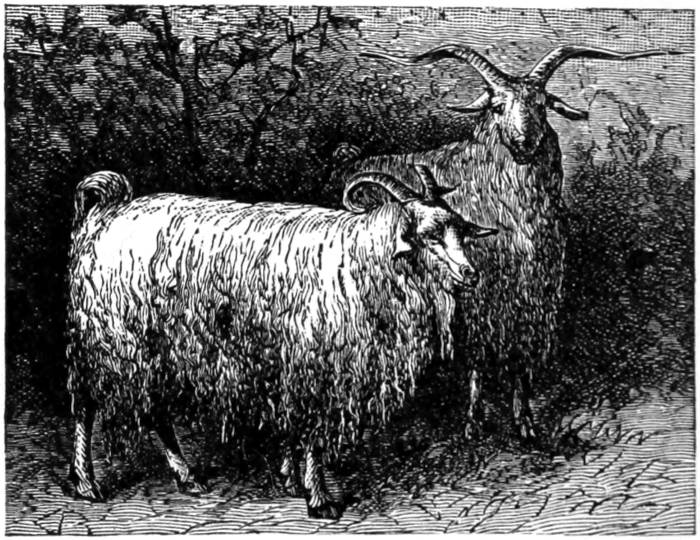
A Pair of Angora Goats
I must now speak of two kinds of goats of use for their wool. One of these is the Cashmere goat, from the wool of which the fine cashmere shawls are made. This goat has a coat of long, stiff hair, but under this is a very fine, soft, fleecy wool, white or gray in color. Of this each goat yields from one to one and a half pounds. To make a shawl a yard long, takes the wool of twenty to[165] twenty-five goats. They were formerly made in large numbers but in our days few of them are to be seen.
The other wool-yielder is the Angora goat, well known in this country. This yields a thick and fine wool, soft and silky and slightly curled. The color is mostly snow-white, though at times there are dark patches. It is shed in great locks in summer, but soon grows again. During the hot weather the goats are constantly washed and combed, to add to the beauty of their wool. The finest Angora wool, called Mohair, comes from goats a year old. All its value is lost at six years of age.
Let us now take a glance at that grunting brute known to us by the various names of pig, hog, and swine, which dwells in the pig-sty when tame and in the forest when wild. Clad in bristles, with thick skin, short legs, curled-up tail, no neck, and round snout, no one would buy the pig for a beauty. But in his case use goes ahead of beauty, and who will say that he is not of use?
Though the pig is a very docile brute in man's care, he is far from mild and gentle in his wild state. In fact, the wild hog is not an animal to be played with, nor is it a safe one to fight with. Hardy and active, fierce and bold as a lion, with a strong head and long, sharp tusks in his large jaw, the hunter who goes out to seek him in his[166] lair must do so with care and skill or the pig will get the best of the hunt.
Most of the beasts of the wildwood let the hog alone. He is not safe game. But for many long years he has been hunted by man, who likes a game that has a spice of danger. In the days of old Rome the chase of the hog was a favorite sport, and it was the same in later times, when the lords and dukes of England and Germany were very fond of hunting the wild boar. In our days "pig-sticking" is a common sport of the English in India.
Mounted on trained horses and armed with long, sharp lances, the hunters seek to bring down their game from the saddle. But if by any foul chance the hunter should be thrown from his horse near the hunted brute his chance for life is not good. The furious brute will rush upon him, and with one thrust of its strong jaws may rip his body open with a deadly wound. Great nobles and warriors have met with death in this base way and the wild hog has held his own bravely among his enemies.
Is this fierce fighter of the forest the same animal as the lazy grunter of the pig-sty? There is no doubt of it. His long life under man's care has taken all the fight out of him. Only in one way does he show his old temper. He is the most obstinate of all the animals we know. He does not like to be driven and will do his best to go[167] just where you do not want him to. But he no longer fights to win his way; he only grunts or squeals and holds back.
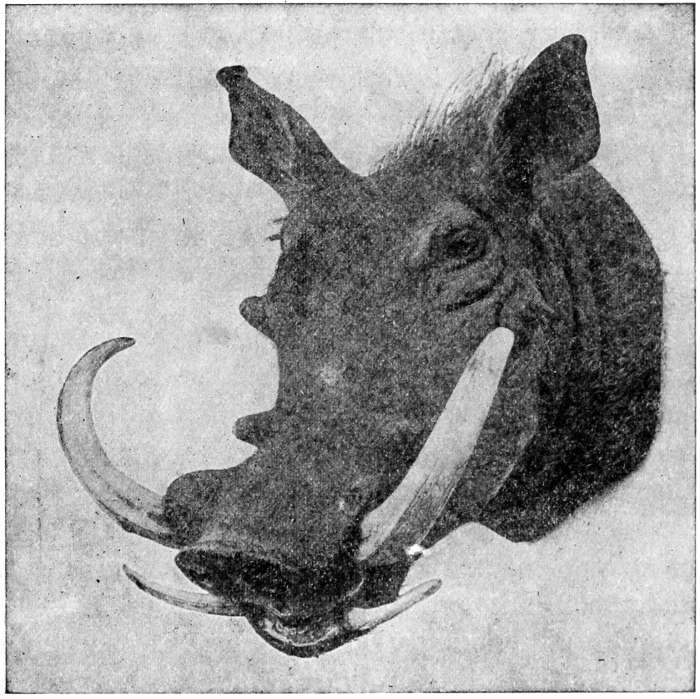
From Madeira's "Hunting in British East Africa"
The Wart Hog. An African Tusked Cousin of the Wild Boar of Europe
Try to drive a pig and you will find this out. You will soon be in a fret over the stubborn brute. If you want him to go forward you may find it best to try and drive him backward. An Irishman tells us that this is the only way to "persuade" a pig.
It takes a Chinaman to make little piggy go the right way, and this is done by putting him in a basket and carrying him. Two men carry this basket, hung on a pole. It is a sort of cradle in which piggy goes to market. The only time the pig can show his obstinate temper is when he is asked to go into the cradle. He holds back, as usual, but the cunning Chinaman knows what to do. He takes hold of the pig's tail and gives it a hard pull as if trying to drag him backward and the stubborn brute at once rushes forward into his cradle.
The pig will eat almost anything. By nature he is a plant feeder and in his wild state will roam the forest feeding on plants, fruits, and roots of all kinds. His hard snout helps him to dig into the ground in search of favorite roots and his keen sense of smell aids him in finding them. Thus he likes wet, shady places where the ground is soft and such plants grow.
In France and Italy the pig is trained to hunt for truffles, a kind of fungus which grows under ground and which makes good eating. He finds the truffles by his sense of smell and roots them up with his snout. In some places dogs are trained to do the same. The truffle found, the pig's master rescues it for his own table.
Pigs are fond of mast, the name given to the acorns and beech nuts that cover the ground in the nutting season in oak and beech woods. In[169] ancient times it was the common practice to fatten the pigs on these nuts in the proper season.
A hungry pig is not particular about his food. If no plants are to be had he will feed on worms, snakes, and small animals of any kind. Pigs in the pen are often fed on animal refuse, all sorts of kitchen slops being poured into their troughs. They will swallow this stuff greedily enough, but it is not good for them, or at least for those who eat their flesh, for this loses in flavor and is not so wholesome as when they are fed on good vegetable food.
Corn and clover are two of the things the pig likes best. Turn him out into a clover field and he will have a joyful time of his own in this rich food and put plenty of good fat on his ribs. He does no harm to the field if not left there too long and it does good to him. In fattening pigs corn is freely given. It is not best to give corn alone, but it makes a good dessert after he has had the run of the pasture or clover field, and is the best fattener when he is being put in order for the market.
In visiting a farm the pig-pen is one of the things we are shown. It is not a pleasant place for a morning call, for the smell is not a sweet perfume and the mire in which the pig rolls is not nice. We are apt to go away with the feeling that this animal is a dirty brute.
This is giving poor piggy a bad name which he[170] does not deserve. It is his owner more than himself that is to blame. If he had his own way he would be clean enough. Like all thick-skinned animals the pig loves to wallow in the mire and cover himself with mud to protect him against insects. But left to himself he will keep his sleeping place clean. Those who know how to keep pigs soon learn this and supply the animals with dry and clean places to sleep in.
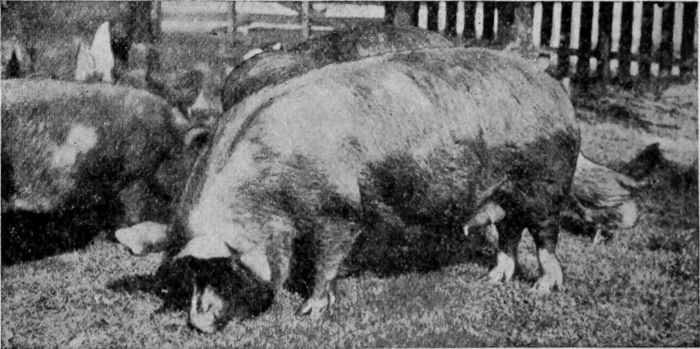
A Fat Berkshire Hog. A Monarch of the Sty
Pork, or the flesh of the pig, has long been used as meat. In some places so much is thought of it that the animal is held to be sacred. It is the chief flesh food in the South Sea islands, where the animal was long made a precious sacrifice to the deities. This was also the case in ancient Greece, and on the island of Crete the hog was a sacred animal.
No people have ever been fonder of hog meat than the ancient Romans, and we are told of[171] strange ways by which they gave it a fine flavor. They fed their pigs with old, dried figs, drenched with wine and honey. This was to make their livers grow large, pig's liver being a choice Roman dish.
In cooking the meat they would often serve a pig whole, one side being boiled and the other side roasted. In dressing the animal for the tables of the emperors and of rich Romans they would stuff it with such delicate food as larks and nightingales and serve it with wine and rich gravies. To eat pork in such ways would seem very odd in our days.
In many countries pork is the favorite meat. We find it so in Germany and France. In Ireland every peasant raises his pig, which makes its home in the same hut with him and thinks itself one of the family. In the end the man often has to sell his pig to help him out of debt, and looks on the porker as "the gintleman that pays the rent."
But the pig is not eaten all over the world. The Jews and Mohammedans will not eat it, and look upon it as an unclean animal. As there are nearly two hundred millions of these people on the earth, there are at least that many who do not eat pork. But aside from these, pork is eaten by the great mass of the people of the earth.
The pig is not an American animal. All our pigs, and they are many millions in number, came from animals brought from Europe. We[172] have here the peccary, a kind of little pig, very savage and dangerous, as it goes in herds and attacks every man or other animal it meets. But it has never been tamed, and we owe our pigs to the Spanish and other discoverers.
Our swine have grown mighty in numbers, and we pay the Old World for its gift of the pig by sending it back every year many millions of dollars' worth of pork, bacon, hams, lard, and other pig products. The best foreign breeds have been brought here and other breeds have been produced here, so that the American pig is hard to beat. This country is the great corn country of the world and great part of its corn is fed to the pigs of the West, so that we sell much of our corn in Europe in the form of pork.
Of the many breeds of pigs, that of China is one of the best. The Chinese are as kind to their pigs as the Irish and they have an animal worth being good to, one that has been sent abroad to many other countries. It is noted for its small size, fine head and snout, large hams and shoulders, compact body, fine bone, hair and skin and sweet, delicate meat. We have it in some of the best American breeds.
If it be asked what the pig is used for, we should say that there is no part of it that is not used for some purpose. We eat it under the names of pork, bacon, ham and lard; its skin is made into leather, which is much used for saddles; the bristles are[173] used for brush-making. In fact, when we think of all its uses, there is little left but the squeal and in our days even that may be used in the phonograph.
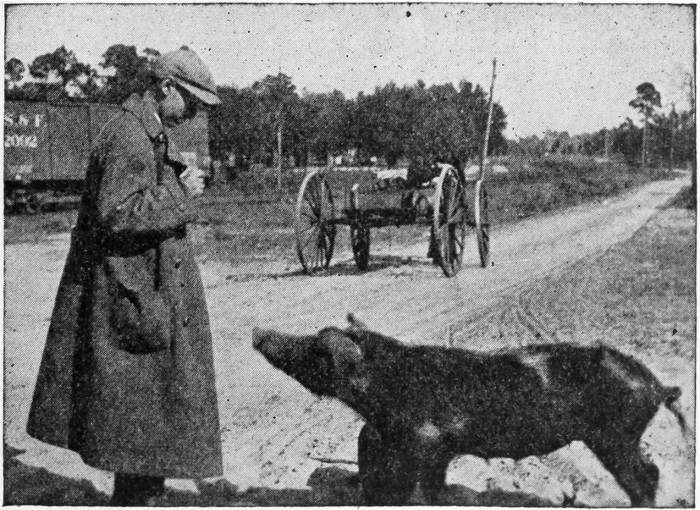
The Razor-back Hog of the South. Compare this lean Beast with the Fat Berkshire Hog given above
We might look upon the pig as a stupid animal, that lives only to eat and to be eaten, but this is not the case. It is in fact, a rather smart fellow in its way and can be taught to do many tricks. If you have ever seen what are called "learned pigs" you will agree with this.
The pig can do tricks without being taught. We have told how cats and some other animals can open latches and gate pegs. This the pig can do as well as any of them. We are told of one pig[174] that was taught to point game like a pointer dog, and did this so well that she was more useful than a dog.
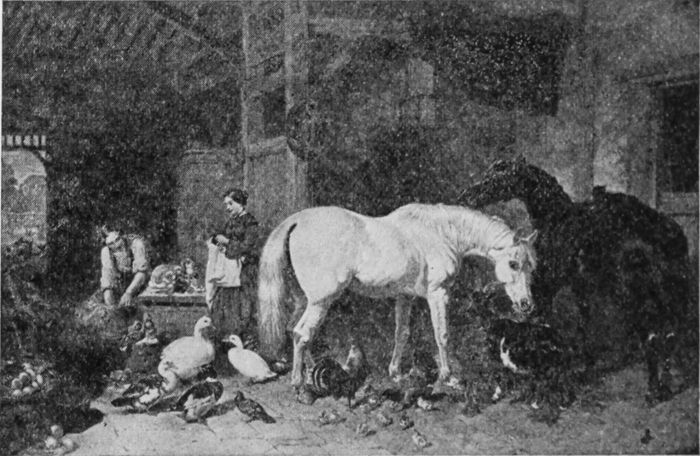
Animals of the Farm and Poultry Yard
Here is a good pig story. A gentleman named Stephen Harding says:—"I saw an intelligent sow-pig about twelve months old running in an orchard, going to a young apple tree and shaking it, pricking up her ears at the same time as if to listen to hear the apples fall. She then picked the apples up and ate them. After they were all down she shook the tree again and listened, but as there were no more to fall she went away." That might not be very smart in a boy, but it is smart in a pig.

We have had a long talk about the four-legged home-folks, those animals, big and little, that aid man in hunting, amuse him as house pets, carry him on his journeys, pull his carts and wagons, supply him with milk, butter and cheese, and yield him food for the table, wool for clothing, skins for leather, and other things for other uses.
This is a long list of the good that man gets from the animals he tames and feeds. But it is not the whole. There is another class of animals, two-legged ones this time, with claws instead of hoofs, horny beaks instead of mouths, feathers instead of hair, and wings in place of fore-legs. These are the birds of the poultry yard and the lawn, some of them kept for their eggs, some for their flesh, some for the splendor of their plumage; some of them very useful, others very beautiful.
I am sure that you will enjoy a talk about these winged and feathered creatures. They belong more closely to the home-life of all people than some of our four-legged friends and helpers, as they are kept close to the house and fed by its[176] people, not left to feed themselves in the fields. Best known and most useful among these is the hen or chicken, our clucking friend of the poultry-yard, who fills our pantries with eggs and is served on our tables as one of the best liked foods.
The city, we know, is a hotbed of noises, sounds of all sorts troubling our ears by day and night. We try at times to get rid of them, but find that not easy to do. The best thing for us is to get used to them and learn to sleep in spite of them. We need to become like Jock the miller, who got so used to the roar and clang of his mill that he could not sleep when it was still.
Some city people find it so hard to get used to the noises of the night that they go to the country for a quiet sleep. Do they find it? They may in still winter nights, but in the summer season the country has noises of its own. As soon as night falls a host of wood insects begin their endless drone. Then there is the locust and the katydid, with their shrill calls, and perhaps the whip-poor-will, with its mournful cry.
Falling to sleep at last, after these sounds have lost their force, no sooner are the first faint rays of light sent from the east, at three or four o'clock in the morning, than a new sound invades the ear and wakens the sleeper with a sudden start.
This is the early waking cock, with his loud[177] "cock-a-doodle-doo." Standing on his own fortress he sounds his shrill alarm. A dozen more, near and far, from all points of the compass, take up the tune. The air is soon full of this strident cock-crow, the signal of the coming of the sun, until all hope of sleep is at an end, and the pilgrim wishes himself well back in his city bed. He finds the country not such a sweet sleep-producer as he hoped.
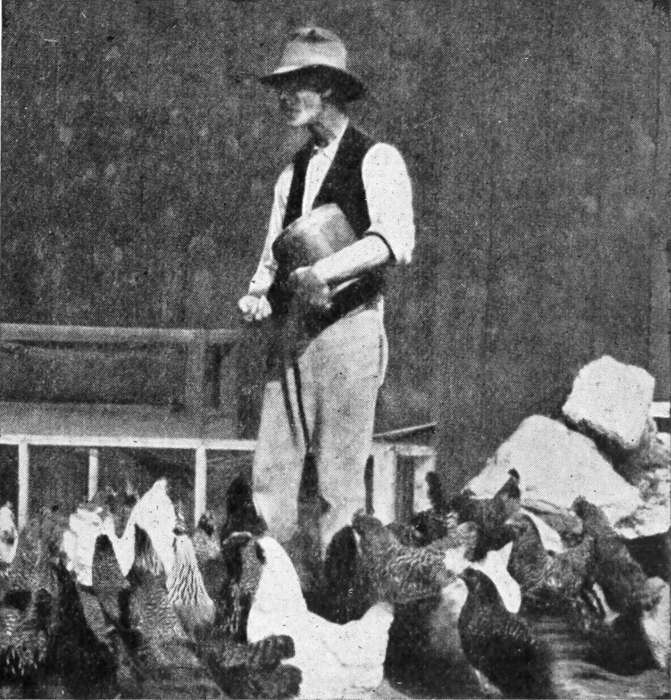
Feeding the Chickens in the Farm-yard
In old times people held the cock to be a sacred[178] animal, the herald of the dawn, the symbol of light and the sun. In later times it was held to be the wide-awake sentry of the coming day. There are places where its image is mounted on church steeples on guard over the winds. Everywhere it is the emblem of vigilance, and this is what the city sleeper in country beds finds it.
With its stately attitude, its erect head crowned with feathers like an Indian chief, its showy spread of tail, and its air of pride and dignity, our cock strides about as the lord of the farm-yard and peals out his loud "cock-a-doodle-doo" like a challenge to battle. And he is usually quite ready for battle if any rival cock takes up his challenge.
While the cock thus blows his trumpet blast, the hen finds other work to do. Her business is to lay eggs, hatch out her brood of funny little chicks, lead them about the poultry yard in search of worms and other food, and gather them fussily under her wings when a hawk is seen in the sky or any danger appears.
Mrs. Hen does not have the ear-splitting voice of Mr. Cock, but she has a language of her own. There are only a few words in it but each of them has a meaning. There is the proud cackle with which she tells the world that she has laid an egg, the lively chuckle with which she brings her brood to a feast of worms, and the quick cry of danger which sets them running to the fortress of her wings. Her brood know what all these chicken[179]words mean, and it is for their ears they are spoken.
The hen is not as handsome a bird as some other inmates of the poultry yard, but if we look over all our stock of these birds we will find some very good-looking ones, these for their showy colors, those for their fine shape.
Among those that are kept more for ornament than use are the great Cochin China fowls, stately birds, giants of their kind, of lordly bearing and fine coloring. They do not lay many eggs and those they do lay are small. Also they are not very good to eat. But they win respect through their size and beauty and thus are kept by many as birds of show.
Another family of giant fowls are the Brahmas. They are smaller than the Cochin Chinas, but are as handsome, and along with this they lay many and large eggs and their flesh is very good. So these are kept not only as birds of show but birds of use.
When we come down to hens of smaller size we find a number of breeds, not less than forty in all, dwelling in various parts of the world and many of than good in various ways. Like nearly all our home animals, America is not the native place of the hen. Neither is Europe, for it came from Asia, that great continent in which so many animals were first born. But the hen tribe has spread all over the earth, the chicken is a household treas[180]ure almost from the north pole to the south, and we can hardly find a country home in any land without its crowing cock and its clucking hen.
While not native to America, it makes itself very much at home there and the United States has some excellent breeds of its own, of which we may be proud. These are the Plymouth Rocks and the Wyandottes, which have been called the national fowls of America and which can hold their own with the best breeds of Europe. While we have brought a number of fine breeds from foreign lands, we have sent these two abroad, and they have won high praise both for beauty and usefulness.
The Wyandottes are of various colors, the white being best liked; others are of silver, golden, speckled, black, and partridge-color. They are splendid egg layers, filling the yearly basket with from a hundred and fifty to two hundred eggs.
The Plymouth Rock may be speckled, light yellow, or white, and it bears a strong resemblance to the Wyandotte, except that the latter has a double comb on its head while the former has a single one.
As the cow is kept for its meat and its milk, and the sheep for its meat and its wool, so is the hen kept for two purposes, its flesh and its eggs. Some kinds are bred for the table and they are of great value in our food-supply. Everybody likes a dish of chicken meat, which is fine in flavor, easy[181] of digestion, and very good for the weak or sick.
Other kinds are kept for egg-laying and the egg-harvest of the world is vast in size. It is the nature of the hen to lay eggs enough for a brood of chicks, sit on them to keep them warm, and take care of the brood when it appears until the chicks are old enough to scratch for their own living.
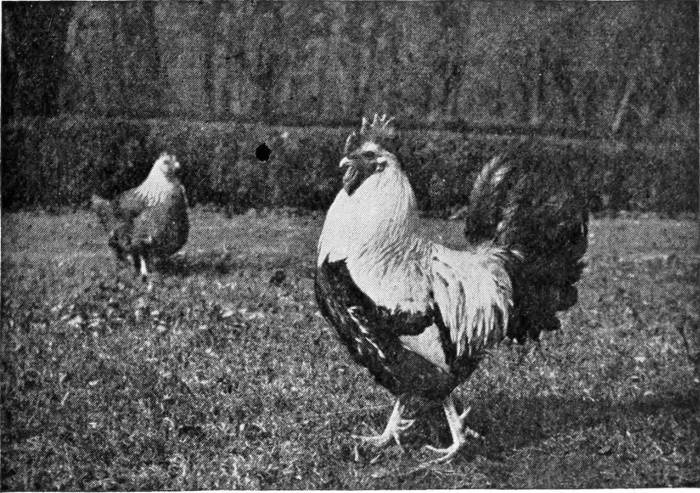
English Dorking Cock and Hen
But these duties take up much time in which no eggs are laid, and the farmers who deal in eggs try to prevent the hens from nest-making and egg-hatching. In this way many hens have been forced to forget what they were made for and have gone out of the hatching business. These give all their spare time to egg-laying. Some of them lay more[182] than two hundred eggs a year. Breeds of this kind are found mostly in the countries along the Mediterranean.
The number of chickens kept and of eggs laid in the world is far out of sight. In the United States alone in 1900 there were nearly 250,000,000 chickens, and nearly 1,300,000,000 dozen of eggs were laid. This made three chickens for each man, woman and child in the country and seventeen dozen of eggs for each. Since then the number has grown much larger and the annual egg crop of the world, if it could be heaped up together, would make a pyramid far larger than the largest in Egypt.
I do not want to say much about cock-fighting, for it is a cruel sport and leads to the vice of gambling, through which many lose large sums of money. But the fighting of game-cocks has a history of its own, and cannot be quite passed over in our story of the hen and its brood.
The males of all the higher animals are fond of fighting. It is one of their duties to act as guardians of the family against danger from outside, while the females look after home affairs. This fighting temper is very common among animals and men have often made use of it in getting up battles between animals. We find it in the chicken family, and cock-fighting has long been enjoyed by sport-loving people.
While all cocks are ready to fight at times, and the winning cock struts about the poultry yard like a conqueror, there are special breeds known as Game-cocks which are always ready for a battle and will fight till victory or death ends the fray. Game-cocks are classed among the ornamental poultry, for they are of little use as food and their hens lay few eggs. Yet they are highly thought of in some countries, a good fighter is treated as a member of the family, and one that has won several victories is worth much money to his owner.
There are two kinds of fighting cocks, large ones and small ones. Some of the little kind are not larger than pigeons. They are usually known as Bantams, from the town of Bantam, in Java, though it is more likely they came from Japan. These little birds, many of them of only a pound in weight, are heroes of the poultry yard, for a fighting bantam is more than a match for a common cock five times its size. The bantam has been spoken of as "a fine example of a great soul in a little body."
The large game-cocks of Europe come chiefly from France and Belgium, but good ones may be found in other countries. In fighting, the chief weapon is the sharp spur on the back of the leg, which they use as a sort of dagger. It is common to fasten steel spurs, and sometimes even silver ones, on the leg, and the first blow from one of these may bring death to an opponent.
Cock-fighting is a very old form of amusement. It was common among the Greeks and Romans, and was kept up in England for six centuries. It was even an annual sport at public schools. Laws have been passed against it at various times, the last in 1849, but it is still practiced now and then out of sight of the law officers. The same may be said of the United States. In these times this sport is most common in India, the Malay Islands, and the Spanish countries of America, where the people are very fond of it.
The training of cocks to fight and getting the bird ready for the cock-pit is an art in itself. It needs skill to fasten on the spurs. Two years old is the best fighting age. When a match is made it is settled how many birds there shall be on each side and they are carefully weighed, those within an ounce of each other being matched. These are said to "fall in." Those that do not fall in are set to fight what are called "byes." In a Welsh main the cocks fight until only one is left alive. They are like the famous "Kilkenny cats."
If we should seek a country where cock-fighting may take place under the laws, the nearest to us is in the isle of Cuba. In the cities of that island the cock-pit is as popular as the circus is with us. It is a circular space, with seats around filled with lookers-on and bettors, for much money is lost and won in one of these fights. The birds are of a native breed, and are said to be very brave and bold.
In a country under our own rule, the Philippine Islands, cock-fighting is one of the best liked forms of sport. To take this from the Filipino would be worse than robbing him of his freedom. Sundays and feast-days are the times for cock-fighting, and on these dates the cock-pit is sure to be crowded. When a feast-day arrives, after the siesta, which comes in the hot hours of the afternoon, crowds of natives may be seen going to the large bamboo building where the fight is to take place, many of them with fighting cocks under their arms. A sharp steel spur, two inches or more in length, is tied to the left leg of each, as an aid to the spurs given the cock by nature.
These cocks are the great treasures of the natives. The bird is often more to its owner than his children. He fondly caresses it, and it eats, crows, and sleeps in his arms. But it is apt to become a nuisance to the traveller, for he often has to spend the night in the same room with the family cock, and as it begins to crow about three o'clock in the morning all sleep after that hour is at an end.
Inside the pit two cocks at a time are matched, and when the hour for the fight is reached dollars begin to rain into the ring, each bettor laying a stake on his favorite and throwing his money into the ring. Then come the words usada ("matched,") and largo ("let go"), and in an instant the two birds are in and at each other, fighting as fiercely[186] as two bull-pups. The battle is usually short, a well-directed blow from the steel spur stretching one of them dead on the ground.
The name of the winner is now called out and those who have won bets hurry down into the ring and pick up their own stakes as well as the sums they have won. This seems a queer method, but the bettors act honestly. It is safest to do so, for to take more than their due would likely lead to a knife thrust from these hot-tempered people. Under the Spanish law fifty dollars was the limit of a bet; but little heed was paid to this and larger bets were often made.
While the hen is not fond of water, the duck and goose could not well live without it. They are born for swimming, with webs between their toes that serve as oars. On the land they walk with an ugly waddling gait, but in the water they are very graceful, and a flock of swimming ducks or geese is a pretty sight.
In raising ducks the nature of the bird needs to be kept in mind. Water is its native element and it will not do well on the land. It cannot be kept in a coop or an inclosed place like fowls, but give it an open field, with a running stream, and it will ask nothing more. You will hardly need to feed it, for it knows well how to feed itself.
The duck is not a lazy bird. It will eat almost[187] anything, and is always waddling about picking up snails, grubs, and insects, or sailing on the water and thrusting its beak into the soft mud for worms.
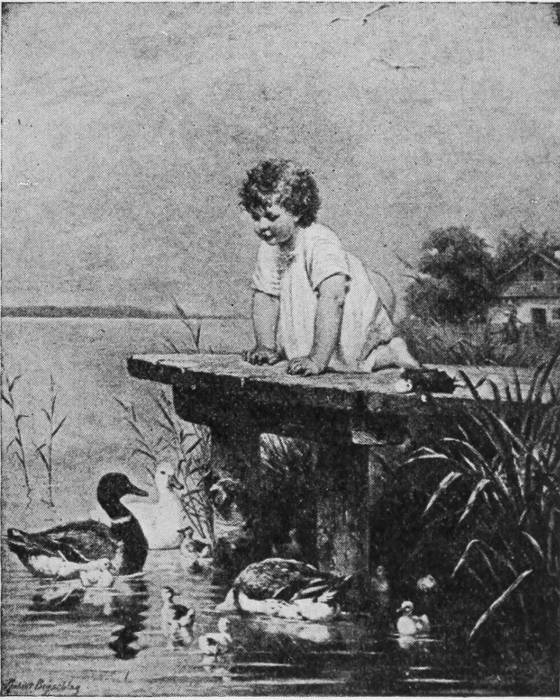
Willie and His Pet Ducks
If the duck farm is large enough and has a pond or stream, the keeping of ducks is very easy. They are nearly free from disease and need little looking after. Some kinds of ducks are very handsome, their colors being bright and varied. The male of the common duck (known as a drake) has a splendid plumage in its wild state. The head and[188] upper neck are of deep emerald green. Lower down is a collar of white, and the lower neck is of dark chestnut. The wings are of a beautiful deep blue.
The tame bird is not nearly so beautiful. It uses its legs instead of its wings to get about, so that it almost forgets how to fly. This easy life and plenty of food helps it to grow and fatten, a fact that makes it better suited to man's use. It has long forgotten how to build a nest and almost how to sit on its eggs, so that in some places the hen is used to hatch out the young ducks. To see a hen going about with a flock of young ducklings looks odd to us, and when the little waddlers jump into the water and swim away the hen mother seems sadly scared. She fears that all her pretty ducklings will be drowned.
When the baby duck gets out of the egg and is ready to begin life it is shut up for a few days and fed on soft food, such as ground wheat and barley mixed with hard-boiled egg. After this it is let out into the field and set free to search for the animal food it needs. In Belgium, where many ducklings are raised, it is comical to see the breeder hopping about the field on big wooden shoes, kicking up the earth as he goes so as to force out the worms for the little strangers to feed on. It does not take them long to learn how to find food for themselves.
Of the different kinds of ducks we may name the Rouen of France as a fine and beautiful bird[189] and a good layer. In England the Aylesbury is the best, as it grows fast, is very hardy and lays many eggs. The Pekin duck is much like it and is highly thought of in this country, where large numbers of white Pekins are raised for market. The duck of India is new to us but has won its way among duck raisers. It is the best of its kind as an egg layer, its harvest being over one hundred and fifty eggs a year. Its flesh is very delicate so that it is much liked for the table.
While the duck is not so widely kept as the hen, there are places where it is raised in large numbers. In the United States there are duck farms in which as many as twenty thousand birds a year are grown. There are no farms like this in Europe, though in some countries ducks are raised in great multitudes. These are not allowed to grow old, being sent to market when eight to twelve months of age. They pay better when sold at this age, for after that new feathers begin to grow and buyers do not want them.
If we turn now to the Goose, we find it a swimmer like the duck, but larger in size and with a much longer neck. It belongs to the duck family, but does not eat animal food like the duck. It gets a good living off of grass and this makes it cheap and easy to raise. In Russia, where geese are kept in large numbers, the goose girl leads her flock every morning to the fields, lets them feed during the day, and brings them home at night[190] to the village. The goslings are given some ground grain for a few weeks, and then are left to feed themselves.
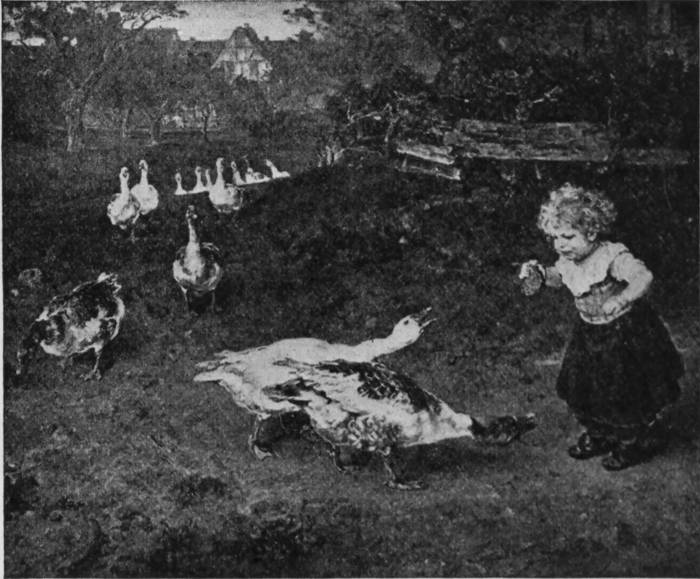
An Assault by Hungry Geese
The goose, like the duck, has largely gone out of the business of egg hatching, turkeys or large fowls being used to sit on the eggs. They are neither good hatchers nor good layers, the best breeds rarely giving more than thirty eggs a year. But they are hardy and healthy and do not die off like young chickens. They can bear cold easily, and though a shelter is made for them in winter, they always sleep in the open air in the summer.
The goose is a strong bird and can strike a hard[191] blow with its wing. In trying to catch them the keeper must be careful, for they are able to break his arm with a blow and have done so more than once. But they are good watchers for the farm. They wake very easily, and if a stranger comes upon the farm in the night they make noise enough to arouse the whole household.
This habit has given the goose a place in history. The Romans of old kept a number of geese in the temple of Juno on the hill where stood the Capitol. The goose was sacred to that goddess and it was the custom to keep a flock in her temples. One night a party of Gauls, who had laid siege to the city of Rome, found a narrow path up the steep hill and were almost at the top when the sacred geese heard them and made so loud a cackling that the garrison woke up and rushed out. Here the Gauls who had reached the top were flung down the steep hill, stones were thrown down on those that followed, and the Capitol was saved.
One of the best known breeds of geese is that of the Giant goose of Toulouse, usually about sixteen pounds but sometimes twenty-four pounds in weight. The Embden goose is still larger. The Giant goose of Italy is the only good layer, and yields about sixty eggs a year. In Germany and some other countries geese are driven for days along the roads, in flocks of several hundred. They are not easily tired and are good travellers, so that this is the cheapest way to get them to market.
As for the uses to which the goose is put, these are simply for food and for their feathers and quills, which are plucked several times a year. The fine, soft feathers are of much value for pillows and beds, and before the steel pen was invented goose quills were used all over Europe and America to make into pens.
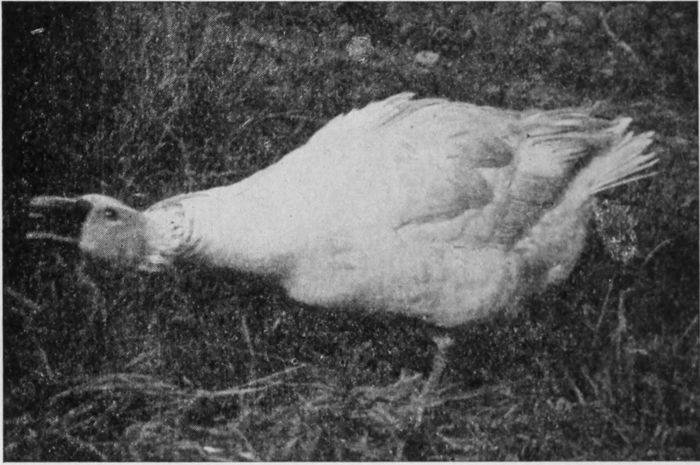
Gander Hissing at an Enemy
In England the goose is often roasted for the Christmas dinner, as the turkey is with us, and the gizzards, heads and legs are sold in sets, under the name of "giblets," to be used for pies. Goose liver has long been a dainty dish. It is made in Strasburg to grow very large by keeping the geese in a room at high temperature. In this state it is sold as a great delicacy under the French name of pâté de foie gras ("pasty of fat liver").
So far we have had to do with birds and beasts of foreign birth. As men from abroad have peopled our cities, so animals from abroad have peopled our fields, and we have not as yet met with one true American in the list.
It is lucky that I have a native American to offer you, and one that is in some ways the finest of all our birds of the farm. This is the Turkey, the largest of them all and the choicest when roasted and served upon the table. We may well ask, what would a Christmas dinner be like without this noble bird to fill the place of honor?
There are wild turkeys still in our woods, though the bullets of the hunter have left few of those once found there. These wild birds have certain odd habits well worth speaking of. Thus the male birds keep away from the females during a great part of the year, going about in flocks of from ten to a hundred, and feeding on grain, seeds, fruits, insects, tadpoles, lizards and such small game. The females go about singly or in flocks with their young. They take care to keep away from the old males, which have a bad habit of killing and eating the young.
Turkeys roost in trees but make their nests on the ground, laying from ten to twenty eggs before setting. These are much larger than the egg of the hen. The wild turkeys have small wings and[194] are poor flyers, so that when they try to cross a river a mile wide many give out and fall into the water. But they usually manage to swim ashore.
There are two species of wild turkey in America, one native to the United States and Mexico and one found in Central America. The latter is somewhat smaller than our home bird but is finer in color, its feathers being of a beautiful metallic-green or bronze color, with hues of black, gold and sky color. The male turkey has a habit much like that of the peacock. He spreads his large tail upward like a fan, while his wings are made to trail on the ground. In this way he struts round and round with great dignity, giving vent at times to a loud "gobble, gobble," an odd sound of his own.
The tame animal has the same habits, gobbling and strutting in the same way. Cared for and fed for the market, it grows to be a large and fat bird, with plenty of rich, juicy meat upon its bones. It is its size and the sweetness and delicacy of its flesh which make it a feast-day favorite.
The turkey is fond of roaming about and does not like to be confined to the poultry yard. On a large farm, where there is plenty of room to wander, the bird will do well and find most of its own food. But the young birds are delicate and hard to raise and it takes great care to bring them alive through babyhood. The hot sun hurts them and so do rain-storms and it is bad for them to get[195] wet by running through long grass. If they are carefully attended to for their first few weeks of life and fed on food fitted to their young tastes they can be trusted afterwards to take good care of themselves.
While this bird has long been one of the prized tenants of our home poultry yards, the same is the case in Europe. There is a Mexican variety, with a whitish tail, which was taken to Europe by the early Spaniards and has spread widely in that continent, where it is raised with great care.
There are few large farms in America and Europe on which these birds are not kept—not in large numbers like the hen, for they do not take kindly to home life and need much room to wander, but enough for the demand. They are first-class hatchers, and will sit on from twenty to twenty-four eggs. They also take very good care of their flocks and guard them from harm.
The turkey, as we all know, is a large bird. It may be had of many sizes for the Christmas table, from ten or twelve pounds up to twenty-five or thirty. While much attention is paid to it in this country, it perhaps gets still more in Europe. In our cities it is a sad case when a family cannot have a roast turkey for its Christmas dinner, and in England it is taking the place of the roast goose, once the favorite. But the goose still holds a pleasant corner in the British mind. Any of you who have read Dickens's story of Tiny Tim[196] and Bob Cratchit's Christmas dinner will be sure of this.
It is a queer fact that, while the turkey is the only American bird on our farms, it is at the same time the only one that has been given an old world name. It was early named after the Turks, under a wrong impression as to its origin, and the name has clung to it. It is quite as strange that the same must be said of the natives of America, who were given the name of Indians from the idea of Columbus that it was the land of India he had found. This name has also clung.
France is a country well suited to the raising of turkeys, and for hundreds of years the turkey has been a favorite bird in that land. Splendid birds are grown there, chief among them being the Solonge turkey. This is a bird of a brilliant black color, though now and then it is of white or steel-blue. They grow to be very large, one having been sent to the poultry shows of 1902 of the great weight of forty-five pounds.
This was sent to Spain to be seen and was visited in Madrid by the king and queen. On its return it took cold and when it got well of this it was killed by a fellow who did not believe in fat turkeys. The turkey was revenged, for the murderer spent five months in prison for his crime.
In some of the villages of France a woman is paid at the public cost as a care-keeper of the turkeys. Every morning she gathers her flock[197] in the village and leads them to the open fields like the goose girl of Russia. When she comes home at night with her flock she does not need to pick out those of the different owners. Every bird knows its home and goes there, never making a mistake.
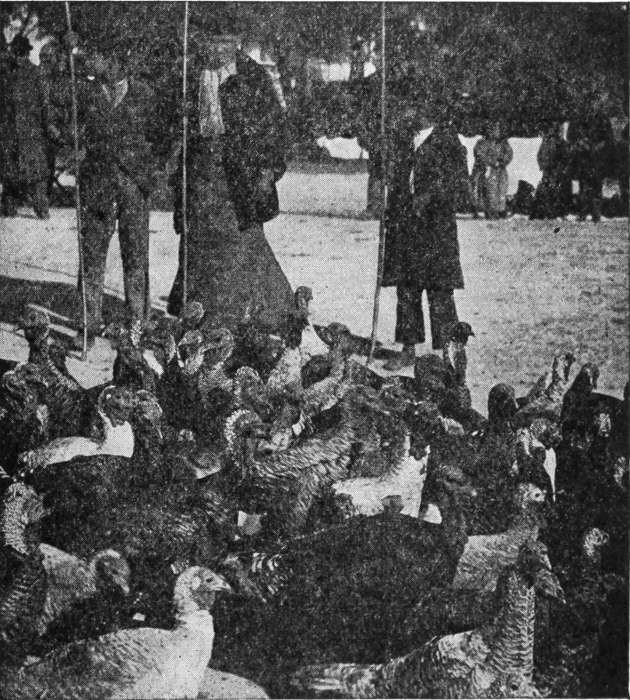
Driving Turkeys to Market
That is all we need now say about the turkey. The rest may be left unsaid till the Christmas[198] dinner, when the noble bird lies brown and steaming on his back in the great platter. Then the carver stands over him knife in hand and we hear from him the customary question, "Which will you have, white meat or dark?" To most of us it does not matter which so that we get a bounteous share.
The Guinea-fowl, of which we shall speak in passing, must be dealt with briefly, for it is not largely kept in our home poultry yards, though much attention is paid to it in some parts of the world. It is one of the few gifts which Africa has made to our home-life family.
This bird belongs in the pheasant tribe and is found in Guinea and South Africa. It also occurs in the north and was much liked by the ancient Romans. But it is better fitted to warm than to cold climates, and as the young are apt to die of infant troubles it is not kept in large numbers in our poultry yards. Yet the bird and its eggs bring good prices in the market.
The climate of Jamaica is just right for the Guinea-fowl and in that island it has made itself at home, taking to the woods and to a wild life. There it has become fond of feeding on the growing crops and is hunted and shot like a game bird.
The special fact about this bird rests in its color, it being prettily speckled with round white spots on a dark gray color of plumage. There are several species, the best known being the common[199] guinea, which is often called "come-back" from its call. In its wild state it gathers in large flocks and is very shy and hard to get near, while it keeps up most of the time a harsh cry which Latham compares to a door turning on rusty hinges or a wheel on an ungreased axle. In the farm-yard it perches at night in high places and if disturbed rouses up the whole neighborhood by its ceaseless cry.
The eggs of the Guinea-fowl are smaller than those of the hen and rounder in shape. They are of a reddish-white color, and are delicious eating. Many are laid and the female has the habit of hiding her nest until the young are hatched out. The flesh tastes like that of the pheasant, but is rather dry. It was served up at the Roman feasts, and is much liked now by many persons.
It may be further said about this bird that it is at times a nuisance in the poultry yard, for the male guinea has the tendency to attack the other poultry and act the tyrant over them. Another habit is to scrape in the ground like a hen. It also loves to roll in the dust and thus free itself from insects.
Next on our list of home birds is the Swan, one of the most beautiful and graceful of the whole bird race. When afloat, like a winged boat, on the still surface of lake or pond, with its snow-white body[200] and wings and its long, curving neck, it is a thing of beauty which we are all glad to see and enjoy.
The swan may still be found wild, but it has long been tamed and kept as an ornament of lakes and rivers and the broad ponds of country homes. Here it may be seen gliding softly along, with its white wings partly lifted, as if to catch the wind, and its neck gracefully bending as it moves.
In ancient times the swan was called the Bird of Apollo or of Orpheus, and was held to have splendid musical powers, singing most sweetly when it was dying. But this is a fancy of the poets, for the voice of the tame swan has no music in it, being only a sort of hiss, like that of the goose. There is a variety of the bird called the Trumpet Swan, but it is so noisy that few care to keep it. Also in Australia there is a bird called the Singing Swan, with a voice that might be spoken of as a kind of song. Some of these have been brought to Europe, but the common swan has no sort of song, living or dying.
There is an American species of the swan, which in winter may be seen flying in flocks as far south as Texas, but this has not been tamed. There is also a black swan found in Australia, and now to be seen in a tame state. It is deep black in color, except the main feathers of the wings, which are white. It is not nearly so pretty as the white swan, but when black and white are kept in the same pond the contrast is very fine.
The black-necked swan of South America is thought by many to be the most handsome of them all. Its bright white body and black neck make a pleasing contrast. When tamed this bird keeps to its own part of the pond, as if too proud to mix with common folks, and will fight them off if they come too near.
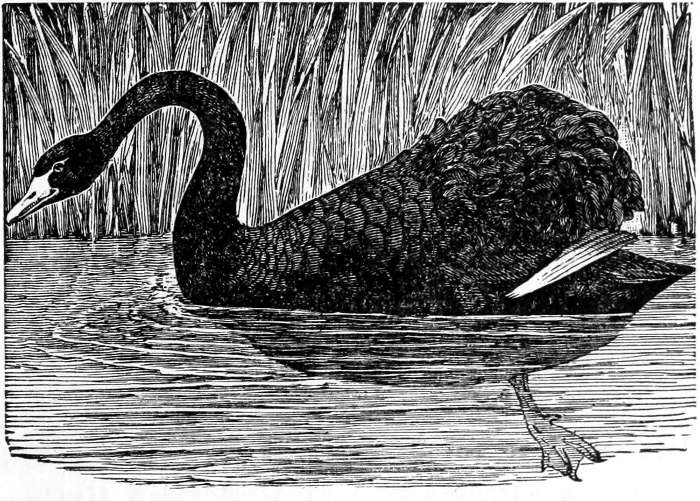
The Black Swan of Australia
In fact, the swan is always ready to fight if it is meddled with. Quiet and docile with its friends, it does not like strangers and will make furious attacks on its enemies. When the mother bird is going about with her flock it is best to keep out of her way, for she is jealous of her brood, and if the male bird is near he will not bear meddling with his family party. He will attack men and dogs alike if they come too close and drives away the other birds of the pond. His weapons[202] are his strong wings, with which he can deal powerful blows.
Under the law of England the swan is a bird royal. All swans found on sea or river in a partly wild state are claimed as birds of the crown. These royal birds are marked in a special way and whoever steals one of the king's marked birds may be punished as a thief. The same is the case with tame swans and with swan's eggs. He who steals or destroys the latter is liable to a fine of five shillings for each egg.
The mother swan lays from six to twelve eggs, on which she broods for thirty-six days, while the father bird keeps at hand with a sharp lookout for meddlers. They make their own nests and take care of themselves, though a little island is often built up in the middle of the pond with a straw-lined shelter in which the nest may be made. After they are hatched, the little swans take boldly to the water and swim about in search of food. They are gray when born and do not gain their dazzling white color until they are two years old.
Swans live chiefly on plant food, but they are also fond of fish spawn and will destroy this in great quantities, thus helping to keep down the crop of fish. In the tame state they are fed by throwing food upon the water, though they may be taught to come ashore and seek their food in a fixed place.
In Belgium there is a flock which has been taught to come to the casino of the military officers for its meals. The casino stands close to the canal and steps go down to the water. Every afternoon at feeding time the swans may be seen coming up the steps from the canal and crossing the street to the kitchen of the casino, where they make a signal by knocking on the floor with their beaks. The cooks then throw them food. After this is eaten they make their way, at the command of the head-cook, in a straight line back to the canal, heedless of men, dogs, or wagons which may be in their way.
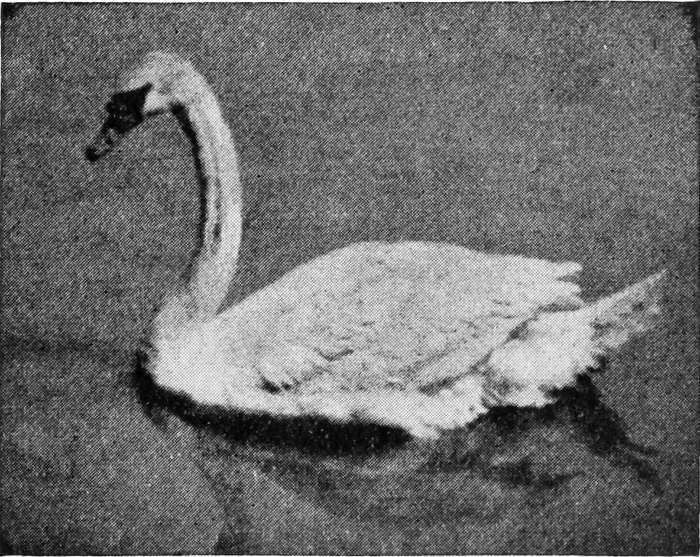
The Graceful White Swan Swimming
In former times swans were used for food, and it was common at every great feast in England to serve up roast swan, there being special rules how it was to be cooked and the proper gravy made.[204] Swan's quills were also used for pens. In our days it is seldom eaten and quill pens rarely used, and the only value to be had from the swan comes from its downy feathers and its large and beautiful wings, which often bring good prices.
Among all the birds of the poultry yard first in display stands the peacock, one of the most splendid in show of all birds. This fine fellow, with his glowing colors and royal tail, has some claim to be proud of his looks. Any of you who have seen him will agree with me in this. For those who have not seen him I must try and tell what he is like.
Rising from the head of the peacock is a crest of feathers of the most brilliant green and gold, while all its plumage is richly colored. But its finest feature is its splendid train, a great circle of feathers which rise above the tail and which it can lift into a glowing circle of wonderful beauty.
Of these feathers the middle ones are sometimes more than four feet long. They grow shorter on each side till they form a complete fan. All of these are spangled with eye-like richly-colored spots, so that a peacock with its tail spread is one of the most brilliant objects in nature.
Well he knows how royal is his dress, and dearly he loves to show himself to the plainly-dressed ladies of his flock, strutting about with full spread[205] train and turning slowly round that they all may see how lovely an object he is.
Once each year this proud fellow loses his fine feathers, and at this time he tries to keep out of sight, as if ashamed of his plain attire. But they soon grow again and once more he comes forward to show himself to the world.
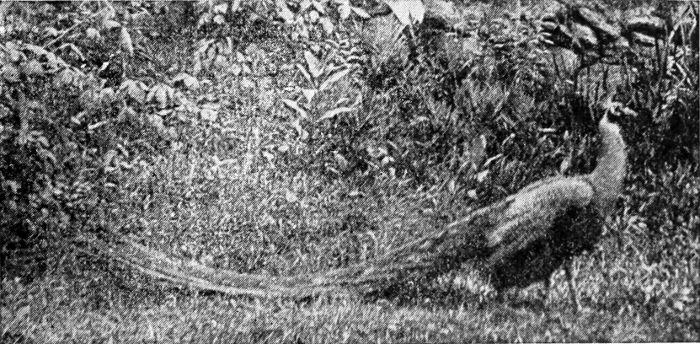
Lippincott's Primer
The Peacock, the Most Gorgeous of Home Birds
This bird comes from India and Ceylon. There is another species in Java which is said to be still finer in its display. We are told that "its crest, head and neck are rich green, the breast bluish-green margined with gold, the back bright copper-color barred with green and light brown, and the upper tail coverts rich green with gold and copper-color reflections." Nature seems to have done her best to lay splendor on this royal son of the tropics.
What else shall be said about this bird, aside from the beauty of its colors? In its younger days this does not appear, the sexes being alike in plumage when they are young. The male is three years old before its days of show begin. The cry of the bird is a shrill sound like Pao, and it also makes an odd noise by rattling its quills. It is given to quarrels and keeps to itself at night, roosting high in the trees. Its chief food is grain, though it also eats insects and worms, and if it can get into a garden it is sure to make mischief before it is found out.
In the woods of India the peacock is said to be often seen in company with the tiger, though why no one knows. It is not easy to learn in what way these two can help each other or what tastes they have in common. If the taste of the tiger is for the meat of the peacock, the bird would be likely to keep out of its way.
How long it has been since the peafowl was first tamed we cannot tell, but the Bible speaks of it as being known in Palestine in King Solomon's time. Alexander the Great seems to have brought it from India to Greece and after that time it was well known in the west. The Greeks and Romans called it the bird of Juno, and the rich Romans, who would go to any expense to make a new dish for their tables, are said to have eaten the tongues and brains of the peafowl. How many of the birds must have been killed to serve for one foolish dinner!
In our days the eggs and young are said to make good eating, but the birds are kept usually for their beauty alone, though their splendid tails are used at times as an ornament.
Is there not something very soft and tender in the word dove and in the loving ways of this fine bird? When we speak of the Turtle-dove there rises in our mind an image of tenderness and love which never comes to us when the Pigeon is named. Yet these two are the same. Pigeon and dove are two names for one family of birds.
Long ago the species known as the rock-pigeon was tamed, and this is the one that lives with us in such numbers as one of our chief home birds. The place we keep him in is often called the dove-cot, and in this way the two names are still kept together. The wild rock-pigeon, the ancestor of our tame pigeon, is also known as the ring-dove, so that the term dove-cot fits very well.
The pigeon is our one bird of the air. The other tenants of the poultry yard have long given up the art of flying, except for a very short distance, but the pigeon is a great flyer still and spends much of its time on the wing. It is indeed one of the fastest of flyers and thinks little of a journey of a hundred miles through the air. But it never forgets its home and if taken away will wing its way straight back again.
The pigeon has been a companion of man for ages past. It is spoken of in the annals of Egypt at a date five thousand years ago and has been at home in city and village ever since. With its wonderful power of flight it seems strange that it does not leave us never to return, but as it has nothing to escape from and much to come back to, the pigeon can be trusted with the fullest liberty.
It is, in truth, a trusty bird, gentle and lively in nature, fond of society and faithful to its own. It loves its home, and tenderly caresses its mate, with a graceful show of affection. Under its name of the dove it has long been held as the emblem of peace and innocence, and the phrase "billing and cooing," so often applied to lovers, is taken from its love-making methods.
In the old countries of Asia the pigeon was held to be a sacred bird. In Greece it was the bird of Venus and was kept in great flocks around the temples of this goddess. From Greece it spread to Rome and thence to all Europe, and in time became the Christian symbol of immortal life, the white dove being looked upon as the bearer of souls to heaven. This idea still survives and less than two weeks ago I saw a beautiful white pigeon set free over a grave and fly upward as one on a heavenly errand.
In the city of Venice the pigeon is a favorite bird that has won the affection of the people.[209] Clouds of them circle around the cupola of St. Mark's church and the roof of the Doge's palace, and the man who sought to catch or harm them would do so at peril of death from the people.
Birds build all sorts of nests, some good, some bad, some very bad. Those of the wild pigeon belong among the very bad, and there is a reason for this, if we can believe a story that is told about our feathered friend.
This story says that the father of all the pigeons tried his best to make a good nest but kept making bad ones. In the end he asked the magpie, who made fine nests, to show him how it was done. He agreed to give the magpie a cow in return for a lesson. After watching the magpie for a few minutes he said that he knew all he wanted to and would not give the cow.
A judge was called to settle this case, the verdict being that the pigeon had broken his contract and could not claim any further lessons. So ever since that time the pigeon has built the worst kind of nests.
The pigeon nest-builder is here spoken of as "he," for it is the male bird that builds the nest, the duty of the female being to supply the eggs. And he also takes part in sitting on the two eggs with which the female begins her brood. The young pigeon is a blind and helpless bird when it comes from the egg. It is at first fed with a sort of broth made in the crop of its parents, and all[210] through its bird babyhood it needs close care, both from its father and mother and from its owners.
A dainty and pretty bird it grows to be, one that charms us by its fine shape and its rich colors,—blue, gray, red, yellow, white or brown,—also by its swift and graceful flight. It needs to trust to its wings to escape its enemies, for neither its claws nor its beak are made for fighting. But its eyes are sharp and its great swiftness saves it from harm. So keen is its sight that it can see a morsel of food, such as a pea or seed, at a long distance. A quick swoop, and it has the food in its beak.
Much might be said about the care of the dove-cot or pigeon-house, but it is too long a story to be given here. We can only say that much needs to be done in keeping the house clean and fit for its purpose and in caring for the birds. Its diet is made up of peas, beans, corn, oats, barley and potato, with hemp seed for a special delicacy, while it picks up many other bits of food in its daily flights.
It is wonderful how many kinds of tame pigeons have come from their wild ancestor, the rock-pigeon. Of no other animal except the dog are there so many and it is hard to believe that they all came from one source. A few of them may be named, for the whole list is far too large for our space.
Among the various kinds may first be named[211] the Tumbler pigeon. This bird flies to a great height, then sinks and soars in circles and curves, turning somersaults in the air. All at once it drops down in nearly a straight line; then stops short, hovers on its spread wings, and flies upward to begin the play again. A flock of these tumblers will keep in the air for hours at a time, enjoying themselves and pleasing their friends below. Of these tumblers there are many varieties, different in color, shape and size.
A very odd kind of pigeon is the Pouter, in which the breast stands out until it is like a great food chest, for the swelling is due to the great size of the upper stomach. As a result the head is thrown back almost out of sight behind this swollen chest. This gives the bird a sulky, pouting air, from which comes its name of pouter.
Of the other kinds we may speak of the Frilled pigeons, with the breast feathers frizzed like a shirt frill; the Fan-tails, the tails of which spread out in the fashion of those of the peacock; the Russian Drum-pigeons, which do not coo, but make a sound like the roll of a drum; the Capuchin, with a white hood and tail and a dark tuft on its forehead; and the Lark, Magpie, Swallow, and Starling-necked pigeons, all with something to suggest these titles.
So far we have said nothing of the Carrier pigeon, for that claims a place for itself. It is a bird of noble bearing, with no show of fine feathers, since[212] it looks more like a wild than a tame bird, but with a splendid power of flight, one which no other pigeon can match. Its great value is that when taken to a long distance it has a wonderful power of finding its way home. This makes it of much use as a messenger bird, a kind of natural telegraph which was used centuries before any other telegraph was thought of.
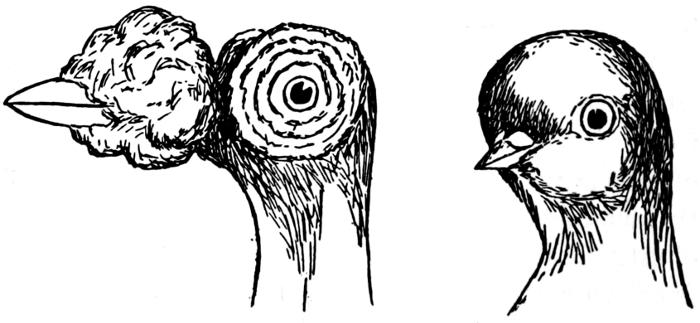
Pigeon Types. Carrier and Short Faced Tumbler
No one knows how the carrier pigeon finds its way home. Most likely its keen power of sight has much to do with this. When set free, it flies upward into the air in widening circles to a great height, as if trying to see something known to it in the far distance. In the end it darts off in a straight line, which ends only when it has reached its mate in the home dove-cot. Of course it needs to be trained to this by shorter flights, but a well-trained pigeon will find its home when a hundred miles or more away. The message is written on a[213] piece of very thin, light paper, tied under the bird's wing or to its leg.
The history of the carrier pigeon goes far back in time. In the days of ancient Greece winners in the public games sent word of their victory to their friends by pigeon post. A real pigeon postal-system was founded in the Arabian empire by the Sultan Noureddin, who died in 1174, and this was kept up until 1258, when Bagdad, the capital, was taken and destroyed by the Mongols.
In later years, during the wars of Napoleon, large gains are said to have been made by the Rothschilds, the famous bankers, who received news of great events by pigeon post and used those news for stock buying and selling. The newspaper press has also made much use of messenger pigeons. The greatest case of this was in 1870, when the city of Paris was besieged by the German army and all the telegraph wires were down. News was sent out from Paris, in microscopical writing so fine that a single bird could carry thousands of messages at once. Military pigeons are still trained for use in case any war should arise. In the German city of Cologne there is a station with five or six hundred pigeons, trained to fly to the fortified places of the empire.
After our talk about the pigeon, with its swift powers of flight, we now come to a bird which has[214] no power of flight at all, yet which is of much value to us from the splendid feathers of its wings. It would take strong wings indeed to lift from the ground the ostrich, the largest of all birds, standing six to eight feet high. But what it lacks in wings it makes up in legs, for it is a wonderful runner, being able to outrun the fastest horse. As it runs it spreads its wings, which seem to act as sails.
The ostrich has often been tamed and thus it may be classed with birds of the home, though much too large for the poultry yard. It grows quite friendly to those who have it in charge, but does not like strangers and is apt to attack them in a violent manner. As these birds are plentiful in the great Sahara desert, they were often kept by the Romans and used in their public shows. They were also used as food, and a glutton among the Roman emperors is said to have had the brains of a large number of ostriches served up to him in a single dish.
The people of Africa are very fond of ostrich eggs and travellers in that land also speak well of them. Each egg weighs about three pounds, so that one of them is equal to about two dozen hen's eggs. The egg is cooked by being set on end in a fire and its contents stirred about with a stick thrust into a hole in the upper end. The shell is so thick and strong that it is used in Africa as a water vessel.
It is not for its brain or its eggs that the ostrich[215] is kept in our days, but for its fine plumes. These bring such high prices that the birds are tamed and kept on what are called ostrich farms in order to get a good supply of those rare feathers. The first farms were started in South Africa in 1869, and they have since spread to other countries. The birds need warm regions, the only states fitted for them in this country being California and Florida.
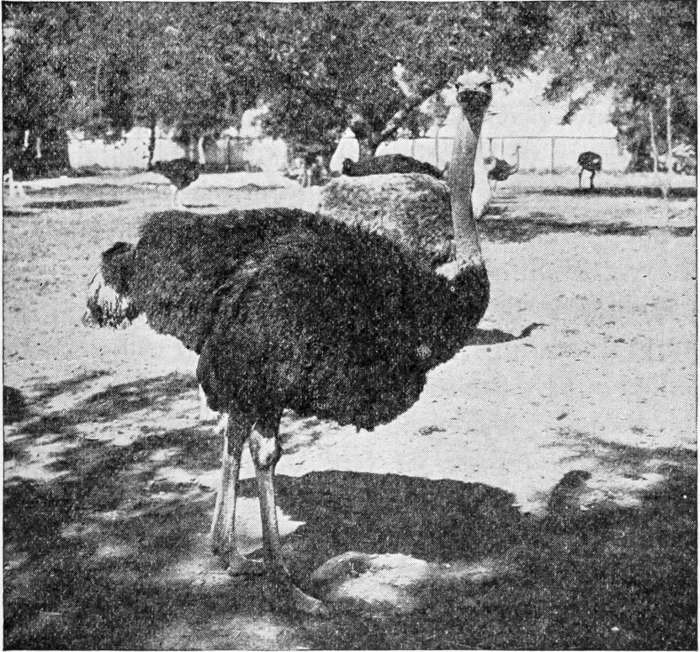
On a California Ostrich Farm
The long, white, beautiful ostrich plumes so highly prized by ladies all over the world grow[216] in the ends of the wings of the male birds. A good bird, in the prime of its life, will yield from twenty to forty of these, and also a few black feathers from the wings. The tail feathers are of much less beauty and value.
In the early days of the industry the feathers were worth $500 a pound and the plumes of one bird would sometimes bring $125. But they have now become so plentiful that the price has gone down to less than one-tenth of these figures.
To pluck the feathers, the bird is put in a box of such small size that it cannot kick. It does not enjoy the plucking, and a kick from its great leg is enough to break a man's bones. We can understand its feelings, for the feathers used to be cruelly pulled out by the roots. Now they are cut, leaving the roots of the quills, which can be pulled out easily in a month or two. As for the use and beauty of these superb plumes we need only to view the hat of a lady which is adorned by one or more of them. The whole bird kingdom yields nothing more beautiful.

If you look back over the earlier pages of this book, you will find that it deals with animals in some way of use to man, creatures that guard his houses, help him in his sports, serve him as food, carry him on their backs, haul his carts and wagons, and in other ways help him to live and thrive.
But our home friends are not all of this useful kind. There are some that we keep just because we like to have them with us, and make friends of for their sweet songs, their beauty of form or color, and the love they give us for the love we give them. These are the song birds of the home, the pretty little winged warblers which we keep in cages to save them from the prowling cat and to hinder them from flying away, but which we do all we can to make happy and joyous, and which pay us back in their own charming way.
There are many of these cage-pets. The one that we see most of is the canary, but there are many others for which we find room in our homes and are as glad to keep as they seem glad to be[218] kept. Among these birds of the cage and the aviary are the linnet and the bullfinch, admired for their beauty of color; the mocking bird, with its wonderful power of imitating the songs of all the feathered brood; the thrush, a singer of fine powers; the finch, with its cheerful whistle, especially the bullfinch, splendid in color and varied in song; the bunting, the lark, the wagtail, and various others admired for beauty or sweetness of song; and to these we must add the strange and amusing bird talkers, such as the parrot, which has wonderful powers of learning words and fitting them into the right place, a bird that fairly makes us jump at times by the neat way in which it says the right thing at the right time. Then there are the magpie, the jackdaw, and the starling, ready talkers and good company for the lonely.
Of the home birds the gold-hued Canary comes first, as the chief favorite among them all. From its native home on the Canary Islands it has been taken to Europe and America and kept so long in cages that it has quite forgotten its old-time liberty, so that a canary-bird escaped from its cage is the most helpless creature in the feathered flock, and is likely to become the prey of the cat if not captured and brought back to its cage-home.
The wild canary is not noted for its beauty and not greatly for its song. It is found in large num[219]bers in the Canary, Madeira, and Cape Verde Islands, and is of a greenish-yellow color, with gray tail and wings. It is the art of man which has made the home bird what it is and has given it its color and its fine vocal powers. When the Canary Islands were occupied by the Spaniard in 1478 these birds were taken in large numbers to Spain, from which they spread over Europe, becoming the pets of many a cottage and castle home. In many of the old pictures we see their little forms, now perched in a corner, now sitting on a lady's finger.
The canary belongs to the family of finches, its place being between the linnet and the goldfinch. In its native islands it dwells near man, building its nest—of moss, feathers, hair, etc.—in thick, bushy places. The hen-bird lays an egg every day until from four to six are in the nest, on which she begins to sit. In thirteen days the young birds appear and in thirteen more they are able to fly, but their parents feed them for some time longer, on grass seeds or other plant food.
We must say that this bird enjoys cage-life, for it seems very happy in its narrow home. It becomes quite tame and fearless, grows to love its mistress, and sings with a freedom that speaks of a joyful heart. In its wild state it is fond of bathing, and it is needful to give it a frequent bath in its cage, if it is to be kept well and tuneful.
The cage-canary is a home bird, unlike the bird[220] of the free air. It has been made over by man and fitted for its new life. Early in its cage career the country people around Innsbruck, in the Tyrol, became active in raising these little vocalists, and from there they spread to Germany and the Netherlands. To-day they are raised in large numbers in the Hartz Mountain region of Germany, where great care is taken in teaching them to sing. They are also raised and taught in other countries.
The canary is very ready to take on new songs and its trainer is careful to keep it from falling into bad habits. If a bird happens to hear a bad note it is apt to take it up and it is hard to break it of the fault. So the good singers are kept where they cannot hear those of poor voice, and a number of the finest singers are kept as models to teach the young birds how to sing.
Bird lovers have their tastes. Some like a loud song, with high notes and long trills. Others prefer a soft, warbling, flute-like note, with clear flourishes of song, and no one likes these to be broken by a sharp "Chap-chap" or "tsi-tsi" or other vocal fault.
It takes nearly a year for a canary to gain its education. In that time it will learn several airs. Some of these may be forgotten, and then the model songster is brought near so that they may be learned again. It is said that some canaries have even been taught to speak a few words.
Sometimes a bird that has a shrill or too sharp note is kept in the shade until this is corrected. And the canary often sings better in the little cages of the dealers than in the large, fine cages of its final home. Thus singing birds as well as singing people have their own fancies.
Rape and hemp seeds are the principal food of these birds. A little flax-seed is also good for them, as it helps to fatten them. They are fond of flowering groundsel and chickweed and a very small supply of these is good for their health. They also have a sweet tooth and are very fond of sugar.
Shall we say something about the different breeds of canaries? There are numbers of them and each country has its own. We can tell the breeds apart by their shape and song. Thus the English canaries are very tall, with a tuft or top-knot on the head. The French breed is noted for its slender form. In Germany more heed is paid to song than to shape. Holland was long known for a fine, strong race which is still called the Dutch canary, though it is no longer to be found in that country. In the United States shape and color are the points looked after, birds of elegant form being preferred.
The Belgian canaries have been called the "nobles" of the canary race. They are large, with narrow, flattish head and very gentle eyes. The neck is flexible, the head is carried straight forward and the back and tail bend almost straight[222] downward, this giving the bird an odd appearance. Its little form and the way it carries its head, with the mild look in its eyes, are notable points. The Scotch Fancy canary, now common in England and the United States, is like the Belgian but has a much flatter head.
We have said much about the canary because it is far the most common of cage-birds, but we have at home a bird of our own, not so often kept in cages, but in its way one of the most marvellous of birds. This is the Mocking-bird, a native American with so rich and tender a voice that in the West Indies, where it is very common, it is called the nightingale. This is due both to the melody of its song and its habit of singing at night.
It is not quiet in the day-time, but then shows its powers in a different way. It is this that gives it the name of mocking bird, for it has a wonderful power of taking up the songs of other birds, imitating them so exactly as to cheat the ears of all that listen. Now it takes up the song of one bird, now of another, and fills the air with its fine mockery. By night, when other birds are apt to be still, it keeps to its sweet native song, but by day takes delight in its strange faculty of imitation. Not only does it repeat musical tones, but also the harshest tones it hears, making of it all a strange medley.
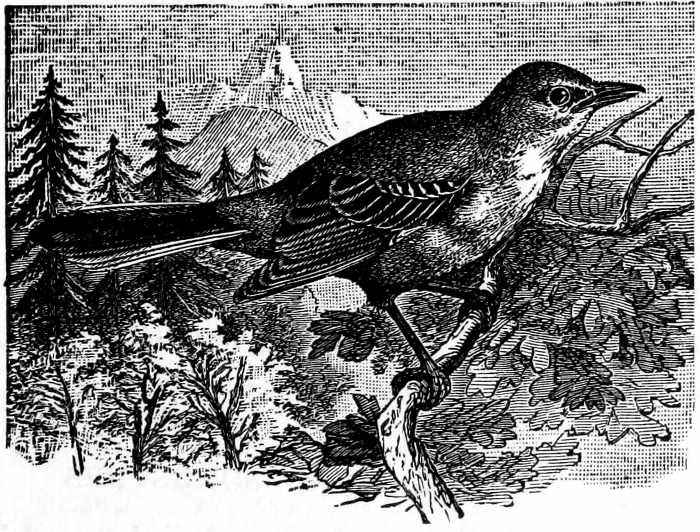
The Mocking Bird. No other Bird has such Versatile Vocal Powers
This is seen in a striking way when the mocking bird is caged. Then it mocks the many sounds around it. It will bark like a dog, mew like a cat, crow like a cock, cackle like a hen, creak like a wheelbarrow, and take up a host of varied sounds. And while doing this it spreads its wings, expands its tail, and throws itself about the cage as if it was having the best time of its life. It can be easily taught to whistle a tune of some length, but never seems to imitate the voice of man.
It rarely, however, sings as well in the cage as in its free state. The wild bird seems to like to be near man and often builds its nest in a tree or bush close to a house. While the female bird is sitting the male is very wide-awake and shows the greatest courage in driving enemies away from the nest. In the brooding season they will often gather[224] in flocks and fight off birds of prey of much larger size. A snake that comes too near is killed by a quick series of blows on the head, and the cat soon finds that it is best to keep away from the mocking bird's nest.
There is another bird of the same family that dwells much farther north, being common as far north as Massachusetts. It has powers of imitation like those of the mocking bird and a sweet song of its own, but when disturbed gives vent to a sharp, mew-like cry from which it has got the name of Cat-bird. Like the Mocking bird, it builds its nest near man and makes no attempt to hide it, but fights off enemies with a like boldness. No one thinks of caging this bird, for its cat-call is not at all pleasant and has given it a bad name, but its song is pleasing to our ears.
The smaller birds are often so bright and beautiful and have such musical voices, that many of them are made tenants of the cage. Here they do not seem sad or mournful, but are likely to make themselves much at home.
There is the Bullfinch, a nervous, uneasy fellow, always in a flutter, yet easy to keep in cage life and ready to raise a family in captivity. These birds are at once beautiful and tuneful. In color they are as handsome as many of the birds of the tropics, while they can be taught a variety of bird[225] airs. They need to be coaxed, and their tutor must use the same coaxing words and gestures and even wear the same coat when he gives his bird its lessons. But a well-taught bird brings a high price and it pays the poor folks of parts of Europe to spend much time in teaching them.
It takes time and trouble to teach a bullfinch to whistle a tune, but it pays for the labor. A young bird must be taken from the nest before it has begun to twitter and kept where it can hear no sounds except those made by its teacher. In this way it fails to learn its native tones and may be taught to do wonderful things, whistling a whole tune as well as any boy could do it. I can prove this best by telling a little story.
There was a flute-player at a London theatre who had an ebony flute with silver keys. But he did not often use it, for one of its upper notes was not good. He lived with a tailor and the two were great friends.
One night, while he was at the theatre, some one stole his silver flute. He could not think who had done it, except it was an old woman who did the work of the house. But nothing could be found out and in time the loss was forgotten. A few months later the tailor moved to a town some miles away, but the two were still friends and at times paid each other visits.
Once, after a year had gone by, the flute-player went to see the tailor, and was pleased to find that[226] his friend had a splendid bullfinch, which could whistle three tunes. But there was something curious about these tunes. Whenever the bird came to a certain high note it would skip this and go on to the next. The musician was quick to notice that this missing note was the very one that was wanting in his flute. He sharply questioned the tailor, who was forced to admit that he had stolen the flute and had used it in teaching the bird its tunes.
There are many other birds that can be taught to whistle tunes. The English blackbird is one of these. A writer tells us a pretty story of this bird. He says:—
"I once knew a bird that could whistle 'Polly Hopkins' with wonderful accuracy. His owner sold him, at the same time making the purchaser acquainted with the bird's favorite tune. As soon as the gentleman got home he at once hung up the blackbird, and, going to the piano, struck up 'Polly Hopkins.' But he introduced parts into the tune that the bird had never heard before; so, after listening awhile, the little critic began hissing, fluttering his wings and thus showing his distaste. Much surprised, the gentleman left off playing, and then the blackbird opened his throat and favored his new master with his version of 'Polly Hopkins,' nor would he ever listen with any patience to any other version."
I must also tell the story of the wood-chopper's[227] ghost. Once there was a lively wood-chopper who was always whistling and singing while at work. But in spite of his jolly temper something went wrong and one day he hung himself in his shop. Some days later other men at work in the wood-shed were dreadfully scared by hearing the dead man's favorite tune, "William at the Garden Gate," whistled in his old way. There was a rush from the shop, which they thought haunted, and as the tune was kept up day after day, no one would go near the place. Finally the mystery was made clear. A thrush was seen to fly from a near by grove to the roof of the wood-shed and pipe up the ghostly tune. It had learned it from the wood-chopper's lips and came back every day to the same spot to whistle the tune.
The Skylark, a very common bird of Britain and Europe, is so famous for the charm of its song that many of the poets have sung its praises in rare verse. It does not, like many birds, sing when sitting, but pours out its voice when on the wing and when far up in the sky. From this it gets its name. From the upper air its sweet notes come tumbling down in pearly music, "the notes nearly all alike and in the same key, but rapid, swarming, prodigal, showering down as thick and fast as drops of rain in a summer shower."
This is a favorite cage-bird, one that lives many years in its narrow home. It sings in the cage as sweetly as when in the air, pouring forth its song[228] many times in an hour and for weeks and months together. It is also a loving little pet and grows very fond of those who care for it.
Of course all of you have read of the Nightingale, the Bulbul of the Persian poets, a bird whose very name seems to sing. This little songster has for ages been famous for its loud, rich and varied tones, its song being full of long, plaintive, quivering strains. Singing all night long, when most of the birds are still, it has been a favorite among bird lovers and poets in all lands, the Persian poets making the loves of the bulbul and the rose a theme of many of their verses. Its song has a mournful tone, but as it is sung to its mate in the nesting season, the sadness in its voice must keep company with gladness in its heart.
The nightingale is often kept as a cage-bird, and if taken before the nesting season soon grows to like its prison life, but if taken after it has joined its mate it will pine away and die. It is best to take it from the nest when young and bring it up by hand. In its wild state its song ends with the end of the nesting season, but in the cage it is kept up for a much longer time and is very pleasing.
For an American nightingale we have the mocking-bird, a sweet night singer which, as I have said, is given that name in the West Indies. Another is a variety of the Grosbeak, called the Cardinal Bird from its red color. This is called the Virginia Nightingale in England and is one of[229] the finest American song-birds. Its loud, clear, sweet song is heard chiefly in the mornings and evenings and the beauty of its plumage adds to its attraction.
The thrushes are also fine cage-birds, the black thrush having a lively whistle and the art of taking up the songs of other birds. In this it is far from equal to the mocking bird, but with care can be taught to sing a number of bird airs.
The Song-thrush or Mavis of England is well-known through Europe as a singer of fine powers, one of the best of the songful train and a rival of the nightingale in its power of song. Another of the same tribe is the Missel-thrush, with a good voice but not the equal of that of the Mavis.
One of the sweetest of American bird singers is the Wood-thrush or Hermit-thrush, not as a cage-bird but as a haunter of secret places, from which its voice comes rich and full, sweet and placid, like the notes of a flute sounded in the morning air.
So far I have spoken only of the singing and whistling of birds, but there are other things they can be taught. Many have seen trick birds—the goldfinch, the canary, and other birds—that could do wonderful feats. They have been taught to fire little cannons, to pretend to be dead, to climb a ladder, to stand unmoved when fireworks were set off, and many other things of strange kind.
But if those who have seen these tricks knew how the birds were taught they would never go[230] again to see them, for it is said to be done by cruelty. But there are bird tricks in which no cruelty is needed. Thus a bird may be taught to draw up water to his cage by means of a tiny chain and pail, pulling at the chain with his beak and holding every link drawn up with his feet. He may also be taught to ring for his food. A little bell is hung in a corner of his cage and he is kept a few hours without seed. Then, by a thread fastened to the bell, it is rung and at once a few seeds are put in the bird's seed cup. The little chap soon learns that he is fed when the bell rings and it will not be long before he will pull the thread and ring the bell himself.
Chief among the talking birds are the parrots. These quaint and curious winged chatterers have long been kept in the home of man, for we have tales of them more than two thousand years old. It was 1504 when the first parrot reached England, but now they are to be seen in all parts of the world, some kept for their brilliant colors, some for their wonderful power of speech.
Best known among them as a cage-bird is the Gray-parrot, the ablest talker of the family, the amusing Poll-parrot seen in so many homes. Though a cage is provided, they become such home-bodies as to be given all the liberty they want, being often free to go about the house,[231] though they look upon the cage as their special dwelling place.
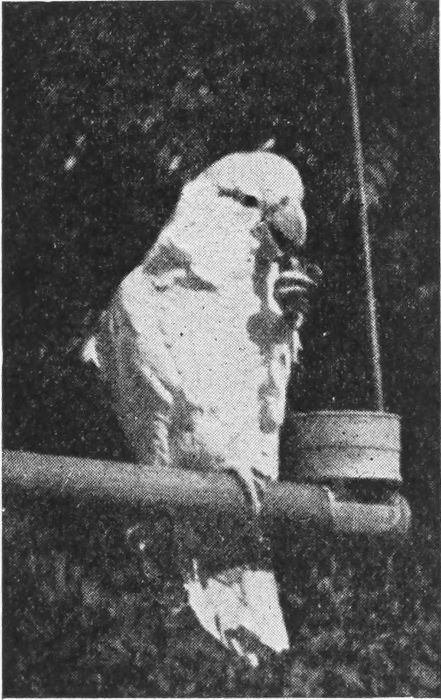
The White Faced Parrot
Poll-parrot has a great deal of human nature in his little body. He thinks, he remembers, he imitates, he enjoys a joke, loves his friends and hates his enemies, and when he learns words he often knows just what they mean and when and how to use them. When our parrot says "Polly wants a cracker!" it may not be a cracker that she expects but it is something to eat, and she is apt to keep up the call until she gets it.
There is no end to the tales about parrots and their odd speeches, often strangely fitted to the time and place. They can be taught to say a great many things, and often know just how to[232] bring them in. Here is one told by Mr. Romanes, showing a parrot's wit in a tricky way no man could surpass.
"One day the cat and parrot had a quarrel. I think the cat had upset polly's food, or something of the kind; however, they seemed all right again. An hour or so after polly was standing on the edge of the table; she called out in a tone of extreme affection,
"'Puss, puss, come then—come then, pussy.'
"Pussy went and looked up innocently enough. Polly with her beak seized a basin of milk standing by and tipped the basin and all its contents over the cat; then chuckled diabolically, of course broke the basin, and half drowned the cat."
Here is another story of parrot wit. The bird was making a variety of squeals and cries. One of the men who heard began to imitate her. This roused the parrot to try new cries, and at last she made one so odd that he could not repeat it, try as he would.
Proud of her triumph, the parrot gave a loud "Ha! ha! ha!" swung on her perch with her head downward, sprang about the cage, tossed a piece of wood over her head, and kept repeating the cry, followed by peals of "Ha! ha! ha!" till everybody joined in her wild laugh.
The parrot has a good memory and will pick up a good many words and phrases, even the verses of a song taught to her. Many she gets by[233] listening to words often said and at times will come out with a new bit of apt language to the surprise of every one who hears it. If a word she has once learned comes into her head, she often follows this word with all the other words and sayings learned at the same time.
Here is a parrot story going back as far as 1672, one which was much talked of at the time. It is of an old parrot of Brazil when Prince Maurice was governor there. The Prince was told of the strange talking powers of this bird and sent for it. When it was brought into the room, where were many men with the Prince, it began,
"What a company of white men are here."
"What is this man?" asked one, pointing to the Prince.
"Some general or other," said the parrot.
"Where did you come from?" asked the Prince.
"From Marinnan."
"To whom do you belong?"
"To a Portuguese."
"What do you do here?" asked the Prince.
"I look after the chickens."
"You look after the chickens," said the Prince, with a laugh.
"Yes, and I know well enough how to do it," and the parrot began to cluck like a hen calling chickens.
It is hard to believe that a parrot could keep up a conversation in this correct way, but the story[234] comes from Sir William Temple, who is very good authority, and who was told it by the Prince himself.
We are told of a French parrot which could laugh like a man, and would break out into a hearty chuckle when some one said (of course in French), "Laugh, parrot, laugh."
The odd thing was that it would follow the laugh with the words,
"Oh, what a fool to make me laugh!" and repeat this two or three times.
A lady had a gray parrot four years old which was very quick in taking up new words and very correct in using them. When he did some bit of mischief his mistress would scold him, to which he would reply angrily,
"Not a naughty Poll!" "Not a bold, bad bird!" and would stamp his foot, crying "I am not—I am not."
If she praised him he would tell her she was a darling and that he loved her. He was jealous when children were present and were made much of, and would cry,
"Go away, bold boy!" "Go away, bold girl," never mistaking between boy and girl.
When a visitor took off coat or shawl the bird would act as if trying to take off his wings, and laugh heartily at his performance if any one else laughed. He would play with the cats till he was tired of them and then whistle for the dog to chase them away.
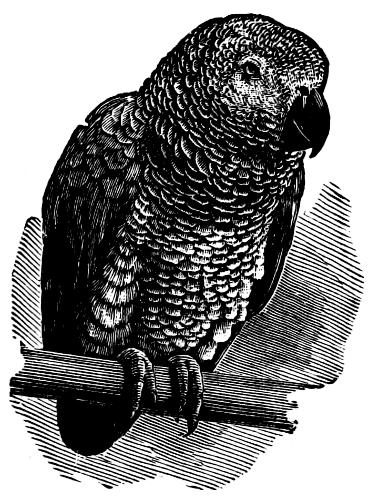
A Gray Parrot on His Perch. Waiting to Speak His Piece
We might go on and on with parrot stories, for they are endless. Very likely many of you could tell me as good ones as I can tell you. One thing of note about these birds is their love of a joke. Here is a tale of one of these jokers that loved to make fun of Carlo, the dog. Carlo would be snoozing in a corner of the room when polly would cry out in a voice exactly like his master's,
"Hi, Carlo! Cats!"
Up would jump the dog, rush into the garden, look fiercely round, then, hearing a fresh cry of "Cats! Cats! Seize them, Carlo!" would bound over the wall into the next garden. The next moment the bird, with a wonderful change of tone, would call out in the master's sternest tones,
"Come back, Carlo! Come back, you naughty dog!"
Back would come Carlo in a slinking way, as if expecting to feel his master's cane.
Another bird was fond of playing jokes of a different kind on the house dog. It would whistle and call out in a soft tone,
"Gyp, poor old Gyp! Does Gyp want to go out?"
The dog, delighted at the prospect of a run with its master, would begin to frisk and dance about, looking around to see where he was. This got to be a common trick with the bird, for the dog never found out that it was being tricked by the parrot.
Many of my readers must know that there are other birds that can talk, some of them as well as the parrot. Those who may have read the novel of "Barnaby Rudge," by Charles Dickens, are likely to remember the Raven of that story, with its "Never say die."
A very famous bird of this kind is Poe's raven, told of in the poem of that name, whose one word was "Nevermore."
These are birds of fiction and poetry but there are talking ravens in the annals of fact. There was one, some years ago, at home in a tavern at Stoke Newington, England, who could not bear gray or white horses, though it did not mind any other color. No sooner would a horse of the[237] hated color come up to the water-trough for a drink than Peg would perch on the edge of the trough and swear lustily at the poor animal. Or else it would start it off with a loud "Gee, whoa," in the exact tones of a carter.
One day Peg saw a sailor take some tobacco from a box at his elbow, put it in his mouth, and begin to chew. The bird watched him closely and seemed to fancy that this must be something good to eat, for the instant the man's back was turned she hopped up and took a mouthful of the weed. For the rest of that day Peg was a very sick bird, and even the next day was far from well.
She had learned a lesson which she did not forget. Some days later a white horse, drawing a hay cart, was driven up to the trough for a drink. Peg at once hopped up and began her abuse, but the horse had met the bird before and paid no attention to her impudence. At this she flew into the house where some men were smoking, caught up a paper of tobacco from the table, and flew back with it, dropping it into the horse's nose bag.
If a strange dog happened to stray up to the inn Peg was at once wide awake. Up she would skip, and when close to the dog's ear would shout in her loud, harsh voice, "Halloa, whose dog are you?" Before the cur could turn she would break out in a great show of rage and loud cries of "Hi! ho! go home!" which usually sent the intruder off up the street at a frantic rate.
The raven belongs to the family of the crows, in which are some other birds, as the Jackdaw and the Magpie, that can be taught to speak. They are not to be compared with the parrot, yet they must be classed with the talking birds. The magpie has the tendency of picking up words here and there of a sort not suited to polite society, and is not well fitted for a house pet. He is quite ready to try his sharp beak on his master and is like the crow in stealing every bright thing he sees.
The Magpie has a cousin, the Jackdaw, who is not quite his equal as a thief, but is not as honest as a parson. He also has the gift of speech and at times can use it with fine effect. The bird is easily tamed and taught to talk and there are some good stories told of him. One or two of these you may enjoy reading.
There is a small shell-fish called the cockle which is often pickled in England, and in a house where the folks were fond of pickled cockles was a jackdaw, who was quite as fond of them. The cook had pickled some of these and put them in a jar, covering it with parchment. But the next morning she found the cover partly ripped off and some of the cockles missing.
At a loss to know who had done this mischief, she tied on the cover again and went about her work. At midday, when she was busy over the stove, basting a roast joint, she heard a sound of tearing parchment and looked round to see the[239] jackdaw with his head hidden in the jar, feasting away greedily.
The cook at that moment had a ladle full of hot fat in her hand, and in a rage threw it over the thief, crying out "You rogue! you go to the cockles, do you!"
All the feathers were scalded off of Jack's head and he went about the house, bald and ashamed. Some days later his master gave a party, among his guests being one who was quite bald. In the afternoon the bird was brought up stairs to amuse the party, and he did so very neatly.
Flying to the mantel, he saw the man with the bald head. At once he flew to his shoulder, and cocking his eye at the bare poll in a funny fashion, cried out, "You rogue! you go to the cockles, do you!"
Another jackdaw belonged to a retired innkeeper, who, while in business, had taught the bird to say, "Mind the reckoning," and also to call out "No trust." His cage hung in the public room, where, no doubt, he helped his master in making a fortune on which to retire.
Long after he had gone out of business some burglars broke into the house to rob him, getting in through the window of the room where the jackdaw was kept. As the thieves talked in low tones about the job before them and what part of the house they should visit first, the words, "Mind the reckoning," came in loud tones to their guilty ears.
"Good Lord!" cried one of the scared thieves, "I trust we——"
"No trust! no trust!" came in the same hoarse voice, "Mind the reckoning! Mind the reckoning!"
Away went the scared thieves, through the window and over the garden wall, leaving their tools behind them, while the daw roused the house with its screams of delight over their flight.
The fashion of stealing of the crow tribe makes a pet crow not very safe to keep about. Any bright or shining thing, like a pair of scissors, a silver spoon, or a gold stud, is sure to take his fancy and when once in his beak the chance is that it will never be seen again, for he is a cute chap at hiding his spoils.
The crow indeed is a sharp fellow in more ways than one. He is an expert at tricks. Here is one told of the Indian crow.
A dog—a fox-terrier of good training—was one day gnawing a chicken bone on the veranda when two crows saw him at his meal and lighted on the veranda railing, where they began to croak. The very sight of a crow is usually enough to make a dog forget his breakfast and fly at the bird; but this time Jack merely growled and kept on gnawing.
As this did not work, one of the birds dropped down to the veranda floor and croaked again. Again Jack growled, but he went on gnawing.[241] The crow now strolled round the veranda for a minute till the dog was intent on his bone, then hopped up and gave his tail a sharp nip.
This was too much for the fox-terrier. With a howl of pain he turned upon the bird, when the other crow, which had been quietly waiting its chance, swooped down, snatched up the bone, and flew away, its comrade in mischief quickly joining it.
Jack's look of disgust, when he found how neatly he had been fooled by a pair of crows, was a sight worth seeing.
Have you ever seen a Starling and heard one talk? If not you have missed a treat, for this bird has fine powers of speech. He can whistle, croak and talk and is one of the choice delights of many a cottage home in Europe. He has lately been imported into this country.
The common starling is a very pretty creature, clad in brown, with purple and green hues, and a buff-colored tip to each feather which gives the bird a fine speckled appearance. In its wild state it has a soft and sweet song, and in a cage is a pert and friendly house pet, one that mocks the songs of others, learns to whistle tunes, and can talk as clearly as many of its keepers. I must tell the story of a pair of very cute and lively starlings, as it is told us by the gentleman in whose house these birds were born and brought up.
Dick and his wife lived in a large cage, with all[242] the things needed to make than enjoy life. Once a day the cage door was opened and they took a bath on the kitchen floor, Dick first and his wife afterwards, for he was a little household tyrant, cuffing his mate soundly when she tried to be first in anything.
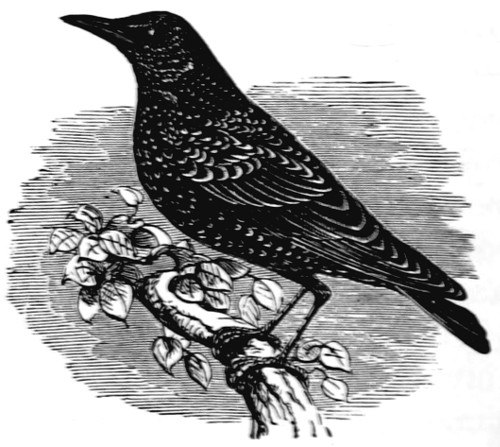
The Starling. One of the Talking Birds
Dick's first lesson was in imitating the rumble of carts in the street. Of this he was very proud and soon learned to speak his own name, always with the prefix "Pretty." He was always "Pretty Dick." As for his wife, he gave her the strange name of "Hezekiah." How he learned this no one knew, but he always used it.
Thus if his wife tried to join him in a song, he would stop and call out angrily, "Hezekiah! Hezekiah!" Then he would start again, and if she forgot his scolding and joined in again he was apt[243] to chase her around the cage and give her a sound thrashing. At their meals Dick showed the same spirit. His wife was not allowed to touch a morsel till his lordship was done. If she dared to hop down and snatch a meal while he was singing it was a sad time for her if he caught her at it.
But though Dick was a tyrant to his wife, to those who cared for him he was a loving little pet. He was very quick at learning new words, and soon knew a large number, which he never grew tired of using. He grew so tame that he was given full freedom of the house and garden, and would spend hours in the grounds, catching flies, singing, and talking to himself as if repeating his lessons. He and the cat and kittens were the warmest friends, but he would play with the dogs also and often went to sleep on their backs.
"Doctor" was his name for his teacher, and if in singing an air he forgot part of it he would cry "Doctor, doctor," and repeat the last note once or twice, as if to say, "What comes next?" In this way he learned to pipe the tunes of—Duncan Grey and The Sprig of Shillelah, without a single wrong note. When a tune was played on the fiddle, he would listen with close attention, and when it was done would say "Bravo" in three distinct tones, thus: "Bravo! doctor; br-r-ravo! bravo!"
He got somehow into the fashion of starting a sentence with the verb "Is," spoken loudly.
"Is?" he would say.
"Is what, Dick?"
"Is the darling starling a pretty pet?"
"No doubt about that."
He had the habit of combining his words in various ways, and one day asked:
"Is the darling doctor a rascal?"
"Just as you think," was the reply.
"Tse! tse! tse! Whew! whew! whew!" sang Dick, finishing with Duncan Grey and part of The Sprig of Shillelah.
He had been taught to say, "Love is the soul of a nate Irishman," but was often heard to vary it in such ways as "Love is the soul of a nate Irish starling," or "Is love the soul of a darling pretty Dick," and so on.
Here is a sample of a chat between Dick and his master.
"Doctor," the bird would begin, "is it, is it a nate Irish pet?"
"Silence and go to sleep. I want to write," said the doctor.
"Eh?" Dick would say; "What is it? What d'ye say?"
If no answer came the bird would break out:
"Is it sugar,—snails—sugar, snails, and brandy?" Then, "Doctor, doctor!"
"Well, Dickie, what is it now?"
"Doctor—whew." That meant the doctor was to whistle.
"I shant."
"Tse! tse! tse!" Dick would chirp, and then say, "Doctor, will you go a clinking?"
To Dick a fly was always a clink, and clinking meant fly-hunting. Perched on his master's finger he would be carried around the room and held up to every resting fly. He never missed one.
As Dick grew older he became more of a tyrant to his wife. She could do nothing to please him, he attacked her every morning and the last thing at night and half-starved her besides.
Sometimes she used to peck him back, driven to it by his ill temper, and this led Dick's master to play him a trick. One day when Dick had bullied her worse than ever, he took Hezekiah out of the cage and fastened a small pin to her bill, the point sticking out a little.
When she was put back Dick accused her of "going on shore without leave," and pecked her so viciously that she gave him a sharp peck in return. That Dick jumped when he felt the pin may well be said, and his look was comical as he cried out, "Eh! What d'ye say? Hezekiah! Hezekiah!"
Hezekiah, pleased with her success, now chased him round and round the cage, punishing him until the doctor opened the door and let the victim out.
But the bird could not spend her life with a pin tied to her bill, and in the end, to stop the family[246] quarrels, the doctor gave her away to a friend and Dick was left alone.
For this strange story of a talking starling we are indebted to Robert Cochrane, who gives it in his book "Four Hundred Animal Stories." That any bird could talk with so much sense and reason seems hard to believe, though the writer is good authority. Here is his wind up of Dick's story:
"Poor Dickie! One day he was shelling peas to himself in the garden, when some boys startled him and he flew away. I suppose he lost himself and could not find his way back. At all events I only saw him once again. I was going down through an avenue of trees about a mile from the house, when a voice in a tree above hailed me: 'Doctor! doctor! What is it?' That was Dick; but a crow flew past and scared him again, and away he flew—for ever."

The organ-grinder and his monkey are two animals well known to us all, and we may have looked at them now and then and asked ourselves which of the two had the best brain. The one spends his time turning a crank and grinding out something that passes for music. His little brother dances about on his nimble legs, holds out his hat for pennies, and chatters away in a language of his own.
We do not understand what he has to say; but neither do we understand a Chinaman or a Frenchman. We say to ourselves that he has been taught his tricks; but so has his master been taught how to use his music-box. No doubt the master learns his art more quickly than the monkey, but then he understands what is told him while his poor little comrade does not, but has to be shown everything he is to do, so this gives the man a great advantage.
Now do not think that I am trying to say that the monkey has as good a brain as the man. All I want to say is that he has a brain that acts in the same way. But it gets to its upper level of[248] thought before it reaches what is a low level in man. The monkey can think as we can, and often shows that he is thinking. So can many other animals, such as the dog and the parrot; but while the monkey looks more like a man than these animals, it also seems to think more like a man.
Have you ever been to the zoo and seen a cage full of monkeys, or seen a cage of them in a travelling menagerie? Lively, cunning, jolly little fellows they are, playing tricks on one another, leaping and climbing, never still for two minutes together, and the most curious of all the animals we know. What does this curiosity mean? Does it not mean that the monkey wants to know, just as we want to know when we show curiosity? And wanting to know is the first step towards getting to know.
Among the many pets kept by man the monkey must be included. We take a fancy to it as if it were a far-off cousin of our own. With its power of walking on its hind legs and using its front legs as arms and its paws as hands, and also often in the shape of its face, it has something very human about it, and there is no animal in which young folks take more delight—and many older folks also.
What many enjoy in it is its love of mischief. There is no trick that it is not up to. At any rate[249] when we hear of boys playing "monkey tricks" they seem to us, in this way, on the same level as the monkey. They would likely play more of them if they had the monkey's nimble ways, for the monkey has the best of the boy in getting out of reach. Many of them can even use their tails to swing on, leaving all their legs free for acts of mischief.
All this is very well in its way, but it stands in the way of keeping the monkey as a pet, for it is apt in the end to become a nuisance. No one knows what it is going to do next. It is as full of tricks as a watermelon is of seeds. As we do not enjoy a boy who is too fond of mischief, so we do not enjoy a monkey. He makes too much trouble. And then he is of no use except as a pet. We can not often put him to work, except in such ways as taking up pennies for an organ-grinder.
It is said that some people in the South are talking of using the monkey to pick cotton. This sounds very nice. No doubt the monkey can be taught to pick cotton, as it has been taught to do many other things. But it is not to be trusted. Any fancy, a bird flying over, a mouse stealing through the cotton field, will be likely to draw it from its task, and if any one tries to punish it for not keeping to its work he cannot be sure but that the little rascal will have revenge in some costly way.
Many stories might be told of monkeys that take revenge on those who treat them badly. One or two of these may be worth telling. There is one story of a gentleman who kept a pet monkey and lived next door to a widow lady who had three boys, all fond of mischief.
These boys were at home from school for the holidays and spent much of their time in teasing the monkey, in such ways as throwing lighted fire-crackers at him and giving him nuts filled with pepper and mustard.
The little sufferer did not forget. When the boys set out on their return to school the monkey watched them from a hiding place till they were well out of the way. Then he crept slyly along the balcony till he came to a window of the widow's house, looked in to see that there was no one about, then went in, found a bottle of ink on the table, and sprinkled the ink widely over the carpet and furniture. He was caught at the trick, handed over to his master, and soundly whipped. But he had his revenge for the nuts and crackers.
Here is a tale of a jealous monkey. His master, who made a great pet of him, belonged to a yacht club and used to take him along when out on a cruise. Every one on board petted him and he felt that he was folks like all the rest and a gentleman of importance.
But the time came when the monkey found his nose out of joint. This time there was a pretty girl on board and the attention that had been given to Master Pug was given to her. She said that she did not like monkeys, so our little friend had to keep in the background, a thing which he did not like at all.
Master Pug waited his chance for revenge on the girl who did not like monkeys. The party on the yacht went ashore to see some caves and he managed to slip into the boat unseen and go with them. Keeping his eye open for chances, he spied a large crab, which he picked up and put against the young lady's heel. In an instant it gripped her with its strong claw and she gave a loud scream of pain. The monkey got a whipping, for some one had seen him in the act, but very likely he felt that he had got even.
Monkeys do not forget easily and will often bear malice for a long time. A lady named Mrs. Lee, when at the zoölogical garden in Paris, saw a big ape in a cage ill treating one of his fellows. To stop him she tapped him smartly on the hands. This the savage creature did not forget nor forgive. Whenever he saw her at later times in the monkey house, or even heard her voice, he would fly into a passion, roll about his cage in rage, and once when she came within reach he seized her gown through the bars of his cage and tore out a piece of it, though it was of strong material.
Shall we tell the story of one that acted in a cruel manner? He was kept tied to a stake in the grounds and the crows of the neighborhood often robbed him of his food. He got the best of the robbers in a way very artful, even for a monkey.

Feeding Monkeys at the Zoölogical Garden
One day he lay on the ground quite still, as if he was dead. The birds came near and picked at his food but the cunning little rascal never stirred. Growing bolder, the crows approached until one of them was within reach. In an instant the monkey made a quick grab and caught the culprit. Holding his prisoner firmly, he pulled out its feathers until not one was left in its naked body. Then he flung it towards its companions, who were screaming with rage and fear. At once, for reasons best known to the crow community, they made a fierce attack on their featherless comrade and pecked it to death. Those who saw this affair say that the delight on the monkey's face, as he saw this, was too great to be described.
The monkey is an animal easy to teach, for it is very ready to do what it sees those around it do. It thus has two qualities very useful in teaching, curiosity and imitation. When it sees anything being done it is apt to watch closely and then try to do the same thing. These qualities we all have. Many of us are curious to see and prompt to do what our teacher does, and in this way the monkey is like man in his thinking powers. It does not wait to be told to do things, but will try to do them itself. This faculty has led to some comical results, as you will think when you read the following stories.
We are told of a retired admiral and his wife who had a monkey as one of their home pets. The admiral had a habit of reading the paper aloud to his wife and would strike it in a testy way when he read something that made him angry. One day his wife, hearing a strange noise in the dining-room, looked in to see what caused it. What she saw was very amusing.
In the arm chair sat master monkey, with the admiral's smoking-cap on his head and the admiral's spectacles on his nose. In his hand was an open newspaper, and this he shook and patted, just as he had seen his master do, jabbering away in a very funny manner to the cat that lay blinking on the hearth. So close was the imitation to the tone and manner of the testy old sea-dog that the lady broke up the performance with a shout of laughter.
A Mrs. Loudan tells us of a case of the same kind, but with a different audience from the cat. It is told of Father Casaubon, a priest, who had a favorite Barbary ape that grew very fond of him and tried to follow him wherever he went. One day, when he set out for church, the ape in some way got loose and followed him unseen. When the church was reached the ape slipped in and climbed up to the sounding-board, where he lay quiet till the sermon began.
While the reverend father spoke, the ape perched itself just above his head and watched his actions,[255] and soon began to imitate the gestures made by him. The congregation could not help smiling and tittering at this. Casaubon scolded them severely for their behavior, suiting his actions to his words, while the monkey imitated all his movements in a very amusing manner.
At this the congregation could not keep still, but broke into a roar of laughter, in which the angry priest joined when its cause was pointed out to him. He took good care that his ape should not attend church again.
These are perhaps enough of this sort of stories, though there are one or two others which you may care to read. One is of a painter who, on going into his studio, saw his pet monkey seated before his nearly finished picture, with brush and painting implements in hand, laying on the colors with a free touch that made bad work of the artist's masterpiece.
A second has to do with an English vicar and his family, who came home to dinner one Sunday after the morning service. On entering the dining room they saw the table-cloth, which had been laid for dinner, spread out smoothly on the floor, with all the plates and dishes, knives and forks, laid upon it in a way that showed how well the lesson had been learned. Beside it sat the pet monkey, with a look of satisfaction that showed it was very proud of its work.
A monkey, in fact, knows very well when it has[256] done a thing as it should be done, and likes to be praised for it. I cannot say that they always get praise, certainly not for jobs like those just told, in which the element of mischief is mixed with that of good work.
But when we talk of the intelligence of animals we must admit that the monkey goes ahead of the dog, cat, or other household pet. Certainly none of these would think of a piece of work like that, laying the table-cloth on the floor and properly placing on it all the table ware.
Many monkeys have such a grave and quiet way of doing things, and look at us with such bright and meaning eyes, that we are brought to think that if they could talk they would have something to say worth hearing. In fact, there are people who think they could talk if they chose. There is the story of the Southern slaves who thought they showed their wit in not talking, since if they did they would have a hoe put in their hands and be set at hoeing.
A traveller, writing about Java, tells us something of the same sort. He speaks of a sultan who had a well trained corps of monkeys and apes. "The orang-outangs and long-armed apes," he says, "had been trained to go through a variety of military exercises; and when one of us expressed surprise at their seeming intelligence the Sultan said gravely: 'They are as really men as you and I, and have the power of speech if they chose to[257] use it. They do not talk because they do not wish to work and be made slaves of.'"
The Malays in all the islands believe this and in their language orang-outang means "man of the woods."
Certainly monkeys can be trained to act very much like men. Mrs. Lee tells us of one that has been taught by a Frenchman to act in a very polite fashion. One day she met this monkey as he was on his way up stairs. He made way for her very politely and stood on one side to let her pass.
"Good morning," she said, and he took off his cap and made a low bow. "Are you going away? Where is your passport?"
At this question he took a square piece of paper out of his cap and showed it to her.
His master, who was following Mrs. Lee, now told him that the lady's dress was dusty. He at once went to the man, took a brush out of his pocket, and raising the hem of Mrs. Lee's dress, brushed it and did the same with her shoes.
But while monkeys can be trained to do some surprising things, they are not all alike. Some can be taught easily and some not at all. Darwin tells us of a man whose work it was to train monkeys to act, and who bought them from the Zoölogical Society for twenty dollars apiece. He offered double the price if he might keep them for three or four days so as to pick out a good one.
When asked how he could tell this in so short a time he said that what he wanted was a monkey that would pay attention. If when he was talking to one he could not keep its attention, but it turned aside to look at a fly on the wall or other trifle, it was of no use. To force such a monkey to act by whipping would only make it sulky. But a monkey that gave him close attention when he was talking or showing it something could always be trained.
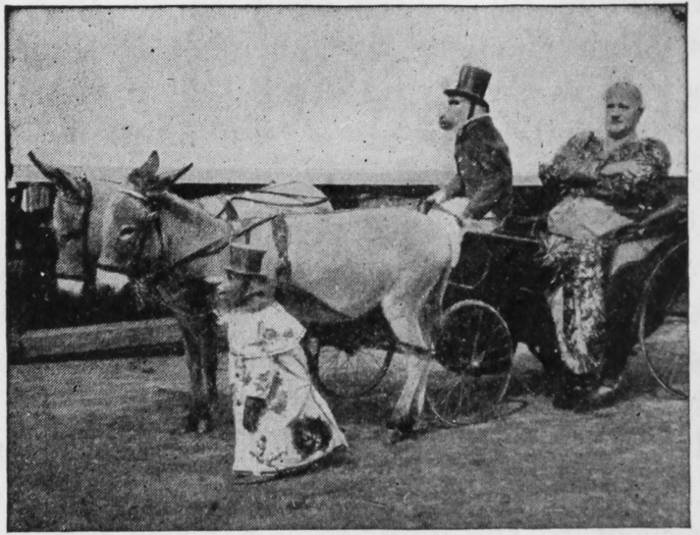
A Pair of Midget Donkeys Driven by a Baboon and Groomed by a Monkey
Any one who pays attention can be taught, whether boy, monkey, or dog. As long ago as 1753 this was shown in London in the case of the monkey and the dog. In that year everybody in London was going to see and was talking about "Mrs. Midnight's Animal Comedians." This was[259] a troupe of trained dogs and monkeys who were taught to dance a ballet, dressed as ladies and gentlemen. This they did very neatly and cleverly.
But their great act was when, dressed as soldiers, they took part in a mock battle. A fort was built on the stage which was defended by the monkeys and attacked by the dogs. Everything was done as in regular battle. The dogs carried ladders and tried to climb them and capture the fort. The monkeys, armed with muskets, fired on them and the air was full of smoke and the smell of powder.
After a hard fight the dogs took the fort. Then the monkeys dropped their muskets, the smoke cleared away, and both parties were seen drawn up side by side, waving their hats, while the band played "God save the king."
The stories we have given about monkeys are only a few of the many that might be told, and it is well to give some more to show that monkeys think and act, up to a certain limit, very much as we do ourselves.
But you must bear in mind that there are many kinds of monkeys, some with good and some with bad tempers and some with much better brains than others. When we talk of the house dog and cat, the horse and cow, it must be remembered[260] that each of these is a single species of animal. But when we talk of the monkey we have to do with a whole family of animals, of a great many different species.
Thus there are New World monkeys and Old World monkeys which differ so that we can always tell them apart. One curious thing about the New World monkeys is that they all live in trees and have long tails, which they can use in such a way that they seem to have five legs. They twist their tails firmly around the limbs of trees and swing about, leaving their legs, or arms, free to help them in other ways. There is nothing like this in the Old World monkeys. Some of these have no tails. Others have long tails, but none of them have learned how to use these as ropes to swing on from tree limbs.
All monkeys have thinking powers, which they show in various ways, but the best thinkers among them are those known as man-like monkeys. This is the meaning of the name we give them, that of Anthropoid Apes. They are the highest members of the monkey family, and are like men in a good many ways. They have no tails, are of large size, and can stand and walk upright if they want to—though they do not often want to.
Their arms are longer and their legs shorter than ours are, and they live much in trees, where they have to use both feet and hands in getting about. So, when they come down to the ground they also[261] use their arms to help them get about. They do not walk on four legs in the way of most other animals, nor on two legs in the way of men, but move in a jumping fashion, putting their hands to the ground and jumping through them. This looks like an awkward way of travelling, but they can get over the ground pretty fast, for all that.
A fact of much interest is that the bones, the muscles, and the blood-vessels of these animals are exactly like those of man, except in size. And the same may be said of their brains. These are smaller than a man's brain, but they are very much like it in all other ways. The weak point of these brains lies in their small size. They seem to think in the same way as we do, but they come to the end of their thinking powers when we are just past the beginning.
There are four different kinds of man-like apes, known as the Gorilla, the Orang Outang, the Chimpanzee, and the Gibbon. Of these the first two are large animals, the gorilla being larger and stronger than a man. It is a savage brute, too wild and fierce to be tamed, but this is not the case with the orang, which can easily be tamed and is very teachable.
These two are solitary creatures, living by themselves, but the chimpanzee, which is smaller, is very fond of company, and lives with its fellows in the woods, leaping about among the trees in a[262] very sportive fashion. The gibbons are much smaller than the others, but have very long arms. When they stand erect their hands nearly reach the ground and they may be seen at times walking in the same way as we do, but holding their arms above their heads. If disturbed in any way down come their arms and they run away in the same manner as the other apes.
The gibbons are gentle and easily tamed and have often been kept as pets. They are less intelligent than the others, and it is the chimpanzee and the orang which can best be taught man's ways when kept as man's companions. Many tales could be told of the smart doings of those tamed apes and it will be well to give a few of them.
Buffon, a famous French naturalist, tells us of a tame chimpanzee which always walked on its hind-legs, even when it had a heavy weight to carry. The chimpanzee does not do this in the woods, but this one was in company with man and learned to walk in the same way as man. Buffon goes on to say:
"I have seen this animal present its hand to conduct the company to the door or walk about with them through the room; I have seen it sit at table, unfold its napkin, wipe its lips, make use of a spoon or fork to carry its victuals to its mouth, pour out its drink into a glass, touch glasses when invited, go for its cup and saucer, carry them to[263] the table, pour out its tea, sweeten and leave it to cool, and all this without any other instigation than the signs or commands of its keeper and sometimes even of its own accord. It was gentle and inoffensive; it even approached you with a kind of respect and as if only seeking for caresses."
Captain Brown, the writer of a book on the habits of animals, tells us this interesting story of a trained chimpanzee:
"Madame Grandpré saw on board a vessel a female chimpanzee which showed wonderful proofs of intelligence. She had learned to heat the oven; she took great care not to let any of the coals fall out, which might have done mischief in the ship; and she was very accurate in observing when the oven was heated to the proper degree, of which she apprised the baker. With perfect confidence in her information, he carried his dough to the oven as soon as the chimpanzee came to fetch him.
"The animal performed all the duties of a sailor, spliced ropes, handled the sails, and assisted at unfurling them, and she was, in fact, looked upon by the sailors as one of themselves."
In the end of her life this animal showed what seemed a human feeling and sense of injustice. The first mate beat her cruelly for something in which she was not in fault and the ill-treatment seemed to break her tender heart. She bore the blows with patience, merely holding up her hands as if praying for mercy, but from that moment[264] she refused to take any food and on the fifth day she died from grief and hunger. The sailors would have liked, if they dared, to treat the mate in the same way he had treated the monkey.
It may be said that much of what has been told is the result of training and only shows that the monkey is easily taught. It does things, it is true, which no dog could be taught to do, but it has the advantage of having fingers and thumbs in place of the dog's paws, and also of having learned how to use these in its forest life in much the same way as we use them. A monkey, for instance, can use a stone as a hammer and some of them can throw stones with a very good aim. They can use other tools, as we shall show.
But there is one great difference between the monkeys and the other animals we have spoken of. Many of these can be taught to do things we would not expect of them, but they do not often teach themselves. Now the monkey does not wait to be taught but is constantly trying new tricks and working them out for itself. It is the most curious of animals, always wanting to know how things should be done, and thinking out for itself the right way to do them. We look with wonder on a dog when it does something that it has been taught. Should we not look with more wonder on the monkey when it does things which it has taught[265] itself? I am sure you will enjoy reading some stories in this line.

Reproduced by Permission of the Philadelphia Museums
The Orang Outang in the Hands of His Keeper
Here is one of a tame orang outang told by the French scientist Cuvier. This animal, he says, when it wanted to open the door of a room, used to draw a chair from one end of the room to the other, and stand on it to lift the latch. Another writer speaks of a monkey which, when it wanted to lift the lid of a chest too heavy for it, used a stick as a lever to raise it. That monkeys use stones to break open oyster-shells has often been seen.
Mr. Romanes tells the following story. A large monkey was kept in a wide cage, in the centre of which was a kind of hut in which he slept. Near this hut was an artificial tree, with a branch leading away from the hut. If he wanted to get on this branch he could do so by climbing to the top edge of the hut door. But this door had a bad fashion of swinging shut whenever he pushed it open to climb up. He was seen to try this two or three times, and then to pick up a thick blanket which lay in his cage and throw it over the top of the door so that it could not swing to.
In all these cases the animal thought out for itself the best way of gaining its end. These things were done by chimpanzees and orangs, apes of high class, but Mr. Romanes, in his book on "Animal Intelligence," tells of quite as strange things done by a South American monkey of which[267] such doings could not be expected. This he kept as a pet and watched for many days.
One thing his monkey never liked; that was to be laughed at; any one that did so would be apt to be repaid for his mirth. Mr. Romanes gave him a hammer to break his nuts with, and from the start he knew just how to use it.
"To-day," says Romanes, "a strange person (a dressmaker) came into the room where he is tied up and I gave him a walnut that she might see him break it with his hammer. The nut was a bad one and the woman laughed at his disappointed face. He then became very angry and threw at her everything he could lay hands on; first the nut, then the hammer, then a coffee pot which he seized out of the grate, and lastly all his own shawls. He throws things with great precision by holding them in both hands, and extending his long arms well back over his head before projecting the missile, standing erect the while."
Every day this little fellow did something new and unlooked for, something worked out in his own little brain. When a nut or anything he wanted lay too far away for him to reach it, he being fastened by a chain, he would try to draw it to him with a stick. If he failed in this, he would take his shawl by the two corners, throwing it back over his head and then flinging it forward with all his strength, but not letting go the corners. If it reached far enough to cover the nut, he would[268] draw this in by pulling back the shawl. This is like the story of the elephant that used its trunk to make a wind beyond anything out of its reach, and thus blow it back.
His chain was a constant trouble to him and he tried in every way he could to get rid of it. When it was tied to a ring sunk into the floor, he spent a whole day passing the chain back and forward through the ring, and hammering it with all his strength. He went at it again the next day and this time got the chain so tangled up that he could not loosen it. When his master came to his aid he watched him very closely, sometimes taking hold of his fingers and pulling them to one side that he might see better. He would also look up into his master's face in an intelligent way as if to ask him how he did it. After the chain was loosened he worked at it again for hours, but took care not to twist it into the ring a second time.
Among the many things done by this comical little creature there were two which showed so much monkey wisdom as to be worth telling. His nuts were kept in a trunk which he looked upon as his own property. There were other things kept in the trunk, but if any person opened it to get anything out he grew very angry. It was not on account of the nuts, for he always had plenty of these, but for meddling with his property.
One day, when his chain was broken, he got to the trunk and began picking at the lock with his[269] fingers. His master then gave him the key and for two full hours he tried to unlock the trunk. It was a hard lock to open, being a little out of order, but he found the right way to put the key in and turn it in the lock, every time trying the lid to see if it would come up. Of course, he had seen others use the key and knew how it should be used.
The most remarkable thing done by our smart little friend was the following: One day he got hold of a hearth-brush, one of the kind which has the handle screwed into the brush. In his usual fondness for experiment he at once began on the handle, and soon had it unscrewed and out of the brush. Then he began to try and find the way to screw it in again.
At first he put the wrong end of the handle into the hole and turned it round and round, always the right way for screwing. Then he tried the other end, still always turning only the right way. How he knew the way the screw should turn is a mystery. The work was a hard one, for he had to use both hands on the handle, and the brush, with its bristles, would not lie still. Next he tried holding it with his foot, and even then it was not easy to get the first turn of the screw to take hold. When this was done he turned the handle round and round until it was fully screwed in.
The strange thing was that, in all his efforts, he never tried to turn the handle the wrong way; he always screwed from right to left. The work[270] done, he unscrewed it and screwed it in again, this time more easily. He kept on until he could do it without trouble and then threw it aside for some other amusement.
Here is a case where the animal tried for himself a thing he had never seen done, not for anything to be gained, but simply to find out how to do it. He knew somehow the right from the wrong way, and when he had finished he had no further use for the brush. He had learned that lesson, solved that riddle, and was ready to try something else.
While men like to have the monkey for a pet, the monkey imitates them by having pets of its own. It has a fancy for this and likes to have something or some animal under its care. It may be a doll, a guinea pig, a white rat, or anything to which it takes a fancy. This was the case with a monkey we are told of, which was very fond of nursing.
His fancy in this way brought him to a sad end. Seeing a litter of young pigs, he grew eager to have one of these for a pet. Watching till the mother pig was at the other end of the pen he popped down and seized one of the little grunters. With his prize he leaped to the door of the pig-stye, but it gave way under his weight and he fell back into the jaws of the furious sow, who with one crunch put an end to the pet-lover's career.
Here is another story told by the same party: "A female baboon which I brought up in my family got hold of a kitten with the intention of making a pet of it and mothering it, but was scratched by the scared fondling. The monkey then made a close study of the kitten's paws, pressed the claws forward, looked at them from above, from beneath, and from the side, and then bit them off to save itself from further scratches."
This love of pets on one occasion led to a serious scene. It was in the case of a large baboon kept on a ship on which was a lady passenger with a baby. Not noticing that the baboon had its eye on the little one, the mother laid it down on a bench to look at something which the captain wanted to show her.
In a moment the big monkey had the child in its arms and was running for the rigging, hastened by the mother's scream on seeing the fate of her little one.
Clasping the baby with one arm, the nimble creature ran up to the mast head with the aid of the other, and when the sailors started after it ran to the head of the top mast. By this time the poor mother was being carried to the cabin in a dead faint.
What to do the captain did not know. He called the sailors down, fearing that if they chased the brute it might throw the child into the sea. But when it saw that they had given up the pur[272]suit it set itself to quiet the screaming child, fondling and talking to it in a very motherly way.
The baby by this time was in a terrible state, and the captain, at his wits' end, at length ordered everybody on deck to go below, thinking the monkey might come down if the coast were clear. The plan proved a good one. On seeing that there was no one on deck, the animal descended with its prize and laid it on the bench from which it had been taken. It was soon in its mother's arms and the pet-loving baboon found itself locked up as a punishment for its trick.
Monkeys are often kept on ship board and they are not to be trusted if there is anything they can steal. There were two of them on a British naval ship in the West Indies, a big and a little one, both great favorites. Dressed in uniform, they would march up and down the deck, salute the captain, and imitate the movements of the officer of the watch. But both were thieves, the big one stealing, the little one hiding, and they needed watching.
One day the captain's gold snuff-box was missing. It was known that the monkeys had stolen it, for both of them were taken with a severe fit of sneezing. But no one could find it, until the little one was seen peeping into a middy's chest. Searching this, the box was found below the clothing.
Another theft was made while the ship was at anchor in Kingston harbor, Jamaica. This time it was a bottle of wine, which the big one emptied[273] without leaving a drop for his pal, who sat and looked at him as if he had been very badly treated.
In a few minutes the big thief was reeling about the deck very drunk. He jumped on the bulwarks, and seeing a shark swimming around the ship began a great jabbering and at last jumped overboard, perhaps with some idea of making a pet of the big fish. One snap of the huge jaws and the drunken monkey was no more.
The little one saw this with screams of agony. He could not be consoled for the loss of his mate, and the next day he, too, jumped overboard and was soon in the same place as his dead friend.
What has been said above goes to show that the monkey can think and that it comes next to man in doing its own thinking. It goes to school, no doubt, as boys and girls go to school, but it teaches itself also, as may be seen in the story of the monkey and the brush-handle. But the monkey can not only think, it can also feel, and when we tell of some of its shows of feeling it almost seems as if we were talking about people like ourselves.
Here is a story that has been often told, but is worth telling again. A man in India had shot a female monkey and carried it to his tent. A crowd of friends of the dead animal, forty or fifty of them, soon gathered round the tent, making[274] a great noise and acting as if they were about to make an attack on the sportsman. Only when he came out gun in hand did they run away, as if they well knew the powers of that dreadful weapon.
But the leader of the band stood his ground, chattering away in monkey language. When he found that his fury and his threats did no good, he came to the tent door and began to moan in a sorrowful manner and to make signs as if to beg for the dead body. When it was given to him he took it in his arms and carried it away to his waiting friends. All those who saw this sad scene vowed that they would never again fire at one of the monkey race.
This interesting story is only one among many. One of them has to do with an instance where the horses of a party of travellers were frightened by monkeys in the trees, some of the horses breaking loose. To stop this one of the party fired at the monkeys with a load of small shot to drive them away. One of the monkeys ran down to the lowest branch of the tree, then stopped, put his paw to the part wounded, and held it out covered with blood for the man to see. The sportsman says: "I was so much hurt at the time that it left an impression never to be effaced and I have never since fired a gun at any of the tribe."
A few minutes later a native came in and said that the monkey was dead. They told him to[275] bring it in, but when he went back he found that the other monkeys had carried off their dead comrade and none of them were to be seen.
Here is a case of the same kind, told by Sir William Hoste, an officer in India. It is of a still more affecting kind. We give it as told by a Mr. Jesse.
"One of his officers, coming home after a long day's shooting, saw a female monkey running along the rocks, with her young one in her arms. He immediately fired and the animal fell. On his coming up, she grasped her little one close to her breast, and with her other hand pointed to the wound which the ball had made, and which had entered above her breast. Dipping her finger in the blood, and then holding it up, she seemed to reproach him with being the cause of her death, and in consequence that of the young one, to which she frequently pointed."
When Sir William was told this affecting story he, as in the other cases cited, resolved never to shoot one of these animals as long as he lived.
Is not all this very human-like? The poor things, knowing that men are stronger than they and carry death-dealing weapons, do all they can to make them sorry for their cruelty and accuse them of murder. If they could talk they could not say more than these monkeys did in dumb show.
Monkeys are very fond of and tender to their young. One writer saw an American monkey driving away the flies that troubled her infant,[276] and another saw a mother monkey washing the faces of her young ones in a stream. When their young die the mothers are very apt to die of grief. This we are told by Darwin, who further says: "Orphan monkeys are always adopted and carefully guarded by the other monkeys, both male and female."
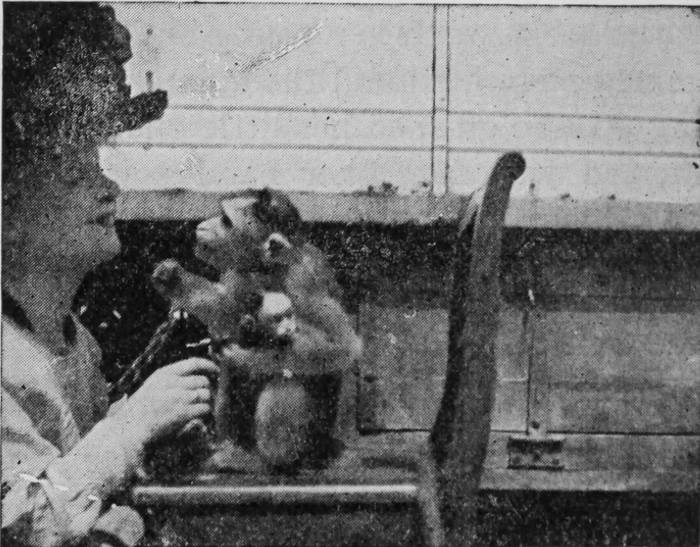
An afternoon chat. Observe the close attention of the monkey and its care of its young
They also take care of those that are hurt. One writer tells us that he kept a number of Gibbons in his garden, living in the trees and coming down to be fed. One of them fell from a tree and sadly hurt its wrist. The others at once paid it great attention, and an old female, who was no relation to the crippled animal, fed it every day before eating any food herself. The writer goes on to[277] say: "I have frequently noticed that a cry of fright, pain, or distress from one would bring all the others at once to the complainer, and they would then condole with him and fold him in their arms."
Captain Hugh Crow, in his "Narrative of my Life," tells a story of this kind which goes to show how tender the monkeys are to one another. On board his ship were a number of monkeys, of different kinds and sizes, among them a beautiful little one, only about ten inches long and no larger in body than a common drinking glass.
It was a playful little thing and a great favorite with the other monkeys, who looked on it as the pet of the family, treating it with a kindly feeling which they did not often show for one another. It became sick at length, of a disease that prevailed in the ship, and then their kindness and tenderness were doubled. He says:
"It was truly affecting and interesting to see with what anxiety and tenderness they tended and nursed the little creature. A struggle often ensued among them for priority in these offices of affection, and some would steal one thing and some another which they would carry to it untasted, however tempting it might be to their own palates. Then they would take it up gently in their fore-paws, hug it to their breasts, and cry over it as a fond mother would over her suffering child.
"The little creature seemed sensible of their kind attention, but it was sadly overcome by sickness. It would sometimes come to me and look me pitifully in the face and moan and cry like an infant, as if it besought me to give it relief; and we did everything we could think of to restore it to health; but in spite of the united attention of its kindred tribes and ourselves the interesting little creature did not survive long."
Sir James Malcolm tells us of two monkeys on shipboard, one older and larger than the other. They were not related, but merely friends, but were very fond of each other. One day the small monkey fell overboard. The older one was in a great excitement. It ran to the part of the ship which is called "the bend," held on to the side of the vessel with one hand, and dropped down to the other the end of a cord with which it had been tied up and which was fastened round its waist. Every one looked on with surprise at this display of monkey wit, but the cord was too short and the little one swept by. It is pleasant, however, to be able to say that it was saved by a sailor, who threw it a longer rope, which it seized and was drawn on board.
The monkey becomes as fond of its human friends as it is of those of its own race. Often it does not like certain people, and has its own way of showing this, but there are others whom it seems to love warmly. This faculty does not[279] belong only to monkeys, but may be seen in dogs and other animals. But it is often strongly shown by the monkey.
Darwin tells of a keeper in the London Zoölogical Garden, who one day was attacked by a savage baboon. In the cage was a little American monkey, a great friend of the keeper, but very much afraid of the great baboon. But when the poor little thing saw its friend in peril it sprang at once to the rescue and by screams and bites so distracted the baboon that the keeper was able to escape. The little monkey quite forgot its fear of the fierce beast when it saw its friend in danger.
We rarely think what depth of feeling such an animal as the monkey may have. There are cases in which none of ourselves could show greater feeling. Here is a case in point.
On board a war-vessel that was going to Persia was a pet monkey of the captain, a gentle, kindly little creature that was made much of by every one on the ship. But like all of its kind it was not free from love of mischief. There was a goat kept on board to supply milk for the use of a government official on the ship. One morning it was found that the monkey had tied the goat to the tackle of a gun and milked it into the stiff hat of a marine.
The little culprit was caught in the act and taken to the captain, who to punish it gave orders that no one on board should take notice of it for[280] a week. The loving little thing did not know what to make of this. It went about from friend to friend, looking up to them wistfully, but not getting a word or a kind look from any of them. It put on its most coaxing airs, but all in vain. For two days it bore this, but on the morning of the third, finding that it was still in disgrace, its tender heart was quite broken. It sprang on the bulwarks, put its hands over its head, gave one pitiful cry and leaped into the sea. It was seen no more.
To be fond of mischief and of playing jokes is a common trait in monkeys as it is in boys. This likeness is shown by the tricks of boys being called "Monkey tricks." Perhaps they would not play them if they knew that they were putting themselves on the level of the monkey. Stories of this tendency are common enough. Here is one told of a young chimpanzee who bore the familiar name of Tommy, and who lived in a cage in the Zoölogical Garden of London.
Master Tommy did not at all approve of tricks that were played upon himself, though he was very fond of playing them on others. Thus one day when a carpenter had to enter his cage to make some changes the little joker was in his element. He played all kinds of tricks on the workman, such as pulling his hair, snatching off his paper cap, stealing his tools, and even trying to trip him up. All the time he put on an air of innocence[281] and only came up when he thought he was not seen. The moment the joke was played he retreated to the other end of the cage, where he seemed very much interested in something else.
In the end, when the carpenter had his back to him, Master Tommy could not resist the temptation, but sprang on the man's shoulders and gave him such a sound box on the ears that the keeper, who had been enjoying the fun, had to interfere and make the little rascal behave himself.
On another occasion Tommy in some way got a small dog into his cage, and had the time of his life with the little victim. He pulled its ears and tail till the dog lost its temper and began to show its teeth. At this Master Tommy pretended to be very indignant, and lifted his hand in a threatening way, as if to chastise doggie for his impudence. He would do the same with children if he got a chance, pulling their hair or clothes or scratching them.
In fact, he was a little imp of mischief, yet had been taught to be very neat and nice in his habits, to pick his teeth, clean his nails, and do other acts supposed to belong to the human race. Like man also he could walk erect, jump on his hind feet and dance in the stamping fashion of a child a few years old, though with greater force.
We must close our stories of monkey wit and wisdom with one that comes from South Africa, of a monkey that acted as signal man on a rail[282]road. This is the story, as told in Chambers' Journal.
"We had a remarkably intelligent baboon here a few years ago. He was a giant of his species. His master and trainer had the misfortune to have both his legs cut off in a railway accident, and on his leaving the hospital the Cape government gave him a berth as signal man. He taught this baboon not only to work the signals, but to place the wheels of a little trolley on the line, and then the bed on the wheels. His master would then seat himself on the trolley and Jocko would push him along to his house, about two hundred yards down the line. He would then detach the pieces of the trolley and clear them off the line. He would also lock the door of the signal-box and take the key to his master."

We have now gone far and near among the animals kept by man, have seen them at work and at play, on farm and on road, in doors and out of doors, some helping him, some amusing him, some supplying him with food and clothes. But so far we have kept among the animals of common use. There are others not so often kept and at some of these we must take a passing glance before we finish our journey.
Man, you know, is only one among many thousands of kinds of animals which dwell upon the earth. These are found everywhere, from the hot equator almost to the frozen poles. The most of them, of course, live in warm regions, but away up in the seas of ice may be seen creatures clad in thick wool and fur and finding food under the snows. So there is hardly any part of the earth without its living beings.
Some of these animals are so savage that man rarely tries to tame them. The fierce lion and tiger, the ferocious grizzly bear, the huge and stupid rhinoceros, and many others of the same[284] wild sort are shown us at times in menageries. But we look at them through the iron bars of their cages. If any of them should get out of the cage we would hasten to get out of the show.
Even these fierce animals at times grow tame enough for men and women to go into their cages and teach them some simple tricks. But they are never safe to deal with, and we are always glad to see the tamers of lions and other wild beasts come out of the cages alive.
It is not such creatures as these that man makes use of. He has picked out those of gentle nature, the grass eaters, not the flesh eaters. The dog and cat, it is true, are flesh eaters, but the dog is an animal that is easily tamed and becomes one of man's best friends. As for the cat, it rarely becomes quite tame. Its wildwood ways cling to it still.
Animals fitted for man's use are found in all parts of the earth, but the tame ones mostly came from Europe and Asia, the countries in which civilization first began. Here are the native places of the horse and the cow, the sheep, goat and pig, the hen, duck and goose, and nearly all the other animals found about our homes.
There is no continent with a greater variety of animals than Africa, but few of these have been tamed, and this mostly in the civilized north, for the people of that continent have long been in a savage or barbarian state, and have been hunters[285] instead of tamers of animals. It has been the same in America. When white men came here they brought their home animals with them and there was no need to tame those found in this new continent. The only ones tamed by the Indians were the dog and the Peruvian llama, and nearly the only one added by the white man has been the turkey. The rest of our animals, like our forefathers themselves, came from abroad.
Though we have dealt with the chief animals kept by man, for use or as pets, there are many others which have been at times tamed and made into friends and comrades, and it may be well to speak of such of these as seem of most interest.
Men and women have a natural love for pets and sometimes pick out very odd ones. You know what the flea is—or if you do not know it is all the better, for the flea's way of making itself known is by biting. Yet even these small pests have been taught to do things, such as being harnessed to little carriages, which they drag about in a way to please those who are near enough to see them.
A strong little insect is the flea. It can leap, we are told, two hundred times its length, while few of us can jump twice our length. And it can pull a heavy weight for a creature of its size. But it is not tamed nor taught. It is simply tied fast and pulls to get loose, and in this way draws its carriage. So to talk about learned fleas is to talk[286] nonsense and most of us would be satisfied if there were no such thing as a flea.
There are other insects which man has at times taken under his care, the ant, for instance, and some others. But these also are not tamed, they are simply studied and made use of in various ways. When we talk of taming animals we must come to those of a higher order, such as the birds and the four-footed creatures. We speak at times of the fish being tamed, but this is only from its losing its fear of man and taking food from his hands. It has not brain power enough for much more than this.
Yet man at times makes a pet of the fish, which he keeps in the little table pond called the aquarium as he keeps his bird pets in the cage, and of these fish pets a few words may be said.
The aquarium is a very pretty piece of furniture for the lovers of animal life, for a variety of water-living things can be kept in it alike for study and pleasure. Plants are needed of various kinds, to give beauty to the collection and keep the water in a fit state for the fish, for animal life and plant life need to go together. The plant gives off oxygen for the fish to breathe.
There are a number of other small animals kept in the aquarium, such as the tadpole, the water-beetle and several kinds of fresh-water snails.[287] But it is the fish that gives life and action to the parlor pond. Swimming in its little lake, now up, now down, darting nimbly about, with its bright scales glistening in the sun, it is always a pretty and attractive object.
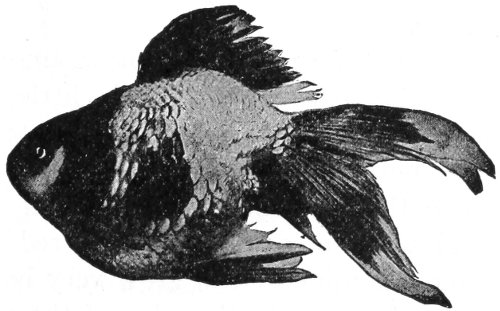
From D. M. Smith's Japanese Gold Fish
The Fantail. The Japanese have had wonderful success in changing the form of the gold fish
A favorite among all cage-fish, if I may so call the pets of the aquarium, is the gold fish, with its bright golden scales, flashing as it darts about. This fish is of Chinese origin and belongs to the carp family. It is apt to vary, not only in color but in its fins and tail, the fins being sometimes double and the tails at times triple. Some of them change till they look very odd, and have long, wide, lace-like tails, strange but pretty. Some of the gold fish lose their color and grow white and are then known as silver fish.
The common carp is not as handsome as its cousin, the gold fish, and is apt to grow too large[288] for the aquarium. Those who choose to keep it may have it all their lives and leave it to those who follow, for it is said to live from one hundred to two hundred years.
There are many other fish well fitted for the aquarium, such as the gudgeon, the roach, the tench, and the perch. But the perch can be kept only while young and small, as it is a fish eater and has an appetite that will soon leave it few of the other fish for company.
One must not forget the minnow among the dwellers in the glass house. This little, lively fellow is well fitted to live in close quarters and no fish does better in the home fish-pond. It is a pretty little thing, with olive back and silvery belly, which sometimes becomes bright red. After a little time the minnow will grow very bold and tame enough to come to the edge of the tank at the sound of a familiar voice and take its morsel of food from between the thumb and finger.
Among the fish kept in the aquarium must be named the stickleback, the nest-builder of the fish tribe. This little fish resembles the bird in building a nest, laying its eggs in it, and watching them with great care until they are hatched out. The stickleback is a pretty little fellow, but, like the perch, not safe to keep among other small fish, as he has the bad habit of feeding on them, so that he soon has the aquarium to himself.
Dr. Lankaster says of him: "He has all the[289] ways of other fishes and many others besides. Look into your tank; see, there is one larger than the rest; he is clothed in a coat of mail like a knight of old, and it is resplendent with purple and gold. He is a male fish and the king of your little shoal. He has important offices to perform. In the course of a few days, if you watch him and are fortunate, you will see this wonderful little fish engaged, in the most useful manner, in building a nest.
"He seizes hold of one little bit of weed, then of another, and carries them all to some safe corner, till at last his nest is built. Having done this, he gently allures his mate to their new-made home. Here she deposits her eggs, and having done this resigns the care of them to our hero of the purple and gold, who watches over them with an anxiety that no male in creation but the male stickleback seems to know. He fans and freshens the water with his fins, and at last, when the young are hatched, watches over their attempts at swimming with the greatest anxiety."
From the fish let us turn to the snake, a gliding creature without limbs and without joints. It is much like one of the fishes, the eel, in shape, but not in anything else, while no other animal is so much feared and hated by man. We hate this creeping reptile from the fact that a few species[290] of snakes carry a deadly poison in their teeth, and the strongest of men, bitten by one of these, has often only a few minutes to live.
It is this that makes man a bitter foe of the snake and quick to kill any one he sees, whether it has a poisoned tooth or not. He fears it and hates it and has made up his mind that he and the snake are not fit to live together on the same earth.
This is not fair to the snakes, for only a few of them are poison bearers. Most of them are as harmless as rabbits and can be handled as safely. But the cry of "a snake" is almost as bad as the cry of "a mad dog," and even so gentle a little thing as the garter snake has usually a short lease of life if seen by man or boy.
Not quite everybody has this foolish fear of all snakes, the good and the bad alike, for there are some who make pets of them. And snakes thus petted become very tame and grow fond of those who take care of them. This is the case even with the huge python and the boa-constrictor, the greatest of all snakes. They are not poisonous, but when they wind their body in strong coils around an animal, even one of good size, they can soon crush the life out of it.
Many stories might be given of tame snakes and it may be well to quote one of these as told by Mr. Romanes in his "Animal Intelligence." He had it from Mr. Severn, an artist, who tells[291] of a call he made on a Mr. and Mrs. Mann, two snake-lovers who were much blamed by their neighbors for keeping these crawling creatures.
When Mr. Severn called he was asked by Mr. Mann if he was afraid of snakes. He said, in a timid way, "No, not very," and his host took out of a cupboard a large boa-constrictor, a python, and a number of small snakes, which at once made themselves at home on the writing table among pens, ink and books.
Mr. Severn's eyes opened very wide when he saw the two big snakes looking at him with their bright eyes and thrusting out their forked tongues, and they opened wider still when he saw the great serpents coil round and round the body of his friend. But when he found that they were very tame and would do no harm he lost his sense of fright.
After some time Mr. Mann went out to call his wife, leaving the boa on an arm chair. The other snakes were put away. The visitor now began to feel rather queer, the more so when he saw the great serpent creeping slowly towards him. He was glad enough when Mr. and Mrs. Mann came in, bringing their two children. The lady and the children went at once to the boa, called it by loving names, and let it twine itself around them. We give the rest in Mr. Severn's own words:
"I sat talking for a long time, lost in wonder at the picture before me. Two beautiful little girls with their charming mother sat before me[292] with a boa-constrictor (as thick round as a small tree) twining playfully round the lady's waist and neck and forming a kind of turban round her head, expecting to be petted and made much of like a kitten. The children over and over again took its head in their hands and kissed its mouth, pushing aside its forked tongue in doing so.
"The animal seemed much pleased, but kept turning its head towards me with a curious gaze, until I allowed it to nestle its head for a moment up my sleeve. Nothing could be prettier than to see this splendid serpent coiled all around Mrs. Mann while she moved about the room and when she stood to pour out our coffee. He seemed to adjust his weight so nicely, and every coil with its beautiful marking was relieved by the black velvet dress of the lady.... The snakes seemed very obedient, and remained in the cupboard when told to do so.
"About a year ago Mr. and Mrs. Mann were away for six weeks and left the boa in charge of a keeper at the Zoo. The poor reptile moped, slept, and refused to be comforted, but when his master and mistress appeared he sprang upon them with delight, coiling himself around them, and showing every symptom of intense delight."
Is not this a pretty story of snake taming! Others might be told, for these animals, like others, learn to know and love those who care for them and treat them well.
Would you like to know something more about these great snakes? Many stories are told of them, but the trouble is that these are not all true. Thus we are told of pythons forty feet long and able to kill and swallow a goat or antelope, horns and all. The fact is, that they are never seen more than twenty feet long, usually little more than ten. And though they can kill a goat or antelope, they cannot swallow any animal larger than a small dog.
The python and the boa-constrictor are much alike, but they do not live in the same countries, the python dwelling in the Old World and the boa in the New World. They lurk near water, hiding in the bushes or in the trees, where they are ready to seize small animals that come to drink. These they slowly swallow. Winding their tails around the limb of a tree, they can hang down and seize any animal passing beneath.
But it was not these big snakes, but the doings of the snake charmers, I set out to talk about and to this I must return. We hear of snakes being charmed as we hear of forty foot pythons, but the fact is that there seems to be no charming of the snake at all. When the snake goes through what is called "dancing" one would suppose it had been trained. We know that this is not the case from the fact that the moment a snake has been captured a snake-charmer is able to make it "dance."
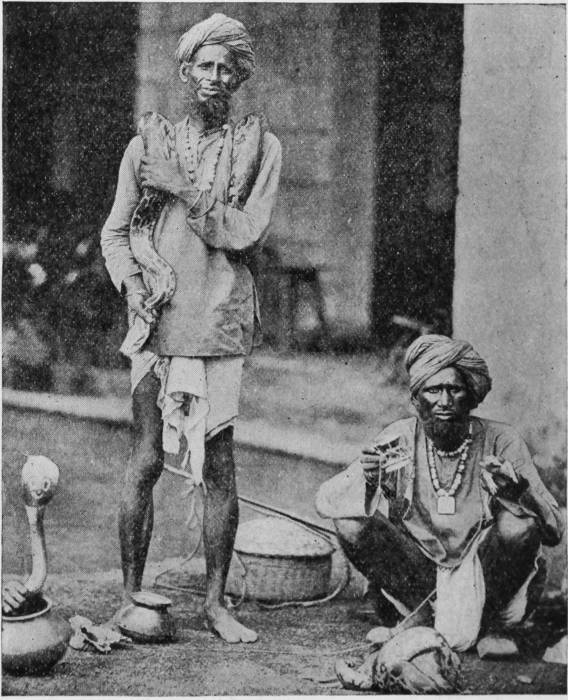
Reproduced by Permission of the Philadelphia Museum
Hindu Snake Charmers with the Deadly Cobras
What is called the snake dance is a natural habit of the cobra, which raises its head and one[294]-third of its body above the ground and sways about in the air while the charmer is playing on his pipe. The cobra has poor sight and poor hearing and certainly no ear for music. What it lifts itself in this way for is a chance to strike its[295] enemy. It can strike only with the part of its body that is lifted up and this the charmer knows and can easily keep out of reach.
The cobra is a very deadly serpent. It kills thousands of persons every year in India with its fatal bite. Yet it can be tamed and taught to make itself at home. It can even be made to take the part of a house dog. At any rate Major Skinner, an English officer in India, tells us this snake tale:
"In one family near Negombo cobras are kept as protectors in the place of dogs, by a wealthy man who has always large sums of money in his house, and this is not a solitary case of the kind.... The snakes glide about the house, a terror to the thieves, but never attempting to harm the inmates."
So it seems that even the deadly cobra is not as black as it is painted, but can be tamed and made a friend of by man. When the snake-charmer wants a new snake he plays on his pipe near places in which serpents are apt to hide, and the cobra and other snakes come out and are caught. Sometimes the poison fangs are drawn out of the snake's jaws, but often they are not, the charmers knowing how to avoid being bitten. If bitten, they know how to take care of a bite.
Here is a story told by a Mr. Reyne, who tried to learn the truth about the snake charmers. He made one of these men go with him into the[296] jungle, after finding that he had no snakes hidden under his clothes. As these Hindus wear very little clothing, this was easy to do.
In the jungle was a tall ant-hill in which Mr. Reyne knew that a large cobra made its home. Here the man played his pipe, and soon the cobra came gliding out, as if charmed by the music. Mr. Reyne goes on to say:
"On seeing the man it tried to escape, but he caught it by the tail and kept swinging it around until we reached the bungalow. He then made it dance, but before long it bit him above the knee. He at once bandaged the leg above the bite and applied a snake-stone to the wound to draw out the poison. He was in great pain for a few minutes but after that it gradually went away, the stone falling off just before he was relieved."
Thus it may be seen that a snake can be made to dance the instant it is caught and before it can have any lessons in dancing. The dancing is only a movement made by the serpent when it is alarmed and rises to defend itself.
As for the taming of snakes, it is not very hard to do. The snakes must get used to the sight of man by seeing them often, as when kept in a cage where people pass or stop to look in. And when thus used to see man, they may be handled freely at all times except just after a meal. But those who handle them must be careful not to touch their necks or tails, for these are tender parts of the[297] snake. Thus treated, they soon grow tame. Of course, some are much more savage than others, and any one who wants to own a tame snake had better leave the poisonous kinds alone.
As I have now told the story of the snake, it is well to give a little time to one of the snake's chief enemies, the little weasel-like animal known in Egypt as the Ichneumon and in India as the Mongoose. Larger than a cat, but with a long, slender body, and very quick in its movements, the ichneumon is death to snakes. I cannot say that it is proof against the snake's bite, but it jumps about in so lively a way that the snake gets no chance to bite it, and when it once gets its teeth in the snake's hide it soon puts an end to his career.
This little animal is also death to crocodiles. But you must not think that it deals with the crocodile as it does with the snake. The fact is that it is very fond of the crocodile's eggs, and by digging these out of the sand and eating them it is of much use in cutting down the crocodile crop.
It is easily tamed and becomes a house pet, doing much to keep the house free from rats and mice. Its worst fault is that it loves poultry and is hard to keep out of the chicken coop. The ichneumon has a pretty fashion of squatting down and eating out of its fore-paws like a squirrel.[298] When it sleeps it coils up into a round ball, with its head and tail under its belly.
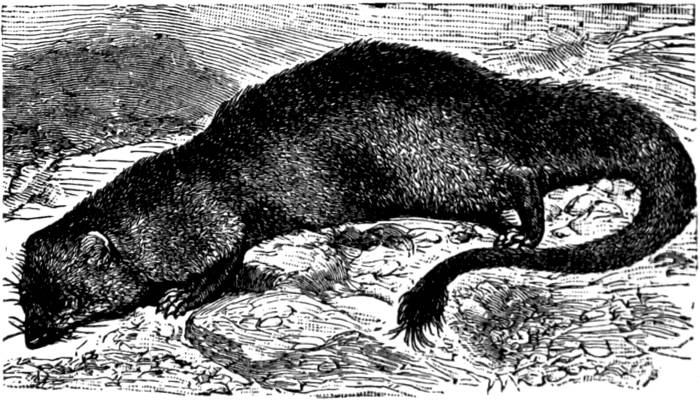
The Mongoose. The Deadly Foe of Snakes and Rats
The mongoose is a little smaller than the ichneumon, but it is like it in other ways. Not many years ago some of these animals were brought to the island of Jamaica, where rats in the sugar-cane fields were giving the planters a great deal of trouble by gnawing the cane. For a time all went well. The mongoose went for the rats and soon these gnawers grew very few. The planters thought they had done a good thing in the way of saving their sugar-cane.
In time the mongoose was to be seen everywhere and hardly any rats were left. Then the hungry little strangers had to look for food elsewhere and found it in the poultry-yard. The chickens began to follow the rats. Nowadays the planters look on the mongoose as a worse pest even than the rat and would like very much[299] to get rid of their late friend, who makes it very hard to keep chickens and any kind of poultry. They would be glad to find some animal that would serve the mongoose as the mongoose served the rat.
A very tamable little creature is the mongoose, and a very active one also, for it is never still for a minute except when asleep. It is not always hungry, like some other tame animals, but soon gets enough food. But when it does want something to eat it wants it badly and will walk around on its hind legs in man-like fashion after its keeper, and climb up his body till he gives it the food and drink it needs.
The mongoose always wants to know. He must have his nose in everything he sees. He is all the time looking for something new. He would make a good scholar if sent to school. We are told of one that had his doll, his pet rabbit, his toy monkey, all stuffed, and these he played with till the stuffing all came out. If they were stuffed again he would go back to his play. One day he was given a Japanese paper snake and he went for that snake as if it was a live one. First he bit it in two. Then he bit the halves into quarters. Before he let the snake go there was not a piece left big enough for a bite. The little chap knew somehow that he was a born snake killer.
When he could find nothing else to do he would climb into the window and view with delight all that went on outside, the cat, the dog, the horse,[300] the milkman, everything. A game of tennis would hold him quiet for hours, for he was fond of ball play himself and very good at it. When he could find nothing to do or to see he would wander about like a lost lamb, and as a last resort would coil up in his master's lap and go to sleep.
He had no fancy for being locked up in a cage, as had to be done at times, and he let people know this. If a friend of his came into the room where he was caged he would begin to cry like a cat, his voice growing loud and shrill if no notice was taken of him. In a minute more he would be flying around the cage in a fury, tearing up his bedding and flinging it to all quarters. If this had no effect his voice would sink into a wail of despair which it was hard to resist.
But the instant he was taken out all his rage and grief were at an end. He would cuddle up in his master's arms, lay his head lovingly on his cheek and coo and crow away in deep delight.
Leaving the mongoose, we may take a look in upon some other four-footed creatures that make good pets. Among these are such as the chameleon, the odd lizard that has the power to take on a new color whenever it gets tired of the old one; the armadillo, which wears a coat of mail and can roll itself up into a ball that no teeth can bite into; the hedgehog, another little creature that rolls up into a ball with sharp spines sticking out on all sides; the porcupine, that does the same thing[301] and has much longer spines; in fact, almost all kinds of small animals, even those we call house vermin, the rat and the mouse.
We might fancy that pet-lovers would draw a line at rats and mice, but these have often been tamed, at least the white rat and mouse, which some people like for their color. The rat makes a better pet than the mouse, for it is very quick-witted, while the mouse is apt to be dull. Among animal stories there is one we are told about a white rat that seems worth telling.
The owner of this rat found it to be clean, loving and very lively. Like all rats it had the habit of laying up a store of food for future use, and when it found a supply would never stop till it had carried it all away. It was funny to watch it. If a plate of biscuits was put upon the table with no one near by, it would carry them away, one at a time, till not a biscuit was left. They would all be taken to its nesting place, across the room, and laid away for future use.
If it got hold of a hunk of bread too heavy to carry up to its elevated nest, this did not stop its work. It would sit on the floor and gnaw the bread into small bits, carrying those up one at a time. It was fond of warming itself before a coal fire, and seemed to take the fancy that coal was a good thing to have, for it carried it off a piece at a time till it had a store of this hard stuff a foot wide and five or six inches deep.
Very likely many of you have read about how rats will carry off eggs, even taking them down stairs without an egg being broken. It takes two rats to do this, one passing the egg down to the other on the step below. They have even been seen to take eggs up stairs. One rat catches the egg between its fore-paws and its head, and gets up on its hind legs, passing it up to the other, who catches it in its fore-paws. Then they go up another step and keep at this till the top is reached. They are very fond of oil, and when they find bottles of oil have a cute way of their own to get it. First gnawing off the cover, the rat sticks its tail down into the oil, pulls it up well covered, and licks off the oil. Sometimes they take turns, each handing down its tail for another rat to lick. You may see from this that the rat is a very wide-awake little nuisance.
The tame rat we have been speaking of died in good time and a hedgehog became his master's next pet. Have you ever seen a hedgehog? Some of you have, no doubt; but for those who have not I would say that it is a little creature that lives in a hole in the ground or in trees or rocks and comes out at night to feed on mice, frogs, insects and such like prey.
The hedgehog is about a foot long and six inches high, with small black eyes and sharp-pointed head. The odd thing about it is the fact that where most animals are covered with hair this[303] one is covered with spines, hard and sharp, like little thorns. These grow to be about an inch long and there are muscles in the back that cause them to stand up and stick out in all directions.
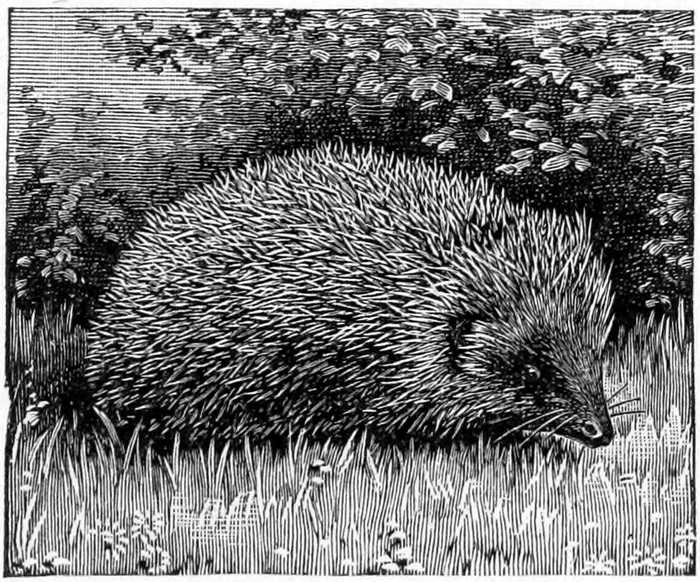
The Common Hedgehog with his Battery of Spines
When a dog gets busy about a hedgehog, it does not try to run away. All it does is to roll itself up into a ball, its head and tail meeting over its lower parts and its spines sticking up all around. When the dog gets these into his nose a few times he is apt to lose his taste for hedgehog meat. He may roll the animal about with his paws, but that does no good, and he soon goes away with sore head and paws, leaving the hedgehog to unroll and make its way back to its burrow.
When taken home and fed it soon becomes very tame and friendly. It can be handled with safety, for when it is not rolled up its spines lie flat along its back, so that its friends can stroke its back and scratch its nose without harm. These it likes to[304] have done. When it is put on a table it does not a bit mind taking a dive to the floor, for it rolls up so to fall on its spines and thus is not hurt.
A tame hedgehog is a good thing to keep in a garden or kitchen, for it helps to clear the one of worms and the other of roaches and sometimes will catch and kill a rat. It is not afraid to attack snakes, even poisonous ones like the viper. The poison does not seem to do it any harm.
I have spoken of the armadillo as a pet and as an animal that rolls itself into a ball like the hedgehog. Instead of spines, it has a covering of hard, bony plates, which cover the whole body, even the tail. When it rolls itself up it is like a hard stone and can laugh within its coat of mail at the enemies which roll it about but cannot get in.
The armadillo is an American animal, and is found in our country in the state of Texas. It goes south from there through Mexico and on to South America, where it is found everywhere. It lives in large numbers in the woods and on the great grass plains. In its food and habits it is much like the hedgehog, and like it burrows in the ground. To do this it has very strong claws, and these it can use to defend itself when it takes a fancy to fight.
The same person who kept the white rat I have spoken of also had a pet armadillo, though the two were not very good friends. The armadillo was very quick in its motions and the first time[305] it saw the rat it went for it like a lightning flash. The rat was one of the kind of vermin it fed on in its natural state and it thought here was a good chance for a feast. In a minute it had the rat driven into a corner where there was no hole or hiding place and where it stood up as if praying with its paws in the air. In a minute more the armadillo would have made mince meat of the rat with its sharp claws, but its master just then came to the rescue, and saved his pet rat.
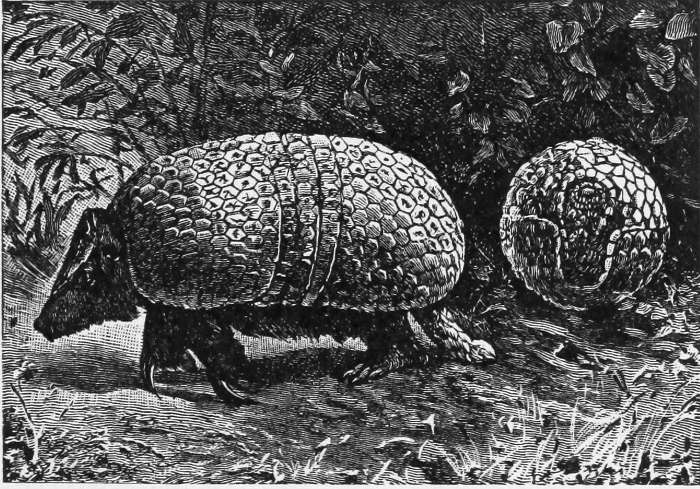
The Three-banded Armadillo. An Animal in a Coat of Mail
In the end he punished the armadillo by making a little wagon in which he made it draw the rat about as a passenger.
His armadillo, he tells us, was a famous sleeper, lying asleep about twenty-three hours out of the twenty-four. But in its wakeful hour it was very active and lively. It loved to lie before the fire, but if turned over on its back and scratched it[306] grew furious. It could not turn itself back again much easier than a turtle.
The one thing that threw it into a panic was a sudden noise. If, for instance, the poker was thrown down, the scared animal would make a bee-line for its home, and if it missed the mark would tumble around in a fright till it found the entrance to its cage. When it got used to the noise of the poker any other noise would set it off in the same way, and it never got over its panic at a strange and sudden noise.
So many kinds of animals have been tamed at times that I cannot speak of them all. But I must not forget our familiar little friend, the squirrel, one of the prettiest and liveliest of tree-dwellers. To see him seated, with bushy tail curled up over his back, and gnawing away at a nut held between his fore-paws, is to see one of nature's most charming sights. And he is a tameable little creature, easy to keep and to feed, and very pleasing in his ways.
There are many kinds of squirrels, but all of them may be tamed. They need a cage of good size, and a usual feature of the cage is a revolving wheel or cylinder of zinc wire, a sort of tread-mill in which the active little fellow may take all the exercise he wants, making it spin round at a great speed. He needs a snug little ante-room, to which he may retire when tired of his wheel. Any kind of nut will be welcome as food, and even a stale[307] crust of bread or a bit of boiled potato, all of which he will gnaw in his funny way.
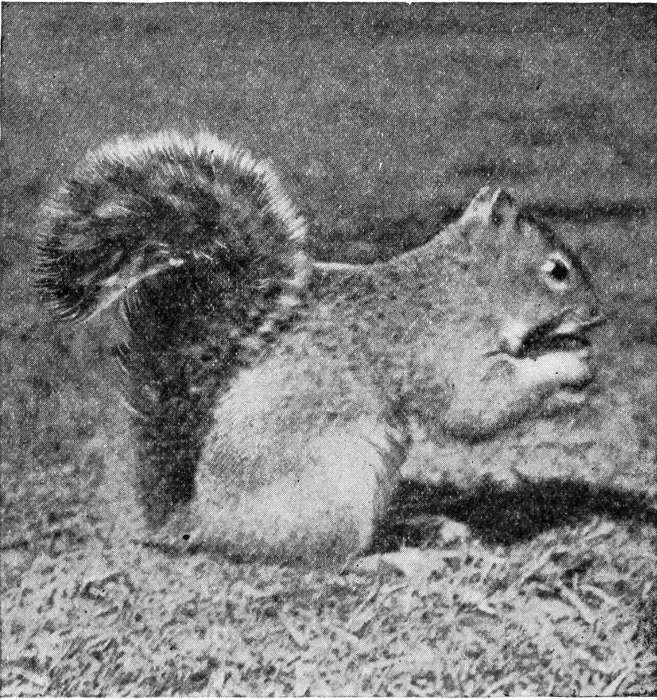
A Friendly Gray Squirrel
Many stories of tame squirrels could be told. Here is one which we owe to a Captain Brown. I give it both for its neatness and its odd ending.
It is of a tame squirrel that used to run up its master's leg and pop into his pocket whenever it saw him getting ready to go out. As he went[308] through the streets it would keep in his pocket, sticking its head out in a saucy way to took at people passing. As soon as the outskirts of the town were reached and trees and bushes became common, out of the pocket it would pop, down the leg it would scramble, and up the trees it would climb, nibbling away at the bark and leaves. If its master started on, down it would come and climb back to his pocket. If a cart or carriage came by it would hide till they had passed, for it was timid with any one but its master.
It was not a good friend with the house dog and this seems to have been bunny's fault, for he had a fashion of his own of teasing the dog. If it lay down and went off into a snooze, down would come the squirrel, scamper over its body, and dart off to its cage again before the dog had time to growl or snap.
This squirrel—or it may have been another squirrel which had the same fancy of hiding in its master's pocket—had one night an adventure in which it served its master as well as any watch-dog could have done. The gentleman who kept it used, when he came home at night, to hang his coat behind one of the downstairs doors. This made a neat sleeping place for the squirrel, who would climb up to the pocket, taking some tow with him for bedding.
One night, after the family and the squirrel alike had gone to bed, a burglar made his way into[309] the house and began to peer around for plunder. Seeing the coat hanging on the door, he began with that, putting his hand into the pocket. In an instant he drew it out again with a cry of pain. He had got a sudden bite from the squirrel's sharp teeth. At the noise the man of the house sprang up, seized a poker and ran down stairs. He was in time to capture the burglar, who was just climbing out of the window.
Perhaps you have read enough about tame animals of the four-footed kind. At any rate it will be well to turn now to the two-footed kind, the birds, and talk about a kind of sport in which birds have been used for many centuries. Nowadays, when one of us goes hunting, we take our shot-gun or rifle, with the dog for companion, and bring down the game with a bullet or load of shot. But long ago, before the gun was known, there was another way of catching game, and of this I wish to speak.
It is called Hawking or Falconry, and is a very old sport in which the falcon or the hawk was used to take game. It is still in use in some countries, but in old times falconry was the favorite sport of kings and nobles, many of whom spent much of their time in the field, hunting smaller or weaker birds by aid of the strong and swift falcon or hawk.
This kind of sport began very long ago, no one can say how long, it being common in Asia long before it was known in Europe. And it is common in some parts of Asia still.
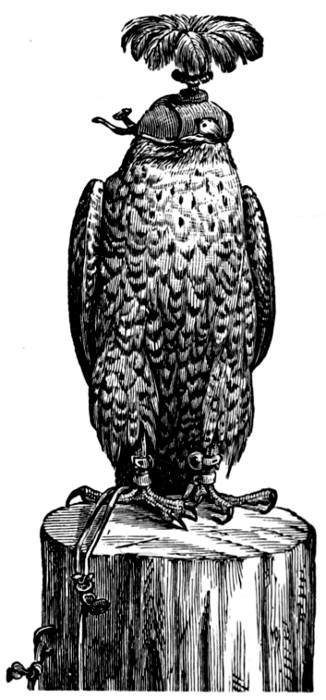
A Hooded Peregrine Falcon. Its eyes are covered by the hood until the game is in sight
Bishop Stanley says: "About two thousand years ago ancient writers speak of hawking as a common sport. People used to go out into the marshy grounds and beat among the reeds and bushes for small birds, and as these flew away hawks were let loose in pursuit, and when the game fell to the ground, either through fright or[311] struck by the hawks, men ran up and secured them.
"In China it is a favorite sport with some of the mandarins to hawk for butterflies and other large insects with birds trained for that particular pastime. In India the Goshawk and two other species are taught to keep hovering over the hunters' heads and when deer and other game start up, they dart down and fix their claws upon its head and thus bewilder it until it is secured. A certain sultan kept a corps of seven thousand falconers."
The Arabians used the falcon to hunt the goat. When a rock goat was seen on a mountain the falcon would be let loose and would fly like an arrow straight for the animal, lighting on its back and fixing its talons in its throat. It held fast until the huntsman came up to the weakened animal and cut its throat, the falcon being paid for its service by drinking the blood.
Falconry is still common in Persia and is much spoken of in the poetry and stories of the Persians. One of these stories is worth telling, both from its being a very pretty one and from its being like a famous story of ancient Wales. In the Welsh story, which we have in a fine ballad, Prince Llewellyn had a faithful dog named Gellert which he left in charge of his infant child. During the absence of the prince a wolf entered the house and was attacked and killed by the dog. When[312] he came home he saw the cradle upset and blood all over the floor, and thinking that the dog had killed his child he plunged his sword into its side. A minute later he saw the child safe under the cradle and the wolf lying dead. He was sorry enough when he saw this, but all he could do was to build a monument over his faithful dog.
Stories like this were common in the past, with other animals than the dog and the wolf. In old Persia it was the hawk and the snake. We are told of a Persian king who went out hunting with his favorite falcon on his wrist. After a time a deer started up and was pursued by the falcon, and was in time brought down and killed.
In chasing it, the king had left all his people in the rear and now found himself alone. He was also hot and thirsty and finding some water trickling down a mountain side, he filled his cup with it, but very slowly, as the water came down only in drops. He was about to drink it when the falcon struck the cup with its wings and spilt the water.
Vexed at this, the king filled the cup again and once more raised it to his lips. Again the falcon flapped its wings and the water was spilled. This made the king so angry that he flung the bird to the ground and killed it on the spot.
At this moment one of his attendants came up and the king, who was too thirsty to wait again until the cup was filled drop by drop, gave it to the man and told him to climb up and fill it at[313] the spring. The man did so, but as he came down he saw a large serpent lying dead with its head in the water, into which a poisonous foam flowed from its lips. When he came down and told of what he had seen the king was deeply grieved, for he had killed the faithful bird which was seeking to save him from death or danger.
Coming now to later times we find that hawking made its way from Asia into Europe very long ago. Denmark was a famous place for this sport in the far past and it was common in France and England at least as early as the 10th century. The kings of those countries grew very fond of it. When Edward III. of England went to fight in France he took with him thirty falconers and hunted or hawked every day, and Henry VIII. at one time nearly lost his life when out hawking. In recent times it has died away in great part, but is still practiced in some countries.
Such is the history of hawking. Now a few words may be said about the practice. The birds used belong to two classes, the long-winged, dark-eyed falcons and the short-winged, yellow-eyed hawks. The falcons used are the Gerfalcon, Peregrine, Hobby, Merlin, and some others. The hawks used are the Goshawk and the Sparrowhawk. The falcons take their prey by rising above it in the air and darting down upon it. The hawks fly in a straight line and take it by their great speed.
The taming of these birds is a slow process. It was of old the custom to fasten jesses or soft leather straps round their legs and hoods over their heads. A line fastened to the strap kept them from flying away. They were taught to rest and feed on the gloved hand of the trainer and also to make short flights to a "lure," a piece of wood on which food was placed. They were drawn back by the cord tied to the jesses. In this and other ways the birds were taught, and in time could be trusted to fly free and come back to the huntsman's hand.

Leg and Foot of Falcon Showing the Method of Attaching the Fastening
When the hawkers went abroad on a hunt, gay was the show and lively the sport. On horseback, carrying the hawks on their wrists, the gallant company rode briskly away, all of them dressed in fine robes and the hawks also richly "dressed." The bird might have around its neck a collar of gold filagree and over its head a hood of the finest silk, with a plume of colored feathers on top.[315] Little tinkling bells, those of finest sound, hung from the leather leg rings, and the glove on which the bird sat was often spangled with gold, and sometimes adorned with jewels.
While the hood was on the bird would not move, but when the hood was taken off and it saw the prey it was eager to fly. Here is the story of a hawking party as late as 1825. This party set out in the afternoon, riding towards a place frequented by herons—a large, strong bird with which only the strongest falcons could deal. There were four couples of birds, all of the kind known as Peregrine falcons. Each bird had a small bell on one leg and a leather hood, with pieces of red cloth in it to cover each eye.
After some time a heron was seen near at hand. At once the hoods were taken from the heads of two of the falcons and as soon as they had seen the bird they were let loose. Away they flew after the heron, but a crow chanced to cross their track and one of the birds started to chase this, while the other kept on.
When it came near the heron it flew in circles until it was far above it and at length came pouncing down and struck its prey on the back. Down came the two birds, tumbling from a high point to the ground. By this time the crow had escaped and the second falcon came flying up, just in time to see the other falcon and the heron falling. At this instant a rook flew across and the second bird[316] struck at him, bringing him to the ground not far away from the other game.
Up now dashed the falconers, held out the lure, on which was a live pigeon, and secured the game while the birds were making a meal upon the pigeon. Two other herons were taken by the other falcons and the day's sport closed. Such was a scene of hawking in the 19th century. In olden times the game was often much more exciting than this.

You must by this time think that there is hardly any kind of animal upon the earth that man has not at some time kept as a friend or a captive. Of course, we mean the larger animals, the quadrupeds, reptiles, birds, and fishes, not the vast hordes of insects and the still lower animals. Of these there is only one, the honey-seeking bee, that has been made to work for man, but of the large animals many more than those spoken of have served him in some way or have been captured and caged for his pleasure.
All the large cities have their Zoölogical gardens, where wild beasts of many kinds are kept on show, and in villages and small towns and cities the travelling menagerie carries such wild creatures around where everyone may see them.
Here, in strong cages, we may look at the lordly lion, with its splendid mane, and its gaping jaws, filled with cruel teeth, and the tiger, fierce and sly, pacing round and round its narrow cage on silent feet, and at times stopping to glare with savage eyes at the lookers outside. It may have seen and made a meal on such beings in its native wilds.
Then there are the snarling hyena, the spotted leopard, the wild-eyed wolf, the American panther and wild-cat, the growling bear, and many others. Greatest among these are the huge and savage rhinoceros, the ugly river-horse, or hippopotamus, and the noble elephant.
These are only a few of the animals that are kept for show, among them many of the tameable ones, as the playful monkey, the slender deer or antelope, the large elk and moose, the wolf, raccoon, opossum, kangaroo and many others of the smaller animals.
Man is able to make friends of the most of these. In fact there are daring men and women who are ready to go into the cages of the fiercest of these beasts and make them go through the tricks they have been taught. They have been even found bold enough to put their heads into the lion's mouth. This is always a foolish thing to do, and sometimes it has ended in the lion's closing his great jaws and smashing the man's head as one would smash an egg-shell.
With all this we are not here concerned. It is only the animals that serve us as friends and helpers that we are dealing with. But man at times makes use of certain creatures that usually are only seen in a wild state, so it is well to say something of the wild animals that at times are made to serve us in some way.
You have seen, no doubt, the dancing bears, clumsy, ugly brutes that men lead around the country, visiting the summer resorts, and making the animals go through some awkward movements on their hind legs, which they call dancing.
This is not a sign of any great sense in the bear. To get up on his hind legs is a common habit of this lumbering fellow. Many hunters who have made the bear angry have found this to be the case. When it wants to fight up comes the bear on its hind feet. It is not like a prize fighter, using its fore-legs to spar with; though it can strike a blow that will hurl the strongest man to the ground. But what it tries to do is to get its fore-legs round the man and give him a hug. When a bear hugs, he means business. It is not a tender embrace, but a bone-cracker that few men can stand.
The bear is an easy animal to tame. The common brown bear I mean, not the savage grizzly bear, which no one would think of trying to tame, except when young. When a bear is tamed it shows itself a docile animal that will not hurt any one who treats it well.
As for the learned bears, their learning does not amount to much. It takes no special teaching to get them on their hind legs or to prance around in a clumsy fashion. Yet the bear is not wanting[320] in brain powers. It is really an animal of much intelligence and very teachable.

Grizzly Bear Cub. The Young of all Animals, Even of the Fierce Grizzly, can be Tamed by Kindness
It shows this in various ways. I have told you how the elephant gets hold of a piece of food by blowing back of it with his trunk, and how the monkey does the same thing by throwing his shawl over it and drawing it in. The bear has a[321] way of his own of doing the same thing, as the following anecdote will show:
It is the story of a bear at the Zoo, to which some one threw a bun. The bun fell into the bear's bathing pool, out of his reach. The animal could have got it easily by going into the water, but did not just then want to wet his feet and in his wise head thought out another plan. He put his paw into the water and began stirring it up till he had a sort of current going round the pond. When one leg was tired he put in the other, moving it in the same direction, and kept this up till the bun came swimming round within reach.
There are other stories of the same kind and they go to show that the bear has good thinking powers. He certainly knew that by making a current in the water he could cause the bun to float up within reach of his paws. It is not likely that this bear had ever done the thing before or seen it done, so he had to think it out for himself.
There is a very interesting thing to say about wild animals which will fit in well at this point. As a rule they only want to be let alone, and if man would quit hunting them many of them would become as tame as the cows and sheep in our fields. There is much proof of this, some of it very late proof.
After the Yellowstone National Park was set aside as a national pleasure ground orders were given that none of the wild animals of the park[322] should be shot. You may think that these wild creatures could not find this out, but they soon did. Thus we are told that the elks, the great deer of the mountains, are very alert and timid outside the park boundary, but when they have crossed this and come into the park they grow very bold and independent. They have learned that the crack of the gun which means death on one side of the border is not heard on the other, and have taken in this lesson.
As for the bears, they are fearless of man when inside the park, and come up close to the hotels and other buildings as if they looked upon these as part of their lunch route. It is the same with the other wild animals. They seem to know.
We hear of the same thing from East Africa. No one can shoot at game within a certain distance on each side of the East African Railway. That is the law and the wild beasts have come to know it. Travellers on that road tell us that crowds of wild animals can be seen on both sides of the road, antelopes, zebras, ostriches, deer, and the like, looking with curious eyes as the train goes by but not trying to get away.
This was not the case in the past, when people could shoot at them from the train. No one has posted up a bulletin in beast language telling that a treaty of peace had been signed between man and beast. But there stands the fact. These innocent creatures have lost all their old fear of[323] the railway train. They seem to have told one another.
This is not the case with such dangerous brutes as the lion, the leopard, the hyena and the rhinoceros. These do not come within the terms of the treaty of peace. Travellers are free to shoot at them. As a result you do not see them among the animals that welcome the train.
So far we have been talking of land animals, those that live, eat and breathe on solid ground. If we turn to the sea, we find it the native abode of the fish and of many animals lower than fish in nature's great family. And it is of interest to find that some land animals have gone back to the great world of waters, part of them to live there all the time, part to share their time between land and sea.
Among the first of these is the mighty whale, much the largest of living beings; also the porpoise, the dolphin, and other air-breathers that live in the ocean. Chief among those that spend their lives in part on the land are the seals. And these are the only animals of the land-sea kind that have ever been tamed, so we must say a few words about the seal.
There are many kinds of seals, some of them, like the sea-elephant of the southern seas, being very large. Others are small. All are splendid[324] swimmers, their arms and hands acting as fins or oars, with which they can make their way very swiftly through the water. The ocean is their dining hall, in which a great dish of fish is ever ready for them, but their home is on island shores, where their young are born and brought up till they are able to swim.
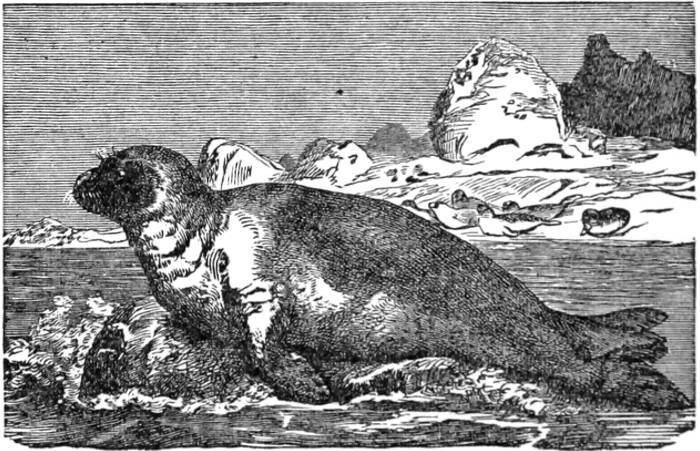
The Harp-seal Afloat on the Ice
The kind of seal to be talked of here is that known as the Common Seal. This is the easiest to tame. It is found in the Arctic seas and comes down the coasts of Europe as far south as the Mediterranean and the coasts of America as far south as New Jersey.
This little fellow, along with some other species, is very intelligent. Where they are not hunted they will come very close to boats and to men on shore. They have a fondness for music and will follow a boat for miles if a flute or some other instrument is played. The ringing of the church[325]bell of the little town of Hoy, in the Orkney Islands, has often brought a great many seals into the bay, drawn there by the bell tones.
Seals that have been taken and tamed are very gentle and docile, and will live long if they have water to bathe and swim in, and fish to eat. They like to be taken notice of and caressed, come like dogs when their names are called, and can be easily taught many little tricks, so that learned seals are often put on exhibition.
When taken young and brought up in a household the seal acts as if it felt itself to be one of the family, and likes much to lie and warm itself in front of the fire. It grows very fond of those who care for it, showing a tender and loving nature.
We are told of one that would follow its master about like a dog, eating from his hand and lying by his side when he sat before the kitchen fire. It would also nestle close to the dog, with which it had made friends. When anyone came into the room, up would go its head to see who the newcomer was. But it never tried to bite dog or stranger.
The winter after this young seal was taken was cold and stormy, so that it was not easy to catch fish enough to feed the family and the seal. They tried giving it milk, but it took so much of this that in the end the family could not afford to keep it and decided to set it free and let it fish for itself.
Taking the little thing—it was very young—into a boat, they rowed out to sea, and when far enough from land tossed it overboard. But they were not going to get rid of their pet seal so easily as this. It swam after the boat, crying in so pitiful a way that they could not bear the tone and in the end took it on board again. Thus it was brought back to the house and lived there several months more before it took sick and died.
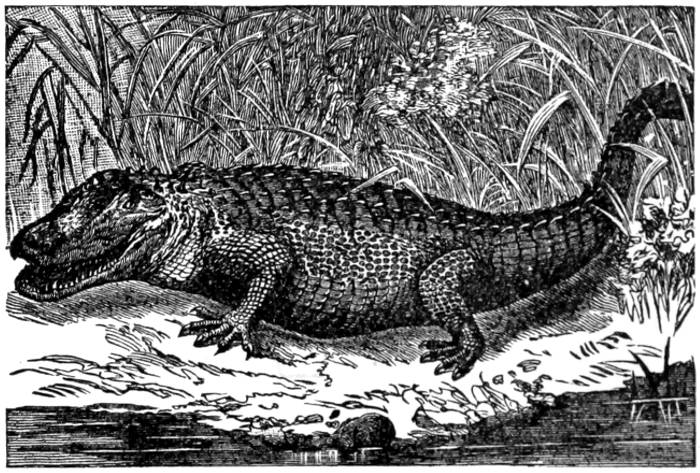
The Savage Florida Alligator
There is a story very like this of another seal that its owners tried several times to get rid of. They failed to do so, the knowing creature always finding its way back. At one time it even crept into the room through an open window and made its way up to bask by the fireside.
While it is not strange that the seal can be easily tamed, we should not look for such a thing in so savage an animal as the alligator, the most[327] feared and hated of the animals found in the waters of our Southern States. Yet even this ferocious reptile can be tamed, as the following story will show.
The alligator in question was taken when very young, before its wild nature had shown itself, and was fed and attended to by its master, of whom it became very fond. It grew so tame that it would follow him about the house like a dog, even scrambling up and down stairs after him.
But the funny thing about this comical pet was that its chief friend was the cat, and that pussy returned its friendship. When the cat lay drowsing before the fire, the alligator would crawl up, lay its head on her back, and go to sleep in this position. It seemed happy whenever the cat was near, but grew very restless if its furry friend was away.
Raw flesh was fed to it and sometimes milk, which it liked very much. At night, in cold weather, it slept in a box, with wool for it to nestle in. But one night there came a sharp frost and the little guest was forgotten. The next morning the native of warm climates was found frozen to death.
It would take many pages to tell about all the wild animals that have at times been tamed by man or made to serve him in various ways. As[328] it is, we must confine ourselves to a few, and have selected the three water-birds named above all of which have been of service to man in some way.
The Stork is not a tame bird in the sense of being kept about the household, but it has so long been taken care of and laws made to protect it, that it has grown very familiar and may be seen walking about the streets of Holland, even among crowds of people, without a show of fear. No one wants it for food, for its flesh is not good, and it does so much service by eating frogs, snakes and other troublesome animals, that every one feels friendly towards it.
It also struts about in the market places and keeps them clean and fresh by eating all the offal. Thus it plays the part of the turkey-buzzard of our Southern cities, which is taken care of for the same reason.
The Common Stork of the Old World countries is a large bird, long-legged and long-necked. It is pure white in color, except that the wings are partly black and the bill and legs are red. It sleeps standing on one leg, with the neck folded and the head turned back on the shoulders. If alarmed, as when a dog comes near, it makes a loud snapping noise with its bill.
The stork spends the winter in Africa and flies back in the summer to Europe, where it is very common in Holland and North Germany. Its feeding place is in the marshes, where it wades[329] about, eating the frogs and other small animals to be found there. It is very fond of eels and will follow people about the streets who feed it on this favorite morsel. It has a way of asking for food by nodding its head, flapping its wings, and blowing the air from its lungs.
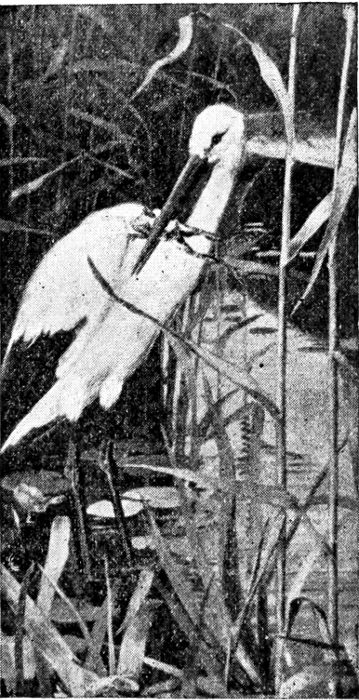
The Stork in its Feeding Grounds
Of a mild and peaceful disposition, the stork has long been much cared for and a halo of romance clings round it, coming down from ancient times. This arises from its devotion to its young, which brings it into esteem in various countries.[330] It builds its nest on the roofs or chimneys of houses or the steeples of churches, the nest being a bunch of sticks, reeds and other debris. In the ruined cities of Asia a stork's nest may be seen on the top of nearly every standing pillar.
In Holland and many other parts of Europe it is common to put a box on the roof for the stork, and when the inmates find that a stork has built in their box they are glad, for they think it will bring good luck to the family. When a new baby comes to the household, children are told that the stork has brought it out of the well, and thus the young grow to like the stork. Four or five eggs are laid in the stork's nest, of white color tinged with buff, and the birds are apt to come back to the same nest year after year.
The stork not only shows great fondness for its young, but is also thought to take much care of its aged parents. Whether this is true or not, it adds to the affection people have for this bird. When the summer is over and it is time to fly south, the birds gather in large flocks as if to talk the matter over. The stork, indeed, has no voice, but it makes a great clatter with its bill. The meeting over, the flock flies off for the far-away tropics, the birds rising very high and making a loud rushing noise with their wings. They are gone, to be seen no more until the next summer is at hand.
Now let us take up the story of the Cormorant,[331] one of the web-footed swimming and fishing birds, of which so many kinds dwell about the waters of the world. They belong to the same family as the pelicans, but while the pelican has a great net, or fish basket, under its lower bill, the cormorant has only a small one, not big enough to hold many fish.
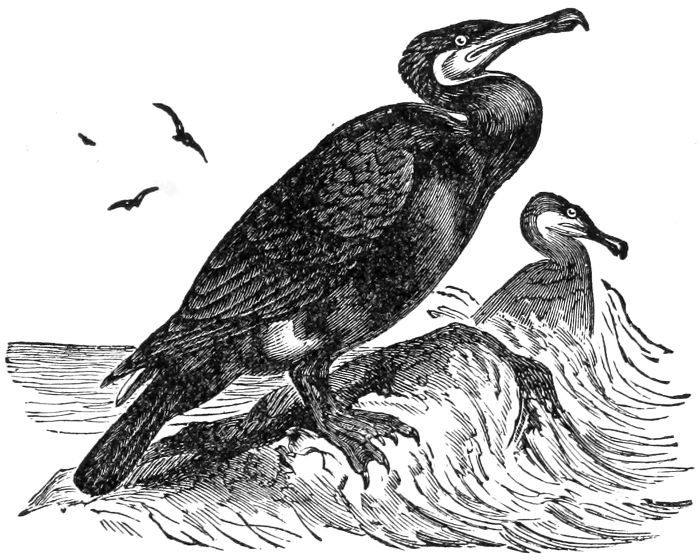
The Cormorant, the Fishing Bird of China
The cormorants are great fish-eaters, so much so that it is common to call any large eater a cormorant. There are many species, some small, some large, living on the shores of islands and in some cases along rivers.
The way in which this bird is of service to man is in its being tamed and trained to catch fish for him. This used to be done in England and is still done in China. How it is done may be told in a few words.
The bird is easily tamed by the Chinese fishermen and is trained by them for its new duty. While being trained a string is tied to its leg so as to control its movements. Then small fish are thrown out and it springs after them. In time it learns to go into the water when a whistle is given and to come back when it hears a different whistle. After three or four weeks of this training the bird is ready for duty and no longer needs a string to hold it.
The birds become in time as docile as dogs and obey every order of their masters. When put regularly to work a small ring of hemp is tied around their throats, so that they cannot swallow large fish. When the fisherman rows out into the water the birds sit quietly on the side of the boat until they get his orders. Then into the water they dash and usually come up with a fish, which they bring to him.
If one comes up with a fish too large to handle, another bird, sometimes several birds, will come to his aid and help him to land the prize. Sometimes one of them takes a lazy fit and swims about the water, paying no heed to business. Then the fisherman shouts at the idle bird and strikes the water with his oar, keeping this up till it dives for prey.
At the end of the day's work the ring on the bird's neck is loosened or taken off and some of the fish are given it or it is allowed to fish for itself.[333] Like the stork, the cormorant is very fond of eels, and when one of them comes up with an eel there is often a fight between two or three of them for the prize.
There is another bird on our list, the Albatross. It has never been tamed and cannot be said to be of service to man. At least I can name only one instance. In this case the bird is said to have been used to carry a message from shipwrecked sailors, telling where they could be found and asking for help. I cannot say whether this story is true or not, but it leads us to say something about this famous bird of the waves.

The Albatross swooping over the ocean waves
The albatross is a wonderful flyer. It is the largest of the web-footed birds, being four feet long and with a wing spread of from ten to seventeen feet. It seems to float or glide on the air[334] rather than fly, hardly moving its long wings except when rising from the water.
It often follows ships for a long time; day after day, some people say, but this is doubtful. No ship can outsail it and it is said to be able to fly as much as eight hundred miles in a day. Sailors often fish for it with a baited hook, but find it hard to haul in, as it often draws out the hook or breaks the line. But a bait of blubber is very attractive and in a few minutes the same bird will take the hook again. Only by catching a fish in some such way as this could a message tied to its legs by shipwrecked sailors be found.
Sailors have long had a superstition about shooting the albatross, fearing that it would bring ill luck to the ship and its crew. All who can do so would do well to read Coleridge's famous poem of the "Ancient Mariner," in which the men who "shot the albatross" brought terrible misfortune to the ship and all on board.
There is only one other animal of which I shall speak as a servant or aid of man, this time an insect, the well-known hive bee, which every one of you must have seen, and like enough many of you may have felt, for this little fellow has a very "hot foot."
The bee cannot be called a tame animal. Although it lives with man and under his care, it[335] does not know this but fancies that it is working for itself alone. And the honey which man gets from it is laid up by the busy bee for its own use. It has no notion of working for man, but is robbed by him of its sweet stores.
Among all the wild animals that are of service to man this little humming insect stands first. Nimble, active, always at work, always singing over its work, the happiest of the working class, it keeps itself busy through all the season of flowers in gathering honey from their cups and carrying it to store away in its neat cells of wax. It is a winter store of food it is laying up. By good fortune the bees are able to collect more than they need for their own use, so their keepers can take part of it and still leave the little workers enough to live on the winter through.
The bee has been working in this way for man during long ages. Go far back in time and you will find writers telling about the bees and their ways. The Greek and Roman writers tell us much about them,—some of it fancy, some of it fact,—and within later times these useful insects have been much studied and written about.
I do not propose to tell the story of the bee, for it is much too long a one to be given in this place. All I need speak of here is the service it renders to man. There are many varieties of bees but only one, the hive bee, is of interest to us in this story, for it is the only one that works for us.
What we do for the bee is to supply it a home to live in, a cage or hive in which it may dwell, take care of its young, and lay up a store of its sweet food. How all this is done is very interesting. There is nothing in nature more neatly built than the waxen comb of the bee, and no prettier dish for our tables than a comb full of the golden honey. And there is nothing which most of us like better to eat. So it is the comb of the bee that I shall speak of here, rather than the bee itself.
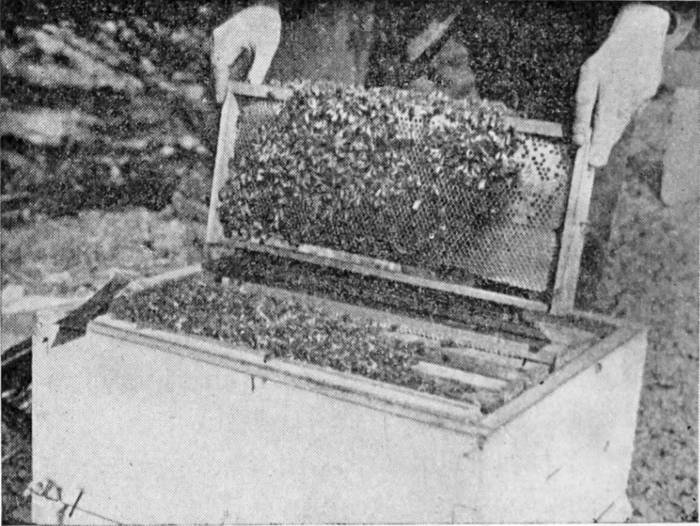
An Opened Bee Hive Showing the Clustering Bees
The bee goes abroad for honey, but the wax which it uses for the comb is formed in its own body. It comes out from a sort of wax-pocket in the lower part of the body, is scraped up by[337] the legs and carried to the mouth. Here it is well chewed and then laid on the floor for the use of the comb-builders.
From this wax the bees build a series of six-sided cells, laid side by side, some of them to hold honey, others as cradles for the young. They are fastened to the walls and hang downward. It is well to say here that there is only one egg-layer in the hive. This is called the queen bee. The others are workers and drones. The workers store up food, the drones (the male bees) do nothing but eat it. This the workers let them do while the summer lasts and food is plenty, but they do not let them spend the winter in the hive, eating the food which they have not helped to gather. When the summer season is over they drive the drones from the hive and sting them to death.
Is there a lesson for us in this habit of the bees? They have no room in the hives for those who do no work, and kill them on the spot rather than let them starve or freeze. While we could not do a thing like this, it might be well if everybody was made to work for the food they eat, as the bees do.
Now let us come back to the waxen cells, built so neatly and packed into the hive so closely that no man could do it better. Some of these, as I have said, are cradles for the young; some are store-houses for food. The queen bee is a wonderful egg layer. For every egg laid by the hen she[338] will lay several hundred, each in a cell of its own. From the egg comes a little maggot, which feeds on the honey and pollen given it till it swells into a fat little worm. Then it builds around itself a cocoon of fine silk, in which it lies hid while it is going through the process of changing from a worm into a bee. In the end it comes out a winged insect, ready to take its part in the business of the hive.
Egg-laying is the work of the queen; food gathering is that of the workers. As soon as warm weather comes and blossoms open on bushes and trees, the bees may be seen at work, visiting flower after flower and sucking up by aid of the tongue the sweet juice to be found in so many flower cups. This is partly used for food, but much of it is stored in the honey bag of the bee to be carried to the hive and laid away in the honey cells.
As the season goes on new plants bear blossoms, so that all through the blossom season the busy bees find plenty of their sweet food. Another thing they collect is the pollen of the flowers. This clings to the hairs of the body while they are at work in the blossoms, and is cleaned off by the jaws and feet, a little honey being mixed with it. In this way little pellets are formed which are used as food for the young. On this rich food the little ones soon grow fat.
Another thing gathered by the bee is a sticky substance called propolis. It is used as a cement,[339] to varnish the combs and stop up all holes. The bees carry this home on their legs and the workers in the hive clean it off and use it while it is soft to cover up all weak spots.
I have said that the wax is formed in the body of the bee. The same may be said of the poison. This flows into the sting, and by its aid the bee is able to defend itself, not only against its natural enemies, but against artificial ones, like meddlesome boys. But the sting is barbed, so that the bee often fails to draw it back after using it. Thus the sting is pulled from the body and the bee dies from the wound.
For long ages men have kept bees, making hives for them. Every season new swarms come from the old hives and are brought in various ways to start fresh colonies in new ones. Hives have been made of many things, often of straw, which was long used in England. To get the honey from these the bees were first killed by the fumes of sulphur. It seems a cruel thing to kill them in order to rob them, and it is not now done.
In our country the straw hive has never been used. The hives now in use have frames on which combs may be built and filled with honey and then drawn out, leaving the lower combs for the bees' own use. There is a process by which the honey can be drawn from the combs without breaking them in any way, so that they may be filled again by the bees. As in this case they do not have to[340] make new combs the active insects can soon fill the old ones again.
Little more remains to be said. There are certain flowers which yield honey of fine flavor, such as those of the heather, the white clover, the buckwheat, the rosemary and the orange-flower. In ancient times the most famous honey was that of Mount Hybla in Sicily and Mount Hymettus in Greece. In our own days the countries in which bee-farming is carried on most largely are the United States and Canada, and of this country, Southern California is the paradise of the beekeeper.
On some bee farms are from two thousand to three thousand hives and it is said that as much as seven hundred pounds of honey have been taken from one hive. Thus this little buzzing insect is one of the most active and able of the animals that help to feed and serve us, and with the busy bee we may close our list of man's Animal Friends and Helpers.

A
B
C
D
E
F
G
H
I
J
K
L
M
N
O
P
Q
R
S
T
W
Y
Z
Transcriber's Note:
Spelling and punctuation errors have been silently corrected.